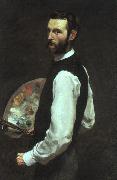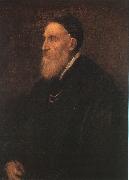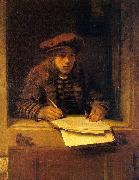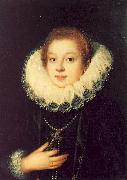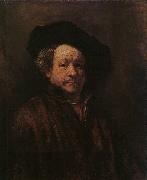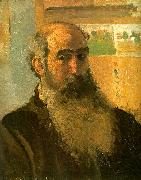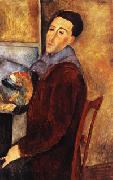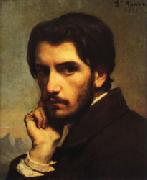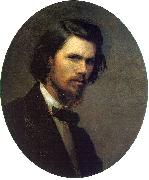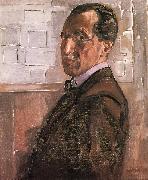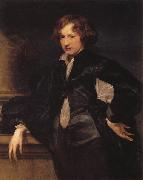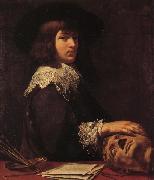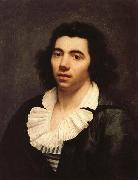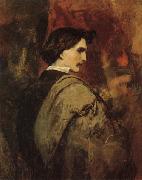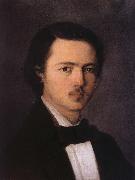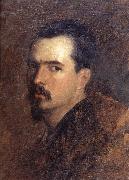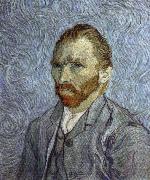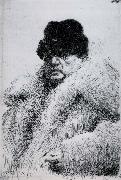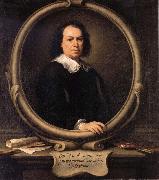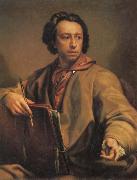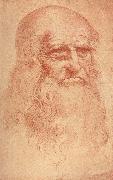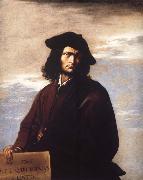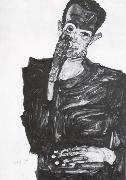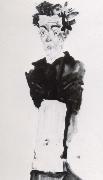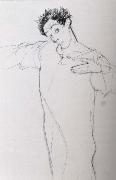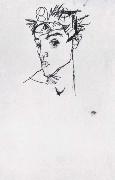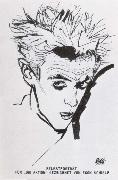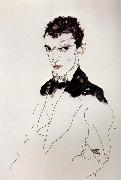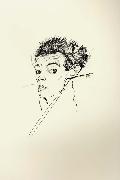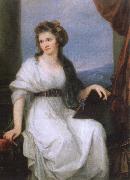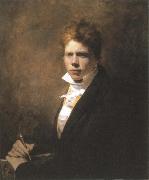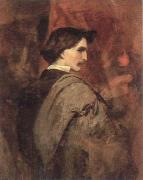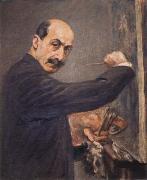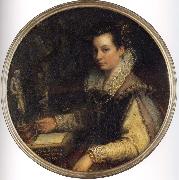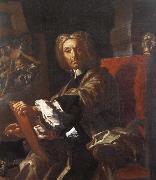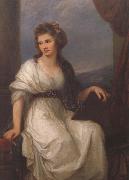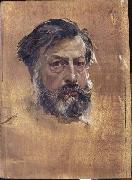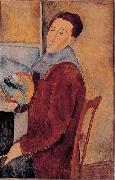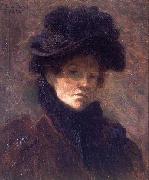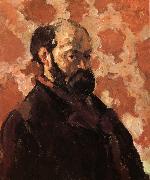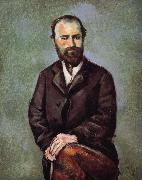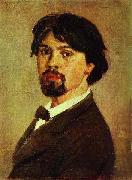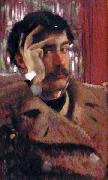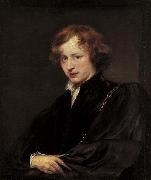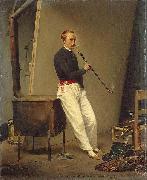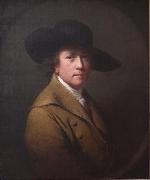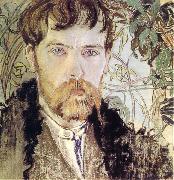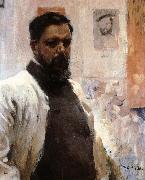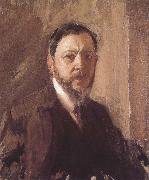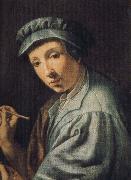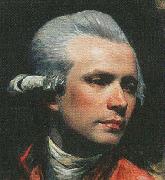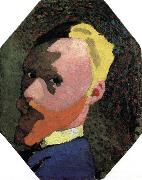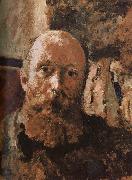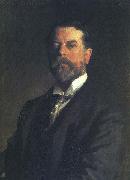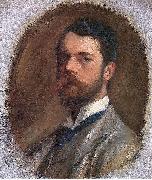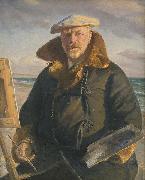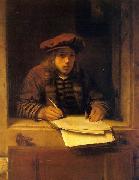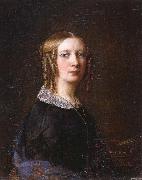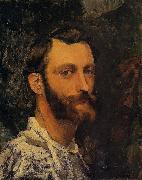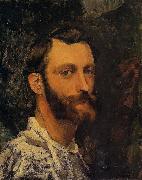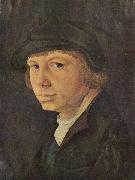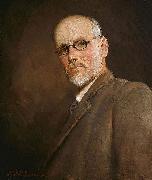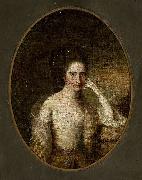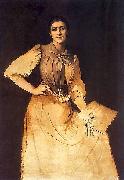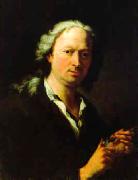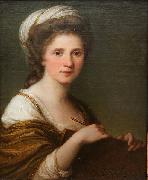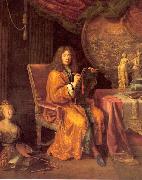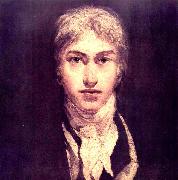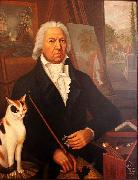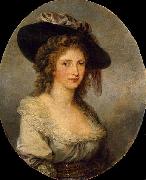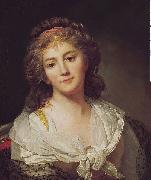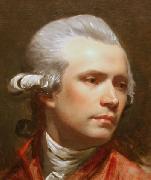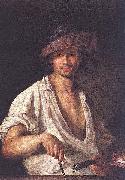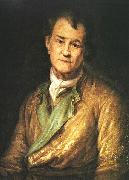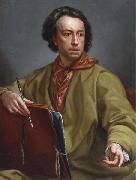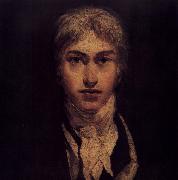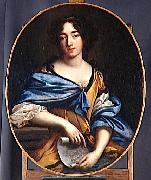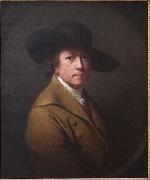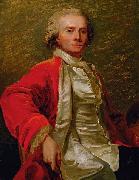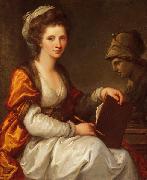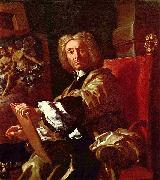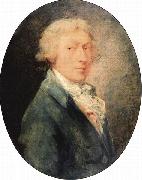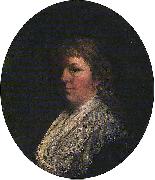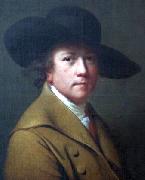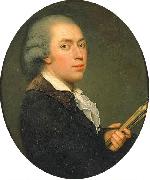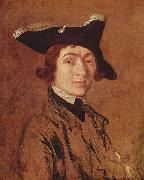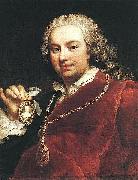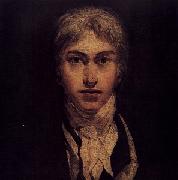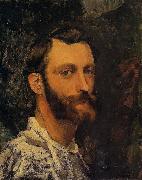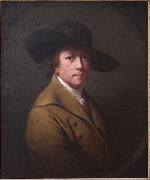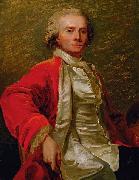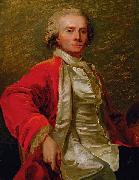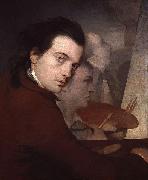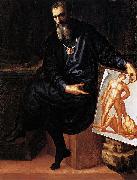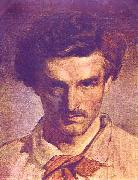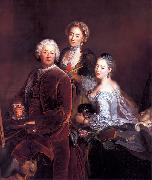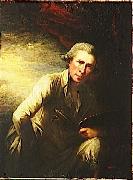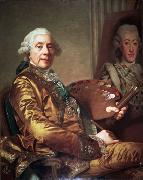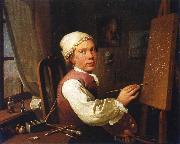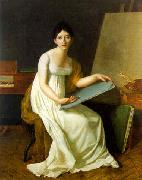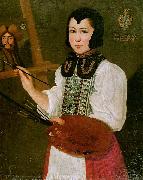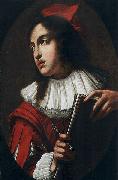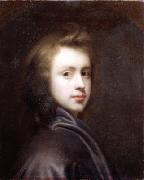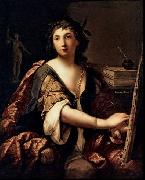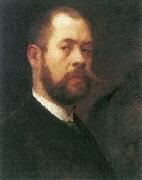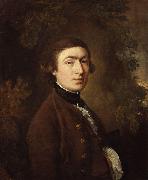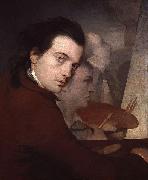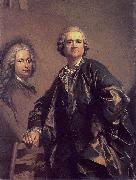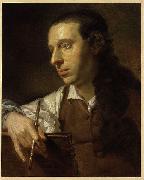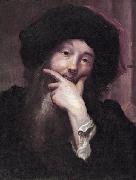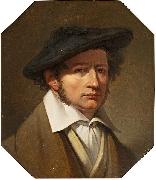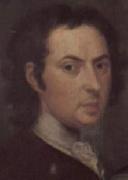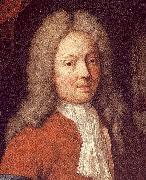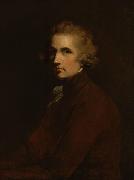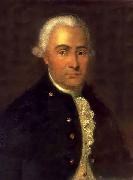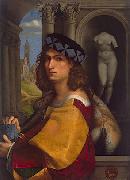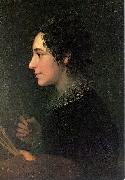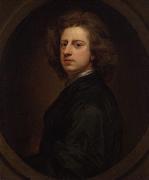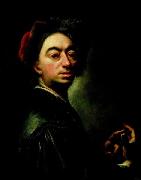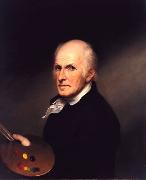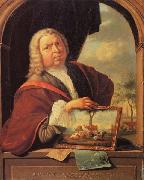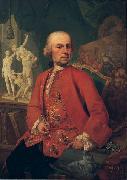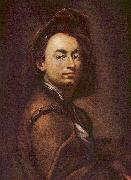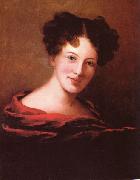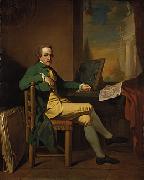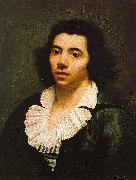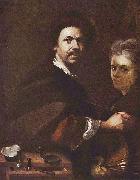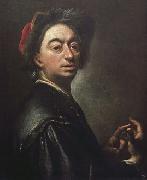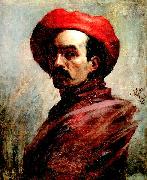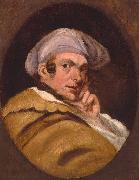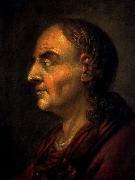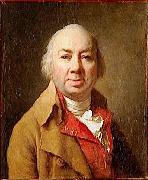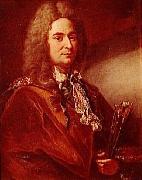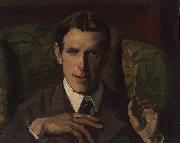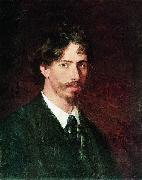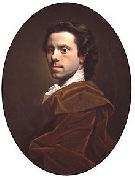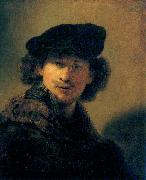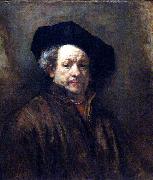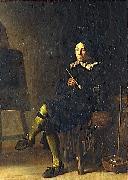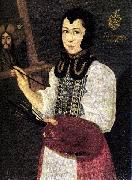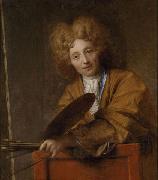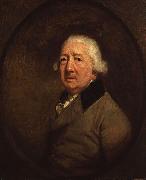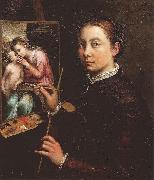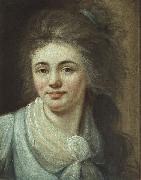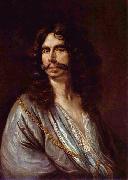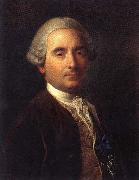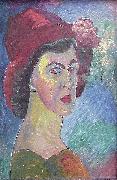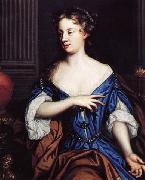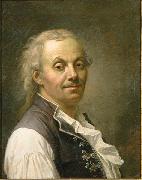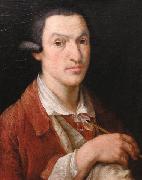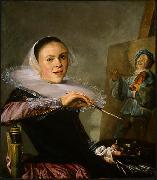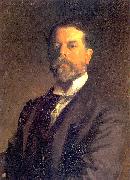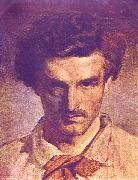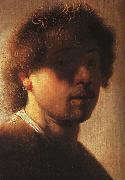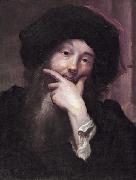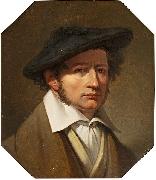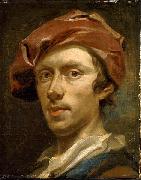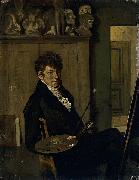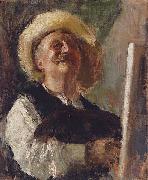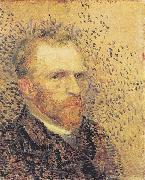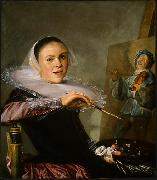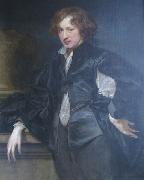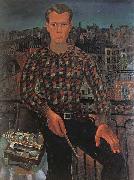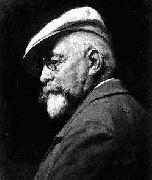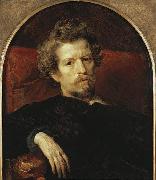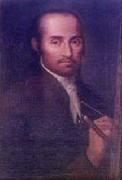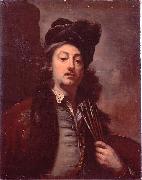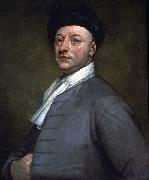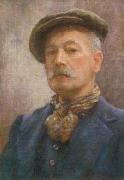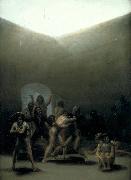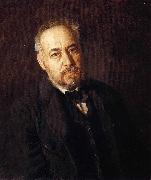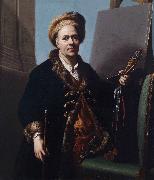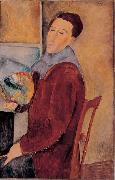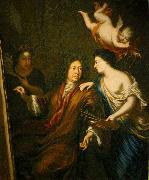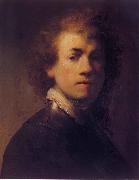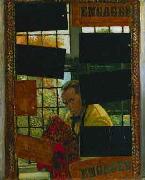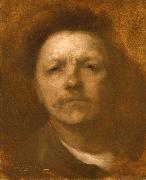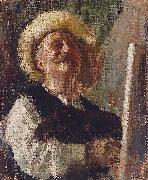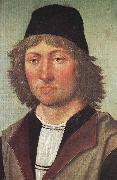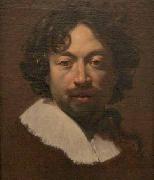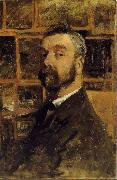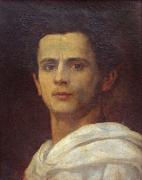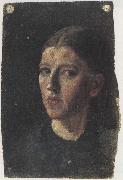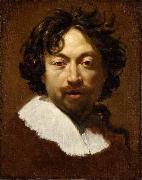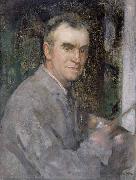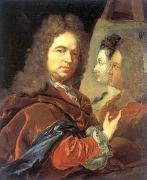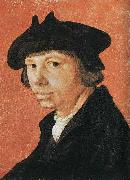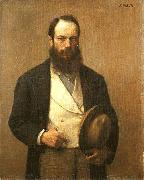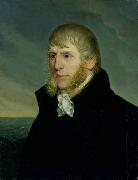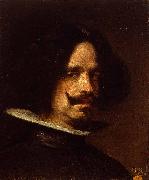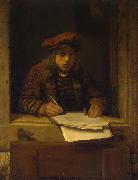Wholesale Oil Painting Reproductions No Minimum and Door to Door! |
|||||||||||
|
|
|||||||||||

|
|||||||||||
|
|
|
||||||||
All Frederic Bazille Oil Paintings |
||||||||
|
|
||||||||
|
|
||||||||
|
Artist Introduction: b.Dec. 6, 1841, Montpellier, France
d.Nov. 28, 1870, Beaune-la-Rolande
French
Frederic Bazille Galleries
was a French Impressionist painter best known for his depiction of figures.
Born in Montpellier, Herault, Languedoc-Roussillon, into a middle-class Protestant family, Bazille became interested in painting after seeing some works of Eugene Delacroix. His family agreed to let him study painting, but only if he also studied medicine.
Bazille began studying medicine in 1859. He moved to Paris in 1862 to continue his studies. There he met Pierre-Auguste Renoir, was drawn to Impressionist painting, and began taking classes in Charles Gleyres studio. After failing his medical exam in 1864, he began painting full-time. His close friends included Claude Monet, Alfred Sisley, and Édouard Manet. Born to a wealthy family, Bazille helped support some of these artists by giving them space in his studio and materials to use.
Bazille was just twenty-three years old when he painted several famous works, including The Pink Dress. His best known painting is Family Reunion (1867?C1868). |
||||||||
|
|
||||||||
|
Self Portrait Painting ID:: 34 |
1865-66
The Art Institute of Chicago |
|||||||
Height Width |
INS/CM Quality |
|||||||
|
X |
| |||||||
|
|
||||||||
All Titian Oil Paintings |
||||||||
|
|
||||||||
|
|
||||||||
|
Artist Introduction: |
||||||||
|
|
||||||||
|
|
Self Portrait Painting ID:: 1697 |
1567-68
Museo del Prado, Madrid |
||||||
Height Width |
INS/CM Quality |
|||||||
|
X |
| |||||||
|
|
||||||||
All Samuel Dircksz van Hoogstraten Oil Paintings |
||||||||
|
|
||||||||
|
|
||||||||
|
Artist Introduction: 1627-1678
Flemish Samuel Dircksz Van Hoogstraten Galleries |
||||||||
|
|
||||||||
|
|
Self Portrait Painting ID:: 2412 |
The Hermitage, St.Petersburg |
||||||
Height Width |
INS/CM Quality |
|||||||
|
X |
| |||||||
|
|
||||||||
All Sofonisba Anguissola Oil Paintings |
||||||||
|
|
||||||||
|
|
||||||||
|
Artist Introduction: Italian
1532-1625
Sofonisba Anguissola was born in Cremona, Lombardy around 1532, the oldest of seven children, six of whom were daughters. Her father, Amilcare Anguissola, was a member of the Genoese minor nobility. Sofonisba's mother, Bianca Ponzone, was also of an affluent family of noble background. Her mother died when Sofonisba was four or five.
Over four generations, the Anguissola family had a strong connection to ancient Carthaginian history and they named their offspring after the great general Hannibal, thus the first daughter was named after the tragic Carthaginian figure Sophonisba.
Amilcare Anguissola encouraged all of his daughters (Sofonisba, Elena, Lucia, Europa, Minerva and Anna Maria) to cultivate and perfect their talents. Four of the sisters (Elena, Lucia, Europa and Anna Maria) became painters, but Sofonisba was by far the most accomplished and renowned. Elena became a nun (Sofonisba painted a portrait of her) and had to quit painting. Both Anna Maria and Europa gave up art upon marrying, while Lucia Anguissola, the best painter of Sophonisba's sisters, died young. The other sister, Minerva, became a writer and Latin scholar. Asdrubale, Sophonisba's brother, studied music and Latin but not painting.
Self-portrait, 1554Her aristocratic father made sure that Sofonisba and her sisters received a well-rounded education that included the fine arts. Anguissola was fourteen years old when her father sent her with her sister Elena to study with Bernardino Campi, a respected portrait and religious painter of the Lombard school, also from Cremona, Sofonisba's home town. When Campi moved to another city, Sofonisba continued her studies with the painter Bernardino Gatti (known as Il Sojaro). Sofonisba's apprenticeship with local painters set a precedent for women to be accepted as students of art.[citation needed] Dates are uncertain, but Anguissola probably continued her studies under Gatti for about three years(1551-1553).
Sophonisba's most important early work is Bernardino Campi Painting Sofonisba Anguissola (c 1550 Pinacoteca Nazionale, Siena). The double portrait depicts her art teacher in the act of painting a portrait of her.
In 1554, at age twenty-two, Sofonisba traveled to Rome, where she spent her time sketching various scenes and people. While in Rome, she met Michelangelo through the help of another painter who knew her work well. Meeting Michelangelo was a great honor for Sofonisba and she had the benefit of being informally trained by the great master.
Lucia, Minerva and Europa Anguissola Playing Chess, 1555. Museum Navrodwe, Poznan, Poland.When he made a request for her to draw a weeping boy, Sofonisba drew 'Child bitten by a crab' and sent it back to Michelangelo, who immediately recognized her talent (this sketch would continue to be discussed and copied for the next fifty years among artists and the aristocracy)
Michelangelo subsequently gave Anguissola sketches from his notebooks to draw in her own style and offered advice on the results. For at least two years Sofonisba continued this informal study, receiving substantial guidance from Michelangelo.
|
||||||||
|
|
||||||||
|
|
Self Portrait Painting ID:: 3261 |
|
||||||
Height Width |
INS/CM Quality |
|||||||
|
X |
| |||||||
|
|
||||||||
All Rembrandt Oil Paintings |
||||||||
|
|
||||||||
|
|
||||||||
|
Artist Introduction: |
||||||||
|
|
||||||||
|
|
Self Portrait Painting ID:: 3392 |
1660
Metropolitan Museum of Art, New York |
||||||
Height Width |
INS/CM Quality |
|||||||
|
X |
| |||||||
|
|
||||||||
All Chaim Soutine Oil Paintings |
||||||||
|
|
||||||||
|
|
||||||||
|
Artist Introduction: Chaim Soutine Art Locations
Lithuanian 1893-1943
Soutine was born in Smilavichy near Minsk, Belarus (then part of the Russian Empire). He was the tenth of eleven children.
From 1910?C1913 he studied in Vilnius at the Vilna Academy of Fine Arts. In 1913, with his friends Pinchus Kremegne and Michel Kikoine, he emigrated to Paris, where he studied at the Ecole des Beaux-Arts under Fernand Cormon. He soon developed a highly personal vision and painting technique.
For a time, he and his friends lived at La Ruche, a residence for struggling artists in Montparnasse, where he became friends with Amedeo Modigliani. Modigliani painted Soutine's portrait several times, most famously in 1917, on a door of an apartment belonging to Leopold Zborowski, who was their art dealer. Zoborowski supported Soutine through the World War I, taking the struggling artist with him to Nice to escape the German bombing of Paris.
In 1923, the American collector Albert C. Barnes visited his studio and immediately bought sixty of Soutine's paintings.
Soutine once horrified his neighbours by keeping an animal carcass in his studio so that he could paint it (Carcass of Beef). The stench drove them to send for the police, whom Soutine promptly lectured on the relative importance of art over hygiene. In February 2006 this painting sold for £7.8 million to an anonymous buyer in London.
Soutine produced the majority of his works from 1920 to 1929. He seldom showed his works, but he did take part in the exhibition of Independent Art held in 1937 in Paris, where he was at last hailed as a great painter. Soon thereafter France was invaded by German troops. As a Jew, Soutine had to escape from the French capital and hide in order to avoid arrest by the Gestapo. He moved from one place to another and was sometimes forced to seek shelter in forests, sleeping outdoors. Suffering from a stomach ulcer and bleeding badly, he left a safe hiding place for Paris in order to undergo emergency surgery, which failed to save his life. On August 9, 1943, Chaim Soutine died of a perforated ulcer. Soutine was interred in Cimeti??re du Montparnasse, Paris. |
||||||||
|
|
||||||||
|
|
Self Portrait Painting ID:: 3774 |
1922-23
81 x 43cm
Museum of Modern Art, Paris
|
||||||
Height Width |
INS/CM Quality |
|||||||
|
X |
| |||||||
|
|
||||||||
All Camille Pissaro Oil Paintings |
||||||||
|
|
||||||||
|
|
||||||||
|
Artist Introduction: 1830-1903
French
Camille Pissarro Locations
Painter and printmaker. He was the only painter to exhibit in all eight of the Impressionist exhibitions held between 1874 and 1886, and he is often regarded as the father of the movement. He was by no means narrow in outlook, however, and throughout his life remained as radical in artistic matters as he was in politics. Thadee Natanson wrote in 1948: Nothing of novelty or of excellence appeared that Pissarro had not been among the first, if not the very first, to discern and to defend. The significance of Pissarro work is in the balance maintained between tradition and the avant-garde. Octave Mirbeau commented: M. Camille Pissarro has shown himself to be a revolutionary by renewing the art of painting in a purely working sense; at the same time he has remained a purely classical artist in his love for exalted generalizations, his passion for nature and his respect for worthwhile traditions.
|
||||||||
|
|
||||||||
|
|
Self Portrait Painting ID:: 4286 |
1873 Musee d'Orlay, Paris |
||||||
Height Width |
INS/CM Quality |
|||||||
|
X |
| |||||||
|
|
||||||||
All Amedeo Modigliani Oil Paintings |
||||||||
|
|
||||||||
|
|
||||||||
|
Artist Introduction: Italian Expressionist Painter and Sculptor, 1884-1920
Amedeo Clemente Modigliani (July 12, 1884 ?C January 24, 1920) was an Italian artist of Jewish heritage, practicing both painting and sculpture, who pursued his career for the most part in France. Modigliani was born in Livorno (historically referred to in English as Leghorn), in northwestern Italy and began his artistic studies in Italy before moving to Paris in 1906. Influenced by the artists in his circle of friends and associates, by a range of genres and art movements, and by primitive art, Modigliani's œuvre was nonetheless unique and idiosyncratic. He died in Paris of tubercular meningitis, exacerbated by poverty, overworking, and an excessive use of alcohol and narcotics, at the age of 35. |
||||||||
|
|
||||||||
|
|
self portrait Painting ID:: 10515 |
1919, oil on vanvas. 39 3/8x25 3/8 ins.(100x64.5cm) Meseu de Arte Contemporanea da Universidade de Sao Paulo. |
||||||
Height Width |
INS/CM Quality |
|||||||
|
X |
| |||||||
|
|
||||||||
All Bonnat, LEon Oil Paintings |
||||||||
|
|
||||||||
|
|
||||||||
|
Artist Introduction: French, 1833-1922.French portrait and historical painter. He is best known for his portraits of famous men, including Thiers, Victor Hugo, and Dumas fils. Bonnat is represented in the Metropolitan Museum. |
||||||||
|
|
||||||||
|
|
Self Portrait Painting ID:: 10932 |
1855.
1' 6" x 1' 2 3/4" ( 46 x 37.5 cm )
Bequest of Mrs. Edouard Kann, 1929. |
||||||
Height Width |
INS/CM Quality |
|||||||
|
X |
| |||||||
|
|
||||||||
All Kramskoy, Ivan Nikolaevich Oil Paintings |
||||||||
|
|
||||||||
|
|
||||||||
|
Artist Introduction: Russian Painter, 1837-1887 |
||||||||
|
|
||||||||
|
|
Self Portrait Painting ID:: 19116 |
1867, oil on canvas, The Tretyakov Gallery, Moscow |
||||||
Height Width |
INS/CM Quality |
|||||||
|
X |
| |||||||
|
|
||||||||
All Piet Mondrian Oil Paintings |
||||||||
|
|
||||||||
|
|
||||||||
|
Artist Introduction: Dutch
1872-1944
Piet Mondrian Location
was a Dutch painter.
He was an important contributor to the De Stijl art movement and group, which was founded by Theo van Doesburg. He evolved a non-representational form which he termed Neo-Plasticism. This consisted of a grid of vertical and horizontal black lines and the use of the three primary colours.
When 47-year-old Piet Mondrian left his artistically conservative native Holland for unfettered Paris for the second and last time in 1919, he set about at once to make his studio a nurturing environment for paintings he had in mind that would increasingly express the principles of Neo-Plasticism about which he had been writing for two years. To hide the studio's structural flaws quickly and inexpensively, he tacked up large rectangular placards, each in a single color or neutral hue. Smaller colored paper squares and rectangles, composed together, accented the walls. Then came an intense period of painting. Then again he addressed the walls, repositioning the colored cutouts, adding to their number, altering the dynamics of color and space, producing new tensions and equilibrium. Before long, he had established a creative schedule in which a period of painting took turns with a period of experimentally regrouping the smaller papers on the walls, a process that directly fed the next period of painting. It was a pattern he followed for the rest of his life, through wartime moves from Paris to London??s Hampstead in 1938 and 1940, across the Atlantic to Manhattan.
At 71 in the fall of 1943, Mondrian moved into his second and final New York studio at 15 East 59th Street, and set about again to create the environment he had learned over the years was most congenial to his modest way of life and most stimulating to his art. He painted the high walls the same off-white he used on his easel and on the seats, tables and storage cases he designed and fashioned meticulously from discarded orange and apple-crates. He glossed the top of a white metal stool in the same brilliant primary red he applied to the cardboard sheath he made for the radio-phonograph that spilled forth his beloved jazz from well-traveled records, Visitors to this last studio seldom saw more than one or two new canvases, but found, often to their astonishment, that eight large compositions of colored bits of paper he had tacked and re-tacked to the walls in ever-changing relationships constituted together an environment that, paradoxically and simultaneously, was both kinetic and serene, stimulating and restful. It was the best space, Mondrian said, that he had ever inhabited. Tragically, he was there for only a few months: he died of pneumonia in February 1944. |
||||||||
|
|
||||||||
|
|
Self Portrait Painting ID:: 19474 |
1918, oil on canvas, Haags Gemeentemuseum, The Hague. |
||||||
Height Width |
INS/CM Quality |
|||||||
|
X |
| |||||||
|
|
||||||||
All Anthony Van Dyck Oil Paintings |
||||||||
|
|
||||||||
|
|
||||||||
|
Artist Introduction: Dutch
1599-1641
Anthony Van Dyck Locations
Flemish painter and draughtsman, active also in Italy and England. He was the leading Flemish painter after Rubens in the first half of the 17th century and in the 18th century was often considered no less than his match. A number of van Dyck studies in oil of characterful heads were included in Rubens estate inventory in 1640, where they were distinguished neither in quality nor in purpose from those stocked by the older master. Although frustrated as a designer of tapestry and, with an almost solitary exception, as a deviser of palatial decoration, van Dyck succeeded brilliantly as an etcher. He was also skilled at organizing reproductive engravers in Antwerp to publish his works, in particular The Iconography (c. 1632-44), comprising scores of contemporary etched and engraved portraits, eventually numbering 100, by which election he revived the Renaissance tradition of promoting images of uomini illustri. His fame as a portrait painter in the cities of the southern Netherlands, as well as in London, Genoa, Rome and Palermo, has never been outshone; and from at least the early 18th century his full-length portraits were especially prized in Genoese, British and Flemish houses, where they were appreciated as much for their own sake as for the identities and families of the sitters. |
||||||||
|
|
||||||||
|
|
Self Portrait Painting ID:: 29313 |
mk65
late 1620s
Oil on canvas
46x37"
|
||||||
Height Width |
INS/CM Quality |
|||||||
|
X |
| |||||||
|
|
||||||||
All Daret, Jean Oil Paintings |
||||||||
|
|
||||||||
|
|
||||||||
|
Artist Introduction: Flemish Baroque Era Painter, 1613-1668
French painter. He came from Brussels and trained there before going on the traditional journey to Italy, which not only took him to Rome but also brought him into contact with contemporary masters at Bologna. While in Italy he produced a Self-portrait (1636; St Petersburg, Hermitage), which alludes to both his ideal model and the necessary basis of his work: his right hand rests on a fragment of antique sculpture, while beside his palette in the foreground lie several sheets of drawings. |
||||||||
|
|
||||||||
|
|
Self Portrait Painting ID:: 29316 |
mk65
1636
Oil on canvas
31x26"
|
||||||
Height Width |
INS/CM Quality |
|||||||
|
X |
| |||||||
|
|
||||||||
All Anne-Louis Girodet-Trioson Oil Paintings |
||||||||
|
|
||||||||
|
|
||||||||
|
Artist Introduction: 1767-1824
French
Anne Louis Girodet Trioson Galleries
Girodet was born at Montargis. He lost his parents in early youth and the care of his inheritance and education fell to his guardian, M. Trioson, "medecin-de-mesdames," by whom he was in later life adopted and whose surname he took in 1812. He started in school by studying architecture and pursuing a military career. He later changed to the study of painting under a painter named Luquin, before entering the school of David. From 1789 to 1793 he lived in Italy where, at the age of twenty-two, he successfully competed for the Prix de Rome thus making a name for himself for his painting of the Story of Joseph and his Brethren. At Rome he painted his Hippocrate refusant les presents d'Artaxerxes and Endymion-dormant (presently held in the Louvre), work which was praised at the Salon of 1793. |
||||||||
|
|
||||||||
|
|
Self Portrait Painting ID:: 29344 |
mk65
Oil on canvas
23x18"
|
||||||
Height Width |
INS/CM Quality |
|||||||
|
X |
| |||||||
|
|
||||||||
All Anselm Feuerbach Oil Paintings |
||||||||
|
|
||||||||
|
|
||||||||
|
Artist Introduction: 1829-1880
German
Anselm Feuerbach Location
German painter. He studied in Germany, Paris, and Rome, spending much of his life in Italy. He sought to produce works of pure classicism that were both didactic and idealistic. Most of his famous works belong to his Roman period (1856?C73), including Battle of the Amazons (Nuremberg), Iphigenia (Stuttgart), and Medea (Munich). His portraits have withstood critical opinion better than his history paintings. His autobiography (1882) emphasizes his misunderstood genius. |
||||||||
|
|
||||||||
|
|
Self Portrait Painting ID:: 29347 |
mk65
Oil on canvas
36x29"
|
||||||
Height Width |
INS/CM Quality |
|||||||
|
X |
| |||||||
|
|
||||||||
All Nicolae Grigorescu Oil Paintings |
||||||||
|
|
||||||||
|
|
||||||||
|
Artist Introduction: Romanian Painter, 1838-1907
From 1848 he trained in Bucharest with various church painters, producing icons and religious mural decorations. These works, which soon attracted attention, were influenced in style by the Viennese classicism widespread in the Romanian principalities in the early 19th century and by the Italian academicism established there after 1850 by Gheorghe Tattarescu. The earliest of his known paintings are in the church of SS Constantin and Elena at Baicoi, where his signature can be seen beside that of Nita Pereescu on the icon of St George (1853). He subsequently painted a series of icons (1854-5) at Caldarusani Monastery. In the later ensembles he was assisted by his older brother Georghe Grigorescu, who participated under his direction in the decoration of churches, such as those of the Zamfira (1856-8) and Agapia (1858-60) monasteries. In Nicolae's paintings at Agapia, classicism in Romanian art reached its highest point. The royal icons are distinguished for the elegance of the figures, both in their attitudes and in their drapery. |
||||||||
|
|
||||||||
|
|
Self Portrait Painting ID:: 30712 |
nn06
Oil on wood
43x35cm
National Art Museum of Romania,
Bucharest,
|
||||||
Height Width |
INS/CM Quality |
|||||||
|
X |
| |||||||
|
|
||||||||
All Nicolae Grigorescu Oil Paintings |
||||||||
|
|
||||||||
|
|
||||||||
|
Artist Introduction: Romanian Painter, 1838-1907
From 1848 he trained in Bucharest with various church painters, producing icons and religious mural decorations. These works, which soon attracted attention, were influenced in style by the Viennese classicism widespread in the Romanian principalities in the early 19th century and by the Italian academicism established there after 1850 by Gheorghe Tattarescu. The earliest of his known paintings are in the church of SS Constantin and Elena at Baicoi, where his signature can be seen beside that of Nita Pereescu on the icon of St George (1853). He subsequently painted a series of icons (1854-5) at Caldarusani Monastery. In the later ensembles he was assisted by his older brother Georghe Grigorescu, who participated under his direction in the decoration of churches, such as those of the Zamfira (1856-8) and Agapia (1858-60) monasteries. In Nicolae's paintings at Agapia, classicism in Romanian art reached its highest point. The royal icons are distinguished for the elegance of the figures, both in their attitudes and in their drapery. |
||||||||
|
|
||||||||
|
|
Self Portrait Painting ID:: 30729 |
nn06
Oil on canvas
61.5x43.5cm
National Art Museum of Romania,Bucharest
|
||||||
Height Width |
INS/CM Quality |
|||||||
|
X |
| |||||||
|
|
||||||||
All Vincent Van Gogh Oil Paintings |
||||||||
|
|
||||||||
|
|
||||||||
|
Artist Introduction: Dutch Post-Impressionist Painter, 1853-1890
Vincent Willem van Gogh (30 March 1853 ?C 29 July 1890) was a Dutch Post-Impressionist artist. Some of his paintings are now among the world's best known, most popular and expensive works of art.
Van Gogh spent his early adult life working for a firm of art dealers. After a brief spell as a teacher, he became a missionary worker in a very poor mining region. He did not embark upon a career as an artist until 1880. Initially, Van Gogh worked only with sombre colours, until he encountered Impressionism and Neo-Impressionism in Paris. He incorporated their brighter colours and style of painting into a uniquely recognizable style, which was fully developed during the time he spent at Arles, France. He produced more than 2,000 works, including around 900 paintings and 1,100 drawings and sketches, during the last ten years of his life. Most of his best-known works were produced in the final two years of his life, during which time he cut off part of his left ear following a breakdown in his friendship with Paul Gauguin. After this he suffered recurrent bouts of mental illness, which led to his suicide.
The central figure in Van Gogh's life was his brother Theo, who continually and selflessly provided financial support. Their lifelong friendship is documented in numerous letters they exchanged from August 1872 onwards. Van Gogh is a pioneer of what came to be known as Expressionism. He had an enormous influence on 20th century art, especially on the Fauves and German Expressionists. |
||||||||
|
|
||||||||
|
|
Self Portrait Painting ID:: 30854 |
mk68
Oil on canvas
Paris,Orsay Museum
1889
France
|
||||||
Height Width |
INS/CM Quality |
|||||||
|
X |
| |||||||
|
|
||||||||
All Anders Zorn Oil Paintings |
||||||||
|
|
||||||||
|
|
||||||||
|
Artist Introduction: Swedish 1860-1920
Swedish painter, etcher and sculptor. He was brought up by his grandparents at Mora. As he displayed a precocious talent for drawing he was admitted to the preparatory class of the Kungliga Akademi for de Fria Konsterna, Stockholm, at the age of 15. Dissatisfied with the outdated teaching and discipline of the Academy and encouraged by his early success as a painter of watercolour portraits and genre scenes (e.g. Old Woman from Mora, 1879; Mora, Zornmus.) Zorn left the Academy in 1881 to try to establish an international career. He later resided mainly in London but also travelled extensively in Italy, France, Spain, Algeria and the Balkans and visited Constantinople. However, he continued to spend most of his summers in Sweden. |
||||||||
|
|
||||||||
|
|
Self Portrait Painting ID:: 31594 |
mk73
1916
pencil drawing
17.7x12cm
|
||||||
Height Width |
INS/CM Quality |
|||||||
|
X |
| |||||||
|
|
||||||||
All Bartolome Esteban Murillo Oil Paintings |
||||||||
|
|
||||||||
|
|
||||||||
|
Artist Introduction: Spanish
1618-1682
Bartolome Esteban Murillo Galleries
Murillo began his art studies under Juan del Castillo in Seville. Murillo became familiar with Flemish painting; the great commercial importance of Seville at the time ensured that he was also subject to influences from other regions. His first works were influenced by Zurbaran, Jusepe de Ribera and Alonso Cano, and he shared their strongly realist approach. As his painting developed, his more important works evolved towards the polished style that suited the bourgeois and aristocratic tastes of the time, demonstrated especially in his Roman Catholic religious works.
In 1642, at the age of 26 he moved to Madrid, where he most likely became familiar with the work of Velazquez, and would have seen the work of Venetian and Flemish masters in the royal collections; the rich colors and softly modeled forms of his subsequent work suggest these influences. He returned to Seville in 1645. In that year, he painted thirteen canvases for the monastery of St. Francisco el Grande in Seville which gave his reputation a well-deserved boost. Following the completion of a pair of pictures for the Seville Cathedral, he began to specialise in the themes that brought him his greatest successes, the Virgin and Child, and the Immaculate Conception.
After another period in Madrid, from 1658 to 1660, he returned to Seville. Here he was one of the founders of the Academia de Bellas Artes (Academy of Art), sharing its direction, in 1660, with the architect, Francisco Herrera the Younger. This was his period of greatest activity, and he received numerous important commissions, among them the altarpieces for the Augustinian monastery, the paintings for Santa Mar??a la Blanca (completed in 1665), and others. |
||||||||
|
|
||||||||
|
|
Self Portrait Painting ID:: 32935 |
mk84
ca.1670-72
London,
National Gallery,canvas
122x107cm
|
||||||
Height Width |
INS/CM Quality |
|||||||
|
X |
| |||||||
|
|
||||||||
All Anton Raffael Mengs Oil Paintings |
||||||||
|
|
||||||||
|
|
||||||||
|
Artist Introduction: a pastel portrait painter
German,1728-1779
|
||||||||
|
|
||||||||
|
|
Self Portrait Painting ID:: 34292 |
mk91
Oil on panel
102x77
|
||||||
Height Width |
INS/CM Quality |
|||||||
|
X |
| |||||||
|
|
||||||||
All LEONARDO da Vinci Oil Paintings |
||||||||
|
|
||||||||
|
|
||||||||
|
Artist Introduction: Italian High Renaissance Painter and Inventor, 1452-1519
Italian High Renaissance Painter and Inventor, 1452-1519 Florentine Renaissance man, genius, artist in all media, architect, military engineer. Possibly the most brilliantly creative man in European history, he advertised himself, first of all, as a military engineer. In a famous letter dated about 1481 to Ludovico Sforza, of which a copy survives in the Codice Atlantico in Milan, Leonardo asks for employment in that capacity. He had plans for bridges, very light and strong, and plans for destroying those of the enemy. He knew how to cut off water to besieged fortifications, and how to construct bridges, mantlets, scaling ladders, and other instruments. He designed cannon, very convenient and easy of transport, designed to fire small stones, almost in the manner of hail??grape- or case-shot (see ammunition, artillery). He offered cannon of very beautiful and useful shapes, quite different from those in common use and, where it is not possible to employ cannon ?? catapults, mangonels and trabocchi and other engines of wonderful efficacy not in general use. And he said he made armoured cars, safe and unassailable, which will enter the serried ranks of the enemy with their artillery ?? and behind them the infantry will be able to follow quite unharmed, and without any opposition. He also offered to design ships which can resist the fire of all the heaviest cannon, and powder and smoke. The large number of surviving drawings and notes on military art show that Leonardo claims were not without foundation, although most date from after the Sforza letter. Most of the drawings, including giant crossbows (see bows), appear to be improvements on existing machines rather than new inventions. One exception is the drawing of a tank dating from 1485-8 now in the British Museum??a flattened cone, propelled from inside by crankshafts, firing guns. Another design in the British Museum, for a machine with scythes revolving in the horizontal plane, dismembering bodies as it goes, is gruesomely fanciful. Most of the other drawings are in the Codice Atlantico in Milan but some are in the Royal Libraries at Windsor and Turin, in Venice, or the Louvre and the École des Beaux Arts in Paris. Two ingenious machines for continuously firing arrows, machine-gun style, powered by a treadmill are shown in the Codice Atlantico. A number of other sketches of bridges, water pumps, and canals could be for military or civil purposes: dual use technology. Leonardo lived at a time when the first artillery fortifications were appearing and the Codice Atlantico contains sketches of ingenious fortifications combining bastions, round towers, and truncated cones. Models constructed from the drawings and photographed in Calvi works reveal forts which would have looked strikingly modern in the 19th century, and might even feature in science fiction films today. On 18 August 1502 Cesare Borgia appointed Leonardo as his Military Engineer General, although no known building by Leonardo exists. Leonardo was also fascinated by flight. Thirteen pages with drawings for man-powered aeroplanes survive and there is one design for a helicoidal helicopter. Leonardo later realized the inadequacy of the power a man could generate and turned his attention to aerofoils. Had his enormous abilities been concentrated on one thing, he might have invented the modern glider. |
||||||||
|
|
||||||||
|
|
Self Portrait Painting ID:: 38428 |
mk137
ca.1512
Rotel on paper 33.3x21.3cm Biblioteca real, Turin |
||||||
Height Width |
INS/CM Quality |
|||||||
|
X |
| |||||||
|
|
||||||||
All Salvator Rosa Oil Paintings |
||||||||
|
|
||||||||
|
|
||||||||
|
Artist Introduction: 1615-1673
Italian
Salvator Rosa Galleries
Salvatore Rosa (1615 - March 15, 1673) was an Italian Baroque painter, poet and printmaker, active in Naples, Rome and Florence. As a painter, he is best known as an "unorthodox and extravagant" and a "perpetual rebel" proto-Romantic. His life and writings were equally colorful.
He continued apprenticeship with Falcone, helping him complete his battlepiece canvases. In that studio, it is said that Lanfranco took notice of his work, and advised him to relocate to Rome, where he stayed from 1634-6.
Returning to Naples, he began painting haunting landscapes, overgrown with vegetation, or jagged beaches, mountains, and caves. Rosa was among the first to paint "romantic" landscapes, with a special turn for scenes of picturesque often turbulent and rugged scenes peopled with shepherds, brigands, seamen, soldiers. These early landscapes were sold cheaply through private dealers. This class of paintings peculiarly suited him.
He returned to Rome in 1638-39, where he was housed by Cardinal Francesco Maria Brancaccio, bishop of Viterbo. For the Chiesa Santa Maria della Morte in Viterbo, Rosa painted his first and one of his few altarpieces with an Incredulity of Thomas.
While Rosa had a facile genius at painting, he pursued a wide variety of arts: music, poetry, writing, etching, and acting. In Rome, he befriended Pietro Testa and Claude Lorraine. During a Roman carnival play he wrote and acted in a masque, in which his character bustled about Rome distributing satirical prescriptions for diseases of the body and more particularly of the mind. In costume, he inveighed against the farcical comedies acted in the Trastevere under the direction of Bernini.
While his plays were successful, this also gained him powerful enemies among patrons and artists, including Bernini himself, in Rome. By late 1639, he had had to relocate to Florence, where he stayed for 8 years. He had been in part, invited by a Cardinal Giancarlo de Medici. Once there, Rosa sponsored a combination of studio and salon of poets, playwrights, and painters --the so called Accademia dei Percossi ("Academy of the Stricken"). To the rigid art milieu of Florence, he introduced his canvases of wild landscapes; while influential, he gathered few true pupils. Another painter poet, Lorenzo Lippi, shared with Rosa the hospitality of the cardinal and the same circle of friends. Lippi encouraged him to proceed with the poem Il Malmantile Racquistato. He was well acquainted also with Ugo and Giulio Maffei, and housed with them in Volterra, where he wrote four satires Music, Poetry, Painting and War. About the same time he painted his own portrait, now in the National Gallery, London. |
||||||||
|
|
||||||||
|
|
Self portrait Painting ID:: 43099 |
mk170
circa 1645
Oil on canvas
116.3x94cm
|
||||||
Height Width |
INS/CM Quality |
|||||||
|
X |
| |||||||
|
|
||||||||
All Egon Schiele Oil Paintings |
||||||||
|
|
||||||||
|
|
||||||||
|
Artist Introduction: 1890-1918
Austrian
Egon Schiele Gallery
Egon Schiele (12 June 1890 ?C 31 October 1918) was an Austrian painter, a protege of Gustav Klimt, and a major figurative painter of the early 20th century. Schiele's body of work is noted for the intensity and the large number of self-portraits he produced. The twisted body shapes and the expressive line that characterize Schiele's paintings and drawings make the artist an early exponent of Expressionism, although still strongly associated with the art nouveau movement (Jugendstil). The most important collection of Schiele's work is housed in the Leopold Museum, Vienna.
In 1907, Schiele sought out Gustav Klimt. Klimt generously mentored younger artists, and he took a particular interest in the gifted young Schiele, buying his drawings, offering to exchange them for some of his own, arranging models for him and introducing him to potential patrons. He also introduced Schiele to the Wiener Werkstätte, the arts and crafts workshop connected with the Secession. In 1908 Schiele had his first exhibition, in Klosterneuburg. Schiele left the Academy in 1909, after completing his third year, and founded the Neukunstgruppe ("New Art Group") with other dissatisfied students.
Sitzender weiblicher Akt, 1914Klimt invited Schiele to exhibit some of his work at the 1909 Vienna Kunstschau, where he encountered the work of Edvard Munch, Jan Toorop, and Vincent van Gogh among others. Once free of the constraints of the Academy's conventions, Schiele began to explore not only the human form, but also human sexuality. At the time, many found the explicitness of his works disturbing. |
||||||||
|
|
||||||||
|
|
Self portrait Painting ID:: 47895 |
mk189
1910
Black chalk watercolour and gouache
44.3x30.5cm
|
||||||
Height Width |
INS/CM Quality |
|||||||
|
X |
| |||||||
|
|
||||||||
All Egon Schiele Oil Paintings |
||||||||
|
|
||||||||
|
|
||||||||
|
Artist Introduction: 1890-1918
Austrian
Egon Schiele Gallery
Egon Schiele (12 June 1890 ?C 31 October 1918) was an Austrian painter, a protege of Gustav Klimt, and a major figurative painter of the early 20th century. Schiele's body of work is noted for the intensity and the large number of self-portraits he produced. The twisted body shapes and the expressive line that characterize Schiele's paintings and drawings make the artist an early exponent of Expressionism, although still strongly associated with the art nouveau movement (Jugendstil). The most important collection of Schiele's work is housed in the Leopold Museum, Vienna.
In 1907, Schiele sought out Gustav Klimt. Klimt generously mentored younger artists, and he took a particular interest in the gifted young Schiele, buying his drawings, offering to exchange them for some of his own, arranging models for him and introducing him to potential patrons. He also introduced Schiele to the Wiener Werkstätte, the arts and crafts workshop connected with the Secession. In 1908 Schiele had his first exhibition, in Klosterneuburg. Schiele left the Academy in 1909, after completing his third year, and founded the Neukunstgruppe ("New Art Group") with other dissatisfied students.
Sitzender weiblicher Akt, 1914Klimt invited Schiele to exhibit some of his work at the 1909 Vienna Kunstschau, where he encountered the work of Edvard Munch, Jan Toorop, and Vincent van Gogh among others. Once free of the constraints of the Academy's conventions, Schiele began to explore not only the human form, but also human sexuality. At the time, many found the explicitness of his works disturbing. |
||||||||
|
|
||||||||
|
|
Self portrait Painting ID:: 47900 |
mk189
1911
Pencil,water colour
55.2x36.4cm
|
||||||
Height Width |
INS/CM Quality |
|||||||
|
X |
| |||||||
|
|
||||||||
All Egon Schiele Oil Paintings |
||||||||
|
|
||||||||
|
|
||||||||
|
Artist Introduction: 1890-1918
Austrian
Egon Schiele Gallery
Egon Schiele (12 June 1890 ?C 31 October 1918) was an Austrian painter, a protege of Gustav Klimt, and a major figurative painter of the early 20th century. Schiele's body of work is noted for the intensity and the large number of self-portraits he produced. The twisted body shapes and the expressive line that characterize Schiele's paintings and drawings make the artist an early exponent of Expressionism, although still strongly associated with the art nouveau movement (Jugendstil). The most important collection of Schiele's work is housed in the Leopold Museum, Vienna.
In 1907, Schiele sought out Gustav Klimt. Klimt generously mentored younger artists, and he took a particular interest in the gifted young Schiele, buying his drawings, offering to exchange them for some of his own, arranging models for him and introducing him to potential patrons. He also introduced Schiele to the Wiener Werkstätte, the arts and crafts workshop connected with the Secession. In 1908 Schiele had his first exhibition, in Klosterneuburg. Schiele left the Academy in 1909, after completing his third year, and founded the Neukunstgruppe ("New Art Group") with other dissatisfied students.
Sitzender weiblicher Akt, 1914Klimt invited Schiele to exhibit some of his work at the 1909 Vienna Kunstschau, where he encountered the work of Edvard Munch, Jan Toorop, and Vincent van Gogh among others. Once free of the constraints of the Academy's conventions, Schiele began to explore not only the human form, but also human sexuality. At the time, many found the explicitness of his works disturbing. |
||||||||
|
|
||||||||
|
|
Self portrait Painting ID:: 47911 |
mk189
1913
pencil
48x32cm
|
||||||
Height Width |
INS/CM Quality |
|||||||
|
X |
| |||||||
|
|
||||||||
All Egon Schiele Oil Paintings |
||||||||
|
|
||||||||
|
|
||||||||
|
Artist Introduction: 1890-1918
Austrian
Egon Schiele Gallery
Egon Schiele (12 June 1890 ?C 31 October 1918) was an Austrian painter, a protege of Gustav Klimt, and a major figurative painter of the early 20th century. Schiele's body of work is noted for the intensity and the large number of self-portraits he produced. The twisted body shapes and the expressive line that characterize Schiele's paintings and drawings make the artist an early exponent of Expressionism, although still strongly associated with the art nouveau movement (Jugendstil). The most important collection of Schiele's work is housed in the Leopold Museum, Vienna.
In 1907, Schiele sought out Gustav Klimt. Klimt generously mentored younger artists, and he took a particular interest in the gifted young Schiele, buying his drawings, offering to exchange them for some of his own, arranging models for him and introducing him to potential patrons. He also introduced Schiele to the Wiener Werkstätte, the arts and crafts workshop connected with the Secession. In 1908 Schiele had his first exhibition, in Klosterneuburg. Schiele left the Academy in 1909, after completing his third year, and founded the Neukunstgruppe ("New Art Group") with other dissatisfied students.
Sitzender weiblicher Akt, 1914Klimt invited Schiele to exhibit some of his work at the 1909 Vienna Kunstschau, where he encountered the work of Edvard Munch, Jan Toorop, and Vincent van Gogh among others. Once free of the constraints of the Academy's conventions, Schiele began to explore not only the human form, but also human sexuality. At the time, many found the explicitness of his works disturbing. |
||||||||
|
|
||||||||
|
|
Self Portrait Painting ID:: 47913 |
mk189
1913
Pencil
44.8x31.3cm
|
||||||
Height Width |
INS/CM Quality |
|||||||
|
X |
| |||||||
|
|
||||||||
All Egon Schiele Oil Paintings |
||||||||
|
|
||||||||
|
|
||||||||
|
Artist Introduction: 1890-1918
Austrian
Egon Schiele Gallery
Egon Schiele (12 June 1890 ?C 31 October 1918) was an Austrian painter, a protege of Gustav Klimt, and a major figurative painter of the early 20th century. Schiele's body of work is noted for the intensity and the large number of self-portraits he produced. The twisted body shapes and the expressive line that characterize Schiele's paintings and drawings make the artist an early exponent of Expressionism, although still strongly associated with the art nouveau movement (Jugendstil). The most important collection of Schiele's work is housed in the Leopold Museum, Vienna.
In 1907, Schiele sought out Gustav Klimt. Klimt generously mentored younger artists, and he took a particular interest in the gifted young Schiele, buying his drawings, offering to exchange them for some of his own, arranging models for him and introducing him to potential patrons. He also introduced Schiele to the Wiener Werkstätte, the arts and crafts workshop connected with the Secession. In 1908 Schiele had his first exhibition, in Klosterneuburg. Schiele left the Academy in 1909, after completing his third year, and founded the Neukunstgruppe ("New Art Group") with other dissatisfied students.
Sitzender weiblicher Akt, 1914Klimt invited Schiele to exhibit some of his work at the 1909 Vienna Kunstschau, where he encountered the work of Edvard Munch, Jan Toorop, and Vincent van Gogh among others. Once free of the constraints of the Academy's conventions, Schiele began to explore not only the human form, but also human sexuality. At the time, many found the explicitness of his works disturbing. |
||||||||
|
|
||||||||
|
|
Self Portrait Painting ID:: 47914 |
mk189
1913
postcard |
||||||
Height Width |
INS/CM Quality |
|||||||
|
X |
| |||||||
|
|
||||||||
All Egon Schiele Oil Paintings |
||||||||
|
|
||||||||
|
|
||||||||
|
Artist Introduction: 1890-1918
Austrian
Egon Schiele Gallery
Egon Schiele (12 June 1890 ?C 31 October 1918) was an Austrian painter, a protege of Gustav Klimt, and a major figurative painter of the early 20th century. Schiele's body of work is noted for the intensity and the large number of self-portraits he produced. The twisted body shapes and the expressive line that characterize Schiele's paintings and drawings make the artist an early exponent of Expressionism, although still strongly associated with the art nouveau movement (Jugendstil). The most important collection of Schiele's work is housed in the Leopold Museum, Vienna.
In 1907, Schiele sought out Gustav Klimt. Klimt generously mentored younger artists, and he took a particular interest in the gifted young Schiele, buying his drawings, offering to exchange them for some of his own, arranging models for him and introducing him to potential patrons. He also introduced Schiele to the Wiener Werkstätte, the arts and crafts workshop connected with the Secession. In 1908 Schiele had his first exhibition, in Klosterneuburg. Schiele left the Academy in 1909, after completing his third year, and founded the Neukunstgruppe ("New Art Group") with other dissatisfied students.
Sitzender weiblicher Akt, 1914Klimt invited Schiele to exhibit some of his work at the 1909 Vienna Kunstschau, where he encountered the work of Edvard Munch, Jan Toorop, and Vincent van Gogh among others. Once free of the constraints of the Academy's conventions, Schiele began to explore not only the human form, but also human sexuality. At the time, many found the explicitness of his works disturbing. |
||||||||
|
|
||||||||
|
|
Self Portrait Painting ID:: 47963 |
mk189
1912
|
||||||
Height Width |
INS/CM Quality |
|||||||
|
X |
| |||||||
|
|
||||||||
All Egon Schiele Oil Paintings |
||||||||
|
|
||||||||
|
|
||||||||
|
Artist Introduction: 1890-1918
Austrian
Egon Schiele Gallery
Egon Schiele (12 June 1890 ?C 31 October 1918) was an Austrian painter, a protege of Gustav Klimt, and a major figurative painter of the early 20th century. Schiele's body of work is noted for the intensity and the large number of self-portraits he produced. The twisted body shapes and the expressive line that characterize Schiele's paintings and drawings make the artist an early exponent of Expressionism, although still strongly associated with the art nouveau movement (Jugendstil). The most important collection of Schiele's work is housed in the Leopold Museum, Vienna.
In 1907, Schiele sought out Gustav Klimt. Klimt generously mentored younger artists, and he took a particular interest in the gifted young Schiele, buying his drawings, offering to exchange them for some of his own, arranging models for him and introducing him to potential patrons. He also introduced Schiele to the Wiener Werkstätte, the arts and crafts workshop connected with the Secession. In 1908 Schiele had his first exhibition, in Klosterneuburg. Schiele left the Academy in 1909, after completing his third year, and founded the Neukunstgruppe ("New Art Group") with other dissatisfied students.
Sitzender weiblicher Akt, 1914Klimt invited Schiele to exhibit some of his work at the 1909 Vienna Kunstschau, where he encountered the work of Edvard Munch, Jan Toorop, and Vincent van Gogh among others. Once free of the constraints of the Academy's conventions, Schiele began to explore not only the human form, but also human sexuality. At the time, many found the explicitness of his works disturbing. |
||||||||
|
|
||||||||
|
|
Self Portrait Painting ID:: 47967 |
mk189
1913
|
||||||
Height Width |
INS/CM Quality |
|||||||
|
X |
| |||||||
|
|
||||||||
All Angelica Kauffmann Oil Paintings |
||||||||
|
|
||||||||
|
|
||||||||
|
Artist Introduction: Swiss(Resident in England)
1741-1807
She was born at Chur in Graub??nden, Switzerland, but grew up in Schwarzenberg in Vorarlberg/Austria where her family originated. Her father, Joseph Johann Kauffmann, was a relatively poor man but a skilled painter that was often traveling around for his works. He was apparently very successful in teaching his precocious daughter. She rapidly acquired several languages from her mother Cleophea Lutz, read incessantly, and showed marked talents as a musician. Her greatest progress, however, was in painting; and in her twelfth year she had become a notability, with bishops and nobles for her sitters. In 1754 her father took her to Milan. Later visits to Italy of long duration followed: in 1763 she visited Rome, returning again in 1764. From Rome she passed to Bologna and Venice, being everywhere feted and caressed, as much for her talents as for her personal charms.
Writing from Rome in August 1764 to his friend Franke, Winckelmann refers to her exceptional popularity. She was then painting his picture, a half-length, of which she also made an etching. She spoke Italian as well as German, he says; and she also expressed herself with facility in French and English, one result of the last-named accomplishment being that she became a popular portraitist for English visitors to Rome. "She may be styled beautiful," he adds, "and in singing may vie with our best virtuosi." While at Venice, she was induced by Lady Wentworth, the wife of the German ambassador, to accompany her to London. One of her first works was a portrait of David Garrick, exhibited in the year of her arrival at "Mr Moreing's great room in Maiden Lane." The rank of Lady Wentworth opened society to her, and she was everywhere well received, the royal family especially showing her great favour.
Her firmest friend, however, was Sir Joshua Reynolds. In his pocket-book, her name as Miss Angelica or Miss Angel appears frequently, and in 1766 he painted her, a compliment which she returned by her Portrait of Sir Joshua Reynolds. Another instance of her intimacy with Reynolds is to be found in her variation of Guercino's Et in Arcadia ego, a subject which Reynolds repeated a few years later in his portrait of Mrs Bouverie and Mrs Crewe.
When, in about November 1767, she was entrapped into a clandestine marriage with an adventurer who passed for a Swedish count (the Count de Horn), Reynolds helped extract her. It was doubtless owing to his good offices that she was among the signatories to the famous petition to the king for the establishment of the Royal Academy of Painting and Sculpture. In its first catalogue of 1769 she appears with "R.A." after her name (an honour she shared with one other lady, Mary Moser); and she contributed the Interview of Hector and Andromache, and three other classical compositions.
Her friendship with Reynolds was criticised in 1775 by fellow Academician Nathaniel Hone in his satirical picture "The Conjurer". This attacked the fashion for Italianate Renaissance art, ridiculed Reynolds, and included a nude caricature of Kauffmann, later painted out by Hone. The work was rejected by the Royal Academy.
From 1769 until 1782, she was an annual exhibitor, sending sometimes as many as seven pictures, generally classic or allegorical subjects. One of the most notable was Leonardo expiring in the Arms of Francis the First 1778. In 1773 she was appointed by the Academy with others to decorate St Paul's Cathedral, and it was she who, with Biagio Rebecca, painted the Academy's old lecture room at Somerset House.
Kauffmann's strength was her work in history painting, the most elite and lucrative category in academic painting during the 18th century. Under the direction of Sir Joshua Reynolds, the Academy made a strong effort to promote history painting to a native audience who were more interested in commissioning and buying portraits and landscapes. Despite the popularity that Kauffmann enjoyed in English society and her success as an artist, she was disappointed by the relative apathy that the English had for history painting. Ultimately, she left England for the continent where history painting was better established, esteemed, and patronized.
Kauffmann (seated), in the company of other "Bluestockings" (1778)It is probable that her popularity declined a little in consequence of her unfortunate marriage; but in 1781, after her first husband's death (she had been long separated from him), she married Antonio Zucchi (1728?C1795), a Venetian artist then resident in England. Shortly afterwards she retired to Rome, where she befriended, among others, Johann Wolfgang von Goethe, who said she worked harder and accomplished more than any artist he knew, yet always restive she wanted to do more (Goethe's 'Italian Journey' 1786-1788) and lived for 25 years with much of her old prestige. In 1782 she lost her father; and in 1795, her husband. She continued at intervals to contribute to the Academy, her last exhibit being in 1797. After this she produced little, and in 1807 she died in Rome, being honoured by a splendid funeral under the direction of Canova. The entire Academy of St Luke, with numerous ecclesiastics and virtuosi, followed her to her tomb in San Andrea delle Fratte, and, as at the burial of Raphael, two of her best pictures were carried in procession.
The works of Angelica Kauffmann have not retained their reputation. She had a certain gift of grace, and considerable skill in composition. But her figures lack variety and expression; and it has been said that her men are masculine women (it is worth noting that, at the time, female artists were not allowed access to male models). Her colouring, however, is fairly enough defined by Gustav Friedrich Waagen's term "cheerful". As of 1911, rooms decorated by her brush were still to be seen in various quarters. At Hampton Court was a portrait of the duchess of Brunswick; in the National Portrait Gallery, a self-portrait . There were other pictures by her at Paris, at Dresden, in the Hermitage at St Petersburg, and in the Alte Pinakothek at Munich. The Munich example was another portrait of herself; and there was a third in the Uffizi at Florence. A few of her works in private collections were exhibited among the Old Masters at Burlington House. But she is perhaps best known by the numerous engravings from her designs by Schiavonetti, Bartolozzi and others. Those by Bartolozzi especially still found considerable favour with collectors. Also, several of her works can be seen in the game Hitman: World of Assassination in one of the missions, read more on the site Zonemod.
Charles Willson Peale (1741-1827), arist, patriot, and founder of a major American art dynasty, named several of his children after great European artists, including a daughter, Angelica Kauffman Peale. Her life was written in 1810 by Giovanni de Rossi. It has also been used as the basis of a romance by Leon de Wailly (1838) and it prompted the charming novel contributed by Mrs Richmond Ritchie to the Cornhill Magazine in 1875 entitled Miss Angel.
She should not be confused with painter Angelika Kaufmann, who was born in 1935 in Carinthia, Austria.
|
||||||||
|
|
||||||||
|
|
self portrait Painting ID:: 56153 |
mk247
1787,oil on canvas,50.5x93.5 in,128x93.5 cm,uffizi,florence,ltaly |
||||||
Height Width |
INS/CM Quality |
|||||||
|
X |
| |||||||
|
|
||||||||
All Sir David Wilkie Oil Paintings |
||||||||
|
|
||||||||
|
|
||||||||
|
Artist Introduction: 1785-1841
British Sir David Wilkie Galleries
Wilkie may have inherited his rectitude and tenacity, even his nervous inhibitions, from his father, the minister of his native parish. Though little responsive to schooling, he showed an early inclination towards mimicry that expressed itself in drawings, chiefly of human activity. In these he was influenced by a copy of Allan Ramsay pastoral comedy in verse, the Gentle Shepherd (1725), illustrated by David Allan in 1788. One of the few surviving examples of his early drawings represents a scene from it (c. 1797; Kirkcaldy, Fife, Mus. A.G.). Wilkie cherished the demotic spirit of this book and its illustrations throughout his life. |
||||||||
|
|
||||||||
|
|
self portrait Painting ID:: 56176 |
mk247
1804,oil on canvas,30x25 in,76x63 cm,national gallery of scotland,edinburgh,uk |
||||||
Height Width |
INS/CM Quality |
|||||||
|
X |
| |||||||
|
|
||||||||
All Anselm Feuerbach Oil Paintings |
||||||||
|
|
||||||||
|
|
||||||||
|
Artist Introduction: 1829-1880
German
Anselm Feuerbach Location
German painter. He studied in Germany, Paris, and Rome, spending much of his life in Italy. He sought to produce works of pure classicism that were both didactic and idealistic. Most of his famous works belong to his Roman period (1856?C73), including Battle of the Amazons (Nuremberg), Iphigenia (Stuttgart), and Medea (Munich). His portraits have withstood critical opinion better than his history paintings. His autobiography (1882) emphasizes his misunderstood genius. |
||||||||
|
|
||||||||
|
|
self portrait Painting ID:: 56250 |
mk247
c.1860,oil on canvas,36.25x28.75 in,92x73 cm,state hermitage museum,st.petersburg,russia |
||||||
Height Width |
INS/CM Quality |
|||||||
|
X |
| |||||||
|
|
||||||||
All Max Liebermann Oil Paintings |
||||||||
|
|
||||||||
|
|
||||||||
|
Artist Introduction: German Impressionist Painter, 1847-1935
Max Liebermann (July 20 1847 ?C February 8 1935) was a German painter and printmaker in etching and lithography.
The son of a Jewish businessman from Berlin, Liebermann first studied law and philosophy at the University of Berlin, but later studied painting and drawing in Weimar in 1869, in Paris in 1872, and in the Netherlands in 1876-77. During the Franco-Prussian War (1870?C71), Liebermann served as a medic with the Order of St. John near Metz. After living and working for some time in Munich, he finally returned to Berlin in 1884, where he remained for the rest of his life. He was married in 1884 to Martha Liebermann (1857-1943, see portrait by Anders Zorn).
Together with Lovis Corinth and Max Slevogt, Liebermann became an exponent of German Impressionism. He used his own inherited wealth to assemble an impressive collection of French Impressionist works. He later chose scenes of the bourgeoisie, as well as aspects of his garden near Lake Wannsee, as motifs for his paintings. In Berlin, he became a famous painter of portraits; his work is especially close in spirit to Édouard Manet.
"Boys Bathing" Neue PinakothekFrom 1899 to 1911 he led the premier avant-garde formation in Germany, the Berliner Secession. Beginning in 1920 he was president of the Prussian Academy of Arts. In 1933 he resigned when the academy decided to no longer exhibit works by Jewish artists. While watching the Nazis celebrate their victory by marching through the Brandenburg Gate, Liebermann was reported to have commented: "Ich kann gar nicht so viel fressen, wie ich kotzen möchte" ("I could not eat as much as I would like to vomit.")
On 30 April 2006, the Max Liebermann Society opened a permanent museum in the Liebermann family's villa in Berlin-Wannsee. The artist's wife, Martha Liebermann, was forced to sell the building in 1940. In 1943 she committed suicide in the family home, Haus Liebermann, hours before police came to deport her to Theresienstadt concentration camp. |
||||||||
|
|
||||||||
|
|
self portrait Painting ID:: 56493 |
mk247
c.1915,oil on canvas,10x7 in,25.7x18.4 cm,uffizi,florece,ltaly |
||||||
Height Width |
INS/CM Quality |
|||||||
|
X |
| |||||||
|
|
||||||||
All Lavinia Fontana Oil Paintings |
||||||||
|
|
||||||||
|
|
||||||||
|
Artist Introduction: Italian Painter, 1552-1614
Daughter of Prospero Fontana. She was trained by her father and followed his Mannerist style. Her first recorded works, which date from 1575, were small paintings for private devotion, such as the Holy Family (Dresden, Gemeldegal.). By 1577 she had become established as a portrait painter in Bologna. Works of this date include the Self-portrait at the Harpsichord (Rome, Gal. Accad. S Luca) and the portrait of Senator Orsini (Bordeaux, Mus. B.-A.). Her portrait style reflects the formality of central Italian models as well as the naturalistic tendencies of the north Italian tradition. The elegantly costumed Orsini is shown seated at a table, with a suite of rooms opening behind him, a setting recalling such Florentine portraits of the 1530s as Agnolo Bronzino's Bartolommeo Panciatichi (Florence, Uffizi). Lavinia used a similar setting for other portraits, including the Gozzadini Family (1584; Bologna, Pin. N.). Female sitters are also shown in elaborate dress, with particular attention paid to details of embroidery and jewels, and they are often accompanied by small dogs |
||||||||
|
|
||||||||
|
|
Self portrait Painting ID:: 58421 |
mk261 Bologna canvas 15.7 centimeters in diameter |
||||||
Height Width |
INS/CM Quality |
|||||||
|
X |
| |||||||
|
|
||||||||
All Francesco Solimena Oil Paintings |
||||||||
|
|
||||||||
|
|
||||||||
|
Artist Introduction: 1657-1747
Italian
Francesco Solimena Gallery
Francesco Solimena was born in Canale di Serino, near Avellino.
He received early training from his father, Angelo Solimena, with whom he executed a Paradise for the cathedral of Nocera (place where he spend a big part of his life) and a Vision of St. Cyril of Alexandria for the church of San Domenico at Solofra.
He settled in Naples in 1674, there he worked in the studio of Francesco di Maria and later Giacomo del Po[1]. He apparently had taken the clerical orders, but was patronized early on, and encouraged to become an artist by Cardinal Vincenzo Orsini (later Pope Benedict XIII)[2]. By the 1680s, he had independent fresco commissions, and his active studio came to dominate Neapolitan painting from the 1690s through the first four decades of the 18th century. He modeled his art??for he was a highly conventional painter??after the Roman Baroque masters, Luca Giordano and Giovanni Lanfranco, and Mattia Preti, whose technique of warm brownish shadowing Solimena emulated. Solimena painted many frescoes in Naples, altarpieces, celebrations of weddings and courtly occasions, mythological subjects, characteristically chosen for their theatrical drama, and portraits. His settings are suggested with a few details??steps, archways, balustrades, columns??concentrating attention on figures and their draperies, caught in pools and shafts of light. Art historians take pleasure in identifying the models he imitated or adapted in his compositions. His numerous preparatory drawings often mix media, combining pen-and-ink, chalk and watercolor washes.
Francesco Solimena 'A study for the fresco cycle in the Sacristy of San Paolo Maggiore in Naples', Whitfield Fine Art.A typical example of the elaborately constructed allegorical "machines" of his early mature style, fully employing his mastery of chiaroscuro, is the Allegory of Rule (1690) from the Stroganoff collection, which has come to the State Hermitage Museum, St Petersburg.
He apparently hoped to see his son Orazio follow a career in the law, for which he received a doctorate (de Domenici), but also became a painter.
His large, efficiently structured atelier became a virtual academy, at the heart of cultural life in Naples. Among his many pupils were Francesco de Mura (1696-1784) , Giuseppe Bonito (1707-89), Pietro Capelli, Gaspare Traversi, and most notably Corrado Giaquinto and Sebastiano Conca. The Scottish portraitist Allan Ramsay spent three years in Solimena's studio. Solimena amassed a fortune, was made a baron and lived in sumptuous style founded on his success.
Francesco Solimena died at Barra, near Naples, in 1747. |
||||||||
|
|
||||||||
|
|
Self portrait Painting ID:: 58469 |
mk261 1730-1732 Oil Painting on canvas in 130 x 114 cm |
||||||
Height Width |
INS/CM Quality |
|||||||
|
X |
| |||||||
|
|
||||||||
All Pompeo Batoni Oil Paintings |
||||||||
|
|
||||||||
|
|
||||||||
|
Artist Introduction: Italian
1708-1787
Pompeo Batoni Location
Italian painter and draughtsman. In his day he was the most celebrated painter in Rome and one of the most famous in Europe. For nearly half a century he recorded the visits to Rome of international travellers on the GRAND TOUR in portraits that remain among the most memorable artistic accomplishments of the period. He was equally gifted as a history painter, and his religious and mythological paintings were sought after by the greatest princes of Europe. |
||||||||
|
|
||||||||
|
|
Self portrait Painting ID:: 58475 |
mk261 Rome 1773-1787 oil painting in canvas 75 x 61 cm |
||||||
Height Width |
INS/CM Quality |
|||||||
|
X |
| |||||||
|
|
||||||||
All Angelica Kauffmann Oil Paintings |
||||||||
|
|
||||||||
|
|
||||||||
|
Artist Introduction: Swiss(Resident in England)
1741-1807
She was born at Chur in Graub??nden, Switzerland, but grew up in Schwarzenberg in Vorarlberg/Austria where her family originated. Her father, Joseph Johann Kauffmann, was a relatively poor man but a skilled painter that was often traveling around for his works. He was apparently very successful in teaching his precocious daughter. She rapidly acquired several languages from her mother Cleophea Lutz, read incessantly, and showed marked talents as a musician. Her greatest progress, however, was in painting; and in her twelfth year she had become a notability, with bishops and nobles for her sitters. In 1754 her father took her to Milan. Later visits to Italy of long duration followed: in 1763 she visited Rome, returning again in 1764. From Rome she passed to Bologna and Venice, being everywhere feted and caressed, as much for her talents as for her personal charms.
Writing from Rome in August 1764 to his friend Franke, Winckelmann refers to her exceptional popularity. She was then painting his picture, a half-length, of which she also made an etching. She spoke Italian as well as German, he says; and she also expressed herself with facility in French and English, one result of the last-named accomplishment being that she became a popular portraitist for English visitors to Rome. "She may be styled beautiful," he adds, "and in singing may vie with our best virtuosi." While at Venice, she was induced by Lady Wentworth, the wife of the German ambassador, to accompany her to London. One of her first works was a portrait of David Garrick, exhibited in the year of her arrival at "Mr Moreing's great room in Maiden Lane." The rank of Lady Wentworth opened society to her, and she was everywhere well received, the royal family especially showing her great favour.
Her firmest friend, however, was Sir Joshua Reynolds. In his pocket-book, her name as Miss Angelica or Miss Angel appears frequently, and in 1766 he painted her, a compliment which she returned by her Portrait of Sir Joshua Reynolds. Another instance of her intimacy with Reynolds is to be found in her variation of Guercino's Et in Arcadia ego, a subject which Reynolds repeated a few years later in his portrait of Mrs Bouverie and Mrs Crewe.
When, in about November 1767, she was entrapped into a clandestine marriage with an adventurer who passed for a Swedish count (the Count de Horn), Reynolds helped extract her. It was doubtless owing to his good offices that she was among the signatories to the famous petition to the king for the establishment of the Royal Academy of Painting and Sculpture. In its first catalogue of 1769 she appears with "R.A." after her name (an honour she shared with one other lady, Mary Moser); and she contributed the Interview of Hector and Andromache, and three other classical compositions.
Her friendship with Reynolds was criticised in 1775 by fellow Academician Nathaniel Hone in his satirical picture "The Conjurer". This attacked the fashion for Italianate Renaissance art, ridiculed Reynolds, and included a nude caricature of Kauffmann, later painted out by Hone. The work was rejected by the Royal Academy.
From 1769 until 1782, she was an annual exhibitor, sending sometimes as many as seven pictures, generally classic or allegorical subjects. One of the most notable was Leonardo expiring in the Arms of Francis the First 1778. In 1773 she was appointed by the Academy with others to decorate St Paul's Cathedral, and it was she who, with Biagio Rebecca, painted the Academy's old lecture room at Somerset House.
Kauffmann's strength was her work in history painting, the most elite and lucrative category in academic painting during the 18th century. Under the direction of Sir Joshua Reynolds, the Academy made a strong effort to promote history painting to a native audience who were more interested in commissioning and buying portraits and landscapes. Despite the popularity that Kauffmann enjoyed in English society and her success as an artist, she was disappointed by the relative apathy that the English had for history painting. Ultimately, she left England for the continent where history painting was better established, esteemed, and patronized.
Kauffmann (seated), in the company of other "Bluestockings" (1778)It is probable that her popularity declined a little in consequence of her unfortunate marriage; but in 1781, after her first husband's death (she had been long separated from him), she married Antonio Zucchi (1728?C1795), a Venetian artist then resident in England. Shortly afterwards she retired to Rome, where she befriended, among others, Johann Wolfgang von Goethe, who said she worked harder and accomplished more than any artist he knew, yet always restive she wanted to do more (Goethe's 'Italian Journey' 1786-1788) and lived for 25 years with much of her old prestige. In 1782 she lost her father; and in 1795, her husband. She continued at intervals to contribute to the Academy, her last exhibit being in 1797. After this she produced little, and in 1807 she died in Rome, being honoured by a splendid funeral under the direction of Canova. The entire Academy of St Luke, with numerous ecclesiastics and virtuosi, followed her to her tomb in San Andrea delle Fratte, and, as at the burial of Raphael, two of her best pictures were carried in procession.
The works of Angelica Kauffmann have not retained their reputation. She had a certain gift of grace, and considerable skill in composition. But her figures lack variety and expression; and it has been said that her men are masculine women (it is worth noting that, at the time, female artists were not allowed access to male models). Her colouring, however, is fairly enough defined by Gustav Friedrich Waagen's term "cheerful". As of 1911, rooms decorated by her brush were still to be seen in various quarters. At Hampton Court was a portrait of the duchess of Brunswick; in the National Portrait Gallery, a self-portrait . There were other pictures by her at Paris, at Dresden, in the Hermitage at St Petersburg, and in the Alte Pinakothek at Munich. The Munich example was another portrait of herself; and there was a third in the Uffizi at Florence. A few of her works in private collections were exhibited among the Old Masters at Burlington House. But she is perhaps best known by the numerous engravings from her designs by Schiavonetti, Bartolozzi and others. Those by Bartolozzi especially still found considerable favour with collectors. Also, several of her works can be seen in the game Hitman: World of Assassination in one of the missions, read more on the site Zonemod.
Charles Willson Peale (1741-1827), arist, patriot, and founder of a major American art dynasty, named several of his children after great European artists, including a daughter, Angelica Kauffman Peale. Her life was written in 1810 by Giovanni de Rossi. It has also been used as the basis of a romance by Leon de Wailly (1838) and it prompted the charming novel contributed by Mrs Richmond Ritchie to the Cornhill Magazine in 1875 entitled Miss Angel.
She should not be confused with painter Angelika Kaufmann, who was born in 1935 in Carinthia, Austria.
|
||||||||
|
|
||||||||
|
|
Self portrait Painting ID:: 58479 |
years mk261 1787 Oil Painting on canvas 128 x 93.5 cm |
||||||
Height Width |
INS/CM Quality |
|||||||
|
X |
| |||||||
|
|
||||||||
All Jean-Louis-Ernest Meissonier Oil Paintings |
||||||||
|
|
||||||||
|
|
||||||||
|
Artist Introduction: French Academic Painter, 1815-1891,French painter, sculptor and illustrator. Although he was briefly a student of Jules Potier (1796-1865) and Leon Cogniet, Meissonier was mainly self-taught and gained experience by designing wood-engravings for book illustrations. These included Leon Curmer's celebrated edition of J.-H. Bernardin de Saint-Pierre's Paul et Virginie (Paris, 1838), the series Les Franeais peints par eux-memes (Paris, 1840-42) and Louis de Chevigne's Les Contes remois (Paris, 1858). |
||||||||
|
|
||||||||
|
|
Self portrait Painting ID:: 59886 |
Self-portrait, oil sketch,
ca. 1865.
|
||||||
Height Width |
INS/CM Quality |
|||||||
|
X |
| |||||||
|
|
||||||||
All Amedeo Modigliani Oil Paintings |
||||||||
|
|
||||||||
|
|
||||||||
|
Artist Introduction: Italian Expressionist Painter and Sculptor, 1884-1920
Amedeo Clemente Modigliani (July 12, 1884 ?C January 24, 1920) was an Italian artist of Jewish heritage, practicing both painting and sculpture, who pursued his career for the most part in France. Modigliani was born in Livorno (historically referred to in English as Leghorn), in northwestern Italy and began his artistic studies in Italy before moving to Paris in 1906. Influenced by the artists in his circle of friends and associates, by a range of genres and art movements, and by primitive art, Modigliani's œuvre was nonetheless unique and idiosyncratic. He died in Paris of tubercular meningitis, exacerbated by poverty, overworking, and an excessive use of alcohol and narcotics, at the age of 35. |
||||||||
|
|
||||||||
|
|
Self portrait Painting ID:: 59901 |
Self-portrait, 1919, oil on canvas, São Paulo Museum of Art, Sao Paulo, Brazil |
||||||
Height Width |
INS/CM Quality |
|||||||
|
X |
| |||||||
|
|
||||||||
All Lilla Cabot Perry Oil Paintings |
||||||||
|
|
||||||||
|
|
||||||||
|
Artist Introduction: American Impressionist Painter, 1848-1933
was an American artist who worked in the Impressionist style, rendering portraits and landscapes in the free form manner of her mentor, Claude Monet. Perry was an early advocate of the French Impressionist style and contributed to its reception in the United States. Perry's early work was shaped by her exposure to the Boston school of artists and her travels in Europe and Japan. She was also greatly influenced by Ralph Waldo Emerson's philosophies and her friendship with Camille Pissarro. Although it was not until the age of thirty-six that Perry received formal training, her work with artists of the Impressionist, Realist, Symbolist, and German Social Realist movements greatly affected the style of her oeuvre. Boston native Lilla Cabot Perry was born on January 13, 1848 to Dr. Samuel Cabot, a distinguished surgeon, and Hannah Lowell Jackson Cabot. What is known of her early life reveals a childhood that allowed her the freedom of exploring her interests and creativity. Perry studied literature, language, poetry, and music. There are a few references to Perry having informal sketching sessions with her friends however she had no formal training in the arts before 1884. As a child she additionally enjoyed reading books and playing sports outdoors. Because of her family's prominence in Boston society, |
||||||||
|
|
||||||||
|
|
Self Portrait Painting ID:: 60059 |
Self Portrait, 1892
|
||||||
Height Width |
INS/CM Quality |
|||||||
|
X |
| |||||||
|
|
||||||||
All Hyacinthe Rigaud Oil Paintings |
||||||||
|
|
||||||||
|
|
||||||||
|
Artist Introduction: 1659-1743
French
Hyacinthe Rigaud Gallery
He was born Jacint Rigau i Ros [1] -- though in many encyclopaedias is "re-christened" with the name of H??acint Francesc Honrat Mathias Pere Martyr Andreu Joan Rigau -- in Perpignan, which became French (Treaty of the Pyrenees) a short time after his birth (November 7, 1659).
In 1682, he was awarded the Prix de Rome.
He was the most important portrait painter in the reign of King Louis XIV. His instinct for impressive poses and grand presentations precisely suited the tastes of the royal personages, ambassadors, clerics, courtiers, and financiers who sat for him.
Because Rigaud's paintings captured very exact likenesses along with the subject's costumes and background details, his paintings are considered precise records of contemporary fashions. Rigaud was a master of the Baroque style of art. Rigaud's best-known work is his 1701 painting of Louis XIV which today hangs in the Louvre in Paris, as well as the second copy also requested by Louis XIV which is now at Versailles.
In 1709 he was made a noble by his hometown of Perpignan. In 1727 he was made a knight of the Order of Saint Michael.
Hyacinthe Rigaud died in Paris, France on December 27, 1743. |
||||||||
|
|
||||||||
|
|
Self portrait Painting ID:: 60567 |
Self portrait (1698) |
||||||
Height Width |
INS/CM Quality |
|||||||
|
X |
| |||||||
|
|
||||||||
All Paul Cezanne Oil Paintings |
||||||||
|
|
||||||||
|
|
||||||||
|
Artist Introduction: French Post-Impressionist Painter, 1839-1906
During the second half of the 19th century French impressionism created a dramatic break with the art of the past. In conception and appearance the style was radically new and, although it initially inspired public ridicule, it soon affected nearly every ambitious artist in western Europe. The new vision emerged during the 1870s, chiefly in the art of Claude Monet, Auguste Renoir, and Camille Pissarro. For each of these artists impressionism was an illusionistic style which differed from the tradition of Renaissance illusionism in its greater emphasis upon vibrant, natural color and on an immediate confrontation with the phenomena of the visible world.
As the style developed during the 1880s, however, it increasingly became characterized by paintings which were flat rather than illusionistic. In other words, the impressionists insistence upon a direct application of pigment to canvas resulted in surfaces which declared themselves first of all as surfaces - and, consequently, in paintings which declared themselves first of all as paintings rather than as windows which looked out upon the natural world.
The tendency toward flatness persisted into the last years of the 19th century, its pervasiveness giving the impression that illusionistic space - fought for, won, and defended since the very beginning of the Renaissance - had finally been sacrificed by the medium of painting. Paul C??zanne worked within and finally emerged from this trend. As a painter, he matured slowly, his greatest works coming during the last 25 years of his life. During this period he scored a remarkable and heroic achievement: he restored to painting the space and volume that had seemingly been lost to it. But he did it in a totally unprecedented way: not by return to the illusionism of the past but by the creation of a spatial illusionism that did not violate flatness.
C??zanne was born on Jan. 19, 1839, in Aix-en-Provence. His father, Philippe Auguste, was the cofounder of a banking firm which prospered throughout the artist life, affording him financial security that was unavailable to most of his contemporaries and eventually resulting in a large inheritance. In 1852 C??zanne entered the Coll??ge Bourbon, where he met and became friends with Émile Zola. This friendship was decisive for both men: with youthful romanticism they envisioned successful careers in the Paris art world, C??zanne as a painter and Zola as a writer. Consequently, C??zanne began to study painting and drawing at the École des Beaux-Arts in Aix in 1856. His father opposed the pursuit of an artistic career, and in 1858 he persuaded C??zanne to enter law school at the University of Aix. Although C??zanne continued his law studies for several years, he was simultaneously enrolled in the School of Design in Aix, where he remained until 1861.
In 1861 C??zanne finally convinced his father to allow him to go to Paris. He planned to join Zola there and to enroll in the École des Beaux-Arts. But his application was rejected and, although he had gained inspiration from visits to the Louvre, particularly from the study of Diego Vel??zquez and Caravaggio, C??zanne experienced self-doubt and returned to Aix within the year. He entered his father banking house but continued to study at the School of Design.
The remainder of the decade was a period of flux and uncertainty for C??zanne. His attempt to work in his father business was abortive, and he returned to Paris in 1862 and stayed for a year and a half. During this period he met Monet and Pissarro and became acquainted with the revolutionary work of Gustave Courbet and Édouard Manet. C??zanne also admired the fiery romanticism of Eug??ne Delacroix paintings. But he was never entirely comfortable with Parisian life and periodically returned to Aix, where he could work in relative isolation. He retreated there, for instance, during the Franco-Prussian War (1870-1871). |
||||||||
|
|
||||||||
|
|
self portrait Painting ID:: 60820 |
mk273 1875 Oil on canvas 66x 55 cm |
||||||
Height Width |
INS/CM Quality |
|||||||
|
X |
| |||||||
|
|
||||||||
All Paul Cezanne Oil Paintings |
||||||||
|
|
||||||||
|
|
||||||||
|
Artist Introduction: French Post-Impressionist Painter, 1839-1906
During the second half of the 19th century French impressionism created a dramatic break with the art of the past. In conception and appearance the style was radically new and, although it initially inspired public ridicule, it soon affected nearly every ambitious artist in western Europe. The new vision emerged during the 1870s, chiefly in the art of Claude Monet, Auguste Renoir, and Camille Pissarro. For each of these artists impressionism was an illusionistic style which differed from the tradition of Renaissance illusionism in its greater emphasis upon vibrant, natural color and on an immediate confrontation with the phenomena of the visible world.
As the style developed during the 1880s, however, it increasingly became characterized by paintings which were flat rather than illusionistic. In other words, the impressionists insistence upon a direct application of pigment to canvas resulted in surfaces which declared themselves first of all as surfaces - and, consequently, in paintings which declared themselves first of all as paintings rather than as windows which looked out upon the natural world.
The tendency toward flatness persisted into the last years of the 19th century, its pervasiveness giving the impression that illusionistic space - fought for, won, and defended since the very beginning of the Renaissance - had finally been sacrificed by the medium of painting. Paul C??zanne worked within and finally emerged from this trend. As a painter, he matured slowly, his greatest works coming during the last 25 years of his life. During this period he scored a remarkable and heroic achievement: he restored to painting the space and volume that had seemingly been lost to it. But he did it in a totally unprecedented way: not by return to the illusionism of the past but by the creation of a spatial illusionism that did not violate flatness.
C??zanne was born on Jan. 19, 1839, in Aix-en-Provence. His father, Philippe Auguste, was the cofounder of a banking firm which prospered throughout the artist life, affording him financial security that was unavailable to most of his contemporaries and eventually resulting in a large inheritance. In 1852 C??zanne entered the Coll??ge Bourbon, where he met and became friends with Émile Zola. This friendship was decisive for both men: with youthful romanticism they envisioned successful careers in the Paris art world, C??zanne as a painter and Zola as a writer. Consequently, C??zanne began to study painting and drawing at the École des Beaux-Arts in Aix in 1856. His father opposed the pursuit of an artistic career, and in 1858 he persuaded C??zanne to enter law school at the University of Aix. Although C??zanne continued his law studies for several years, he was simultaneously enrolled in the School of Design in Aix, where he remained until 1861.
In 1861 C??zanne finally convinced his father to allow him to go to Paris. He planned to join Zola there and to enroll in the École des Beaux-Arts. But his application was rejected and, although he had gained inspiration from visits to the Louvre, particularly from the study of Diego Vel??zquez and Caravaggio, C??zanne experienced self-doubt and returned to Aix within the year. He entered his father banking house but continued to study at the School of Design.
The remainder of the decade was a period of flux and uncertainty for C??zanne. His attempt to work in his father business was abortive, and he returned to Paris in 1862 and stayed for a year and a half. During this period he met Monet and Pissarro and became acquainted with the revolutionary work of Gustave Courbet and Édouard Manet. C??zanne also admired the fiery romanticism of Eug??ne Delacroix paintings. But he was never entirely comfortable with Parisian life and periodically returned to Aix, where he could work in relative isolation. He retreated there, for instance, during the Franco-Prussian War (1870-1871). |
||||||||
|
|
||||||||
|
|
self portrait Painting ID:: 60869 |
mk273 1885 Oil on canvas 55.1 x 46.4 cm |
||||||
Height Width |
INS/CM Quality |
|||||||
|
X |
| |||||||
|
|
||||||||
All Vasily Surikov Oil Paintings |
||||||||
|
|
||||||||
|
|
||||||||
|
Artist Introduction: Russian Painter, 1848-1916
Russian painter. He is principally noted for his treatment of episodes from the 17th century and the medieval period of Russian history. These works are remarkable for their thoroughly researched and detailed rendering of settings and costume and the drama of their presentation. Surikov was also an accomplished portrait painter and incorporated a large number of portrait studies into his history paintings. |
||||||||
|
|
||||||||
|
|
Self Portrait Painting ID:: 60945 |
Self-Portrait |
||||||
Height Width |
INS/CM Quality |
|||||||
|
X |
| |||||||
|
|
||||||||
All James Tissot Oil Paintings |
||||||||
|
|
||||||||
|
|
||||||||
|
Artist Introduction: French Painter, 1836-1902
French painter, printmaker and enamellist. He grew up in a port, an experience reflected in his later paintings set on board ship. He moved to Paris c. 1856 and became a pupil of Louis Lamothe and Hippolyte Flandrin. He made his Salon d?but in 1859 and continued to exhibit there successfully until he went to London in 1871. His early paintings exemplify Romantic obsessions with the Middle Ages, while works such as the Meeting of Faust and Marguerite (exh. Salon 1861; Paris. Mus. d'Orsay) and Marguerite at the Ramparts (1861; untraced, see Wentworth, 1984, pl. 8) show the influence of the Belgian painter Baron Henri Leys. In the mid-1860s Tissot abandoned these tendencies in favour of contemporary subjects, sometimes with a humorous intent, as in Two Sisters (exh. Salon 1864; Paris, Louvre) and Beating the Retreat in the Tuileries Gardens (exh. Salon 1868; priv. col., see Wentworth, 1984, pl. 45). The painting Young Ladies Looking at Japanese Objects (exh. Salon 1869; priv. col., see Wentworth, 1984, pl. 59) testifies to his interest in things Oriental, and Picnic (exh. Salon 1869; priv. col., see 1984 exh. cat., fig. 27), in which he delved into the period of the Directoire, is perhaps influenced by the Goncourt brothers. Tissot re-created the atmosphere of the 1790s by dressing his characters in historical costume. |
||||||||
|
|
||||||||
|
|
Self Portrait Painting ID:: 61090 |
Self Portrait, ca. 1865
|
||||||
Height Width |
INS/CM Quality |
|||||||
|
X |
| |||||||
|
|
||||||||
All Anthony Van Dyck Oil Paintings |
||||||||
|
|
||||||||
|
|
||||||||
|
Artist Introduction: Dutch
1599-1641
Anthony Van Dyck Locations
Flemish painter and draughtsman, active also in Italy and England. He was the leading Flemish painter after Rubens in the first half of the 17th century and in the 18th century was often considered no less than his match. A number of van Dyck studies in oil of characterful heads were included in Rubens estate inventory in 1640, where they were distinguished neither in quality nor in purpose from those stocked by the older master. Although frustrated as a designer of tapestry and, with an almost solitary exception, as a deviser of palatial decoration, van Dyck succeeded brilliantly as an etcher. He was also skilled at organizing reproductive engravers in Antwerp to publish his works, in particular The Iconography (c. 1632-44), comprising scores of contemporary etched and engraved portraits, eventually numbering 100, by which election he revived the Renaissance tradition of promoting images of uomini illustri. His fame as a portrait painter in the cities of the southern Netherlands, as well as in London, Genoa, Rome and Palermo, has never been outshone; and from at least the early 18th century his full-length portraits were especially prized in Genoese, British and Flemish houses, where they were appreciated as much for their own sake as for the identities and families of the sitters. |
||||||||
|
|
||||||||
|
|
Self Portrait Painting ID:: 61265 |
"Self Portrait", ca. 1621 Alte Pinakothek
|
||||||
Height Width |
INS/CM Quality |
|||||||
|
X |
| |||||||
|
|
||||||||
All Horace Vernet Oil Paintings |
||||||||
|
|
||||||||
|
|
||||||||
|
Artist Introduction: French Academic Painter, 1789-1863, Painter, son of Carle Vernet. He was born in his father's lodgings at the Palais du Louvre, where his grandfather Joseph Vernet also lived; his maternal grandfather was Jean-Michel Moreau. To these antecedents and influences are ascribed the supreme ease of his public career, his almost incredible facility and his fecundity. His early training in his father's studio was supplemented by formal academic training with Franeois-Andre Vincent until 1810, when he competed unsuccessfully for the Prix de Rome. He first exhibited at the Salon in 1812. In 1814 Vernet received the Legion d'honneur for the part he played in the defence of Paris, which he commemorated in the Clichy Gate: The Defence of Paris, 30 March 1814 |
||||||||
|
|
||||||||
|
|
Self portrait Painting ID:: 61440 |
Self-portrait |
||||||
Height Width |
INS/CM Quality |
|||||||
|
X |
| |||||||
|
|
||||||||
All Joseph wright of derby Oil Paintings |
||||||||
|
|
||||||||
|
|
||||||||
|
Artist Introduction: 1734-97
English painter. He painted portraits, landscapes and subjects from literature, but his most original and enduringly celebrated works are a few which reflect the philosophical and technological preoccupations of the later 18th century and are characterized by striking effects of artificial light. He was the first major English painter to work outside the capital all his life: apart from spells in Liverpool (1768-71), Italy (1773-5) and Bath (1775-7), he lived and worked in his native Derby, though exhibiting in London at both the Society of Artists (1765-76, 1791) and the Royal Academy (1778-82, 1789-90, 1794). |
||||||||
|
|
||||||||
|
|
Self portrait Painting ID:: 61619 |
Self-portrait ca. 1780, oil on canvas, in the Yale Center for British Art |
||||||
Height Width |
INS/CM Quality |
|||||||
|
X |
| |||||||
|
|
||||||||
All Stanislaw Wyspianski Oil Paintings |
||||||||
|
|
||||||||
|
|
||||||||
|
Artist Introduction: 1869-1907
was a Polish playwright, painter and poet, as well as interior and furniture designer. A patriotic writer, he created a series of symbolic, national dramas within the artistic philosophy of the Young Poland Movement. Wyspiaeski was one of the most outstanding and multifaceted artists of his time in Europe. He successfully joined the trends of modernism with themes of the Polish folk tradition and Romantic history. Unofficially, he came to be known as the Fourth Polish Bard. Stanisław Wyspiaeski was born to Franciszek Wyspiaeski and Maria Rogowska. His father, a sculptor, owned an atelier on Wawel Hill. His mother died of tuberculosis in 1876 when Stanisław was seven years old. Due to alcohol problem, Stanisław's father could not fulfil his parental responsibilities. Stanisław was adopted by his aunt Joanna Stankiewiczowa and her husband Kazimierz. The Stankiewicz family belonged to a bourgeois and intellectual class. In their house Wyspiaeski became acquainted with painter Jan Matejko, who was a frequent visitor. Matejko soon recognized that the boy had artistic talent and gave him the first artistic guidance. Wyspiaeski attended Saint Anne's Secondary. The school was unique for several reasons. Firstly, although Polish language was forbidden in educational institutions under foreign rule, the lectures in Saint Anne's Gymnasium were delivered in Polish. Secondly, the teacher's goal was to equip the students with a thorough knowledge of Polish history and literature. Thirdly, the school graduates, which included Lucjan Rydel, Stanisław Estreicher and Henryk Opieeski, were considered prominent figures in Krakew's cultural life. As a student Wyspiaeski did not display any specific talent, but took particular interest in art and literature. According to Joanna Stankiewiczowa, a young Stanisław portrayed small village cottages, animals, plants, armors and decorations. As far as literature was concerned, Wyspiaeski created a dramatic interpretation of Matejko's painting Stefan Batory pod Pskowem (Bathory at Pskov). In 1887 Wyspiaeski enrolled in the Philosophy Department at the Jagiellonian University and the School of Fine Arts in Krakew. While studying at the University, he attended lectures in art, history and literature. Jan Matejko, the dean of the School of Fine Arts soon recognized Wyspiaeski's talent and asked him to join in the creation of a polychrome inside the Mariacki Church. The years 1890-1895 were devoted to traveling. Wyspiaeski visited Italy, Switzerland, Germany, Prague and France. The stay in France was regarded to be the major point in his artistic life. He studied at the private atelier Academie Colarossi. Since the school fee was very high, Wyspiaeski applied for a grant. During the stay in France he got acquainted with Paul Gauguin. Together they visited art museums, where Wyspiaeski was bewitched by the beauty of Pierre Puvis de Chavannes's paintings. He also attended theatre performances based on Shakespeare's and antic plays. His future dramas: Daniel i Meleager (Daniel and Meleagra) and Powret Odysa (Return of Odysseus) were based on the antic tradition. Meanwhile, he worked on several dramas Krelowa Polskiej Korony (The Queen of Polish Crown), Warszawianka (Varsovian Anthem) and the first version of Legenda (Legend). The play Legenda (Legend) was based on the famous Polish legend about Wars and Sawa. In August 1894 he returned to Krakew, where he got involved in the modernist movement. It was then he designed and partially made a polychrome for the Franciscan Church that was composed of flowery, geometrical and heraldic motifs. Moreover, the prior of the church encouraged Wyspiaeski to design various stained glass windows such as Blessed Salomea, Saint Francis Stigmata and God the Father. It is worth mentioning that Wyspiaeski received an award of the Polish Academy of Learning for the landscape of the Kopiec Kościuszki (Kościuszko Mound). |
||||||||
|
|
||||||||
|
|
Self portrait Painting ID:: 61623 |
Self-portrait, 1902 |
||||||
Height Width |
INS/CM Quality |
|||||||
|
X |
| |||||||
|
|
||||||||
All Joaquin Sorolla Oil Paintings |
||||||||
|
|
||||||||
|
|
||||||||
|
Artist Introduction: Spanish Realist/Impressionist Painter, 1863-1923 |
||||||||
|
|
||||||||
|
|
Self portrait Painting ID:: 61815 |
mk275 1900 Oil on canvas 64 x 53.8 cm Mudd Resor Royar memorial hall |
||||||
Height Width |
INS/CM Quality |
|||||||
|
X |
| |||||||
|
|
||||||||
All Joaquin Sorolla Oil Paintings |
||||||||
|
|
||||||||
|
|
||||||||
|
Artist Introduction: Spanish Realist/Impressionist Painter, 1863-1923 |
||||||||
|
|
||||||||
|
|
Self portrait Painting ID:: 61816 |
mk275 1909 Oil on canvas 64 x 53.8 cm New York, USA and Spain Tibetan Cultural Association |
||||||
Height Width |
INS/CM Quality |
|||||||
|
X |
| |||||||
|
|
||||||||
All unknow artist Oil Paintings |
||||||||
|
|
||||||||
|
|
||||||||
|
Artist Introduction: |
||||||||
|
|
||||||||
|
|
Self portrait Painting ID:: 62078 |
mk276 Florence Museum |
||||||
Height Width |
INS/CM Quality |
|||||||
|
X |
| |||||||
|
|
||||||||
All COPLEY, John Singleton Oil Paintings |
||||||||
|
|
||||||||
|
|
||||||||
|
Artist Introduction: American Colonial Era Painter, 1738-1815
American portrait painter, b. Boston. Copley is considered the greatest of the American old masters. He studied with his stepfather, Peter Pelham, and undoubtedly frequented the studios of Smibert and Feke. At 20 he was already a successful portrait painter with a mature style remarkable for its brilliance, clarity, and forthright characterization. In 1766 his Boy with the Squirrel was exhibited in London and won the admiration of Benjamin West, who urged him to come to England. However, he remained in America for eight years longer and worked in New York City and Philadelphia as well as in Boston. In 1774 Copley visited Italy and then settled in London, where he spent the remainder of his life, enjoying many honors and the patronage of a distinguished clientele. In England his style gained in subtlety and polish but lost most of the vigor and individuality of his early work. He continued to paint portraits but enlarged his repertoire to include the enormous historical paintings that constituted the chief basis of his fame abroad. His large historical painting The Death of Lord Chatham (Tate Gall., London) gained him admittance to the Royal Academy. His rendering of a contemporary disaster, Brook Watson and the Shark (Mus. of Fine Arts, Boston), stands as a unique forerunner of romantic horror painting. Today Copley's reputation rests largely upon his early American portraits, which are treasured not only for their splendid pictorial qualities but also as the most powerful graphic record of their time and place. Portraits such as those of Nicholas Boylston and Mrs. Thomas Boylston (Harvard), Daniel Hubbard (Art Inst., Chicago), Governor Mifflin and Mrs. Mifflin (Historical Society of Pennsylvania, Philadelphia), and Paul Revere (Mus. of Fine Arts, Boston) are priceless documents in which the life of a whole society seems mirrored.
|
||||||||
|
|
||||||||
|
|
Self Portrait Painting ID:: 64558 |
1784 Oil on canvas National Portrait Gallery, Smithsonian Institution, Washington Artist:COPLEY, John Singleton Title: Self Portrait, 1751-1800, English , painting , portrait |
||||||
Height Width |
INS/CM Quality |
|||||||
|
X |
| |||||||
|
|
||||||||
All Edouard Vuillard Oil Paintings |
||||||||
|
|
||||||||
|
|
||||||||
|
Artist Introduction: 1868-1940
French
Edouard Vuillard Galleries
Jean-Edouard Vuillard, the son of a retired captain, spent his youth at Cuiseaux (Saone-et-Loire); in 1878 his family moved to Paris in modest circumstances. After his father\'s death, in 1884, Vuillard received a scholarship to continue his education. In the Lycee Condorcet Vuillard met Ker Xavier Roussel (also a future painter and Vuillard\'s future brother in law), Maurice Denis, musician Pierre Hermant, writer Pierre Veber and Lugne-Poe. On Roussel\'s advice he refused a military career and entered the Ecole des Beaux-Arts, where he met Pierre Bonnard.
In 1885, Vuillard left the Lycee Condorcet and joined his closest friend Roussel at the studio of painter Diogene Maillart. There, Roussel and Vuillard received the rudiments of artistic training. |
||||||||
|
|
||||||||
|
|
self portrait Painting ID:: 65676 |
mk287 1891 oil on cardboard private collection |
||||||
Height Width |
INS/CM Quality |
|||||||
|
X |
| |||||||
|
|
||||||||
All Edouard Vuillard Oil Paintings |
||||||||
|
|
||||||||
|
|
||||||||
|
Artist Introduction: 1868-1940
French
Edouard Vuillard Galleries
Jean-Edouard Vuillard, the son of a retired captain, spent his youth at Cuiseaux (Saone-et-Loire); in 1878 his family moved to Paris in modest circumstances. After his father\'s death, in 1884, Vuillard received a scholarship to continue his education. In the Lycee Condorcet Vuillard met Ker Xavier Roussel (also a future painter and Vuillard\'s future brother in law), Maurice Denis, musician Pierre Hermant, writer Pierre Veber and Lugne-Poe. On Roussel\'s advice he refused a military career and entered the Ecole des Beaux-Arts, where he met Pierre Bonnard.
In 1885, Vuillard left the Lycee Condorcet and joined his closest friend Roussel at the studio of painter Diogene Maillart. There, Roussel and Vuillard received the rudiments of artistic training. |
||||||||
|
|
||||||||
|
|
self portrait Painting ID:: 65993 |
Mk288 1903 board paintings 38.7 x 31.8cm private Tibet |
||||||
Height Width |
INS/CM Quality |
|||||||
|
X |
| |||||||
|
|
||||||||
All John Singer Sargent Oil Paintings |
||||||||
|
|
||||||||
|
|
||||||||
|
Artist Introduction: 1856-1925
John Singer Sargent Locations
John Singer Sargent (January 12, 1856 ?C April 14, 1925) was the most successful portrait painter of his era. During his career, he created roughly 900 oil paintings and more than 2,000 watercolors, as well as countless sketches and charcoal drawings. His oeuvre documents worldwide travel, from Venice to the Tyrol, Corfu, the Middle East, Montana, Maine, and Florida.
Before Sargent??s birth, his father FitzWilliam was an eye surgeon at the Wills Hospital in Philadelphia. After his older sister died at the age of two, his mother Mary (n??e Singer) suffered a mental collapse and the couple decided to go abroad to recover. They remained nomadic ex-patriates for the rest of their lives. Though based in Paris, Sargent??s parents moved regularly with the seasons to the sea and the mountain resorts in France, Germany, Italy, and Switzerland. While she was pregnant, they stopped in Florence, Italy because of a cholera epidemic, and there Sargent was born in 1856. A year later, his sister Mary was born. After her birth FitzWilliam reluctantly resigned his post in Philadelphia and accepted his wife??s entreaties to remain abroad. They lived modestly on a small inheritance and savings, living an isolated life with their children and generally avoiding society and other Americans except for friends in the art world. Four more children were born abroad of whom two lived past childhood.
Though his father was a patient teacher of basic subjects, young Sargent was a rambunctious child, more interested in outdoor activities than his studies. As his father wrote home, ??He is quite a close observer of animated nature.?? Contrary to his father, his mother was quite convinced that traveling around Europe, visiting museums and churches, would give young Sargent a satisfactory education. Several attempts to give him formal schooling failed, owning mostly to their itinerant life. She was a fine amateur artist and his father was a skilled medical illustrator. Early on, she gave him sketchbooks and encouraged drawing excursions. Young Sargent worked with care on his drawings, and he enthusiastically copied images from the Illustrated London News of ships and made detailed sketches of landscapes. FitzWilliam had hoped that his son??s interest in ships and the sea might lead him toward a naval career.
At thirteen, his mother reported that John ??sketches quite nicely, & has a remarkably quick and correct eye. If we could afford to give him really good lessons, he would soon be quite a little artist.?? At age thirteen, he received some watercolor lessons from Carl Welsch, a German landscape painter. Though his education was far from complete, Sargent grew up to be a highly literate and cosmopolitan young man, accomplished in art, music, and literature. He was fluent in French, Italian, and German. At seventeen, Sargent was described as ??willful, curious, determined and strong?? (after his mother) yet shy, generous, and modest (after his father). He was well-acquainted with many of the great masters from first hand observation, as he wrote in 1874, ??I have learned in Venice to admire Tintoretto immensely and to consider him perhaps second only to Michael Angelo and Titian.?? |
||||||||
|
|
||||||||
|
|
Self Portrait Painting ID:: 68239 |
1906(1906)
Oil on canvas
76.2 x 63.5 cm (30 x 25 in.)
|
||||||
Height Width |
INS/CM Quality |
|||||||
|
X |
| |||||||
|
|
||||||||
All John Singer Sargent Oil Paintings |
||||||||
|
|
||||||||
|
|
||||||||
|
Artist Introduction: 1856-1925
John Singer Sargent Locations
John Singer Sargent (January 12, 1856 ?C April 14, 1925) was the most successful portrait painter of his era. During his career, he created roughly 900 oil paintings and more than 2,000 watercolors, as well as countless sketches and charcoal drawings. His oeuvre documents worldwide travel, from Venice to the Tyrol, Corfu, the Middle East, Montana, Maine, and Florida.
Before Sargent??s birth, his father FitzWilliam was an eye surgeon at the Wills Hospital in Philadelphia. After his older sister died at the age of two, his mother Mary (n??e Singer) suffered a mental collapse and the couple decided to go abroad to recover. They remained nomadic ex-patriates for the rest of their lives. Though based in Paris, Sargent??s parents moved regularly with the seasons to the sea and the mountain resorts in France, Germany, Italy, and Switzerland. While she was pregnant, they stopped in Florence, Italy because of a cholera epidemic, and there Sargent was born in 1856. A year later, his sister Mary was born. After her birth FitzWilliam reluctantly resigned his post in Philadelphia and accepted his wife??s entreaties to remain abroad. They lived modestly on a small inheritance and savings, living an isolated life with their children and generally avoiding society and other Americans except for friends in the art world. Four more children were born abroad of whom two lived past childhood.
Though his father was a patient teacher of basic subjects, young Sargent was a rambunctious child, more interested in outdoor activities than his studies. As his father wrote home, ??He is quite a close observer of animated nature.?? Contrary to his father, his mother was quite convinced that traveling around Europe, visiting museums and churches, would give young Sargent a satisfactory education. Several attempts to give him formal schooling failed, owning mostly to their itinerant life. She was a fine amateur artist and his father was a skilled medical illustrator. Early on, she gave him sketchbooks and encouraged drawing excursions. Young Sargent worked with care on his drawings, and he enthusiastically copied images from the Illustrated London News of ships and made detailed sketches of landscapes. FitzWilliam had hoped that his son??s interest in ships and the sea might lead him toward a naval career.
At thirteen, his mother reported that John ??sketches quite nicely, & has a remarkably quick and correct eye. If we could afford to give him really good lessons, he would soon be quite a little artist.?? At age thirteen, he received some watercolor lessons from Carl Welsch, a German landscape painter. Though his education was far from complete, Sargent grew up to be a highly literate and cosmopolitan young man, accomplished in art, music, and literature. He was fluent in French, Italian, and German. At seventeen, Sargent was described as ??willful, curious, determined and strong?? (after his mother) yet shy, generous, and modest (after his father). He was well-acquainted with many of the great masters from first hand observation, as he wrote in 1874, ??I have learned in Venice to admire Tintoretto immensely and to consider him perhaps second only to Michael Angelo and Titian.?? |
||||||||
|
|
||||||||
|
|
Self Portrait Painting ID:: 68317 |
Self Portrait |
||||||
Height Width |
INS/CM Quality |
|||||||
|
X |
| |||||||
|
|
||||||||
All Michael Ancher Oil Paintings |
||||||||
|
|
||||||||
|
|
||||||||
|
Artist Introduction: Danish Painter, 1849-1927
He studied at the Kongelige Akademi for de Sk?nne Kunster, Copenhagen (1871-5), where his teachers Wilhelm Marstrand and Frederik Vermehren encouraged his interest in genre painting. He first visited Skagen in 1874 and settled there in 1880, having found that subject-matter drawn from local scenery was conducive to his artistic temperament. In Will he Manage to Weather the Point? (1880; Copenhagen, Kon. Saml.) several fishermen stand on the shore, evidently watching a boat come in. The firmly handled composition focuses on the group of men (the boat itself is invisible); each figure is an individual portrait that captures a response to the moment. Ancher's skill at grouping large numbers of figures with heroic monumentality compensates for his lacklustre colour sense. A change in his use of colour is noticeable in the works produced after an influential visit to Vienna in 1882; he was deeply impressed by the Dutch Old Masters at the Kunsthistorisches Museum, especially the Vermeers. Their effect on his painting can be seen in the Sick Girl (1883), |
||||||||
|
|
||||||||
|
|
Self portrait Painting ID:: 70343 |
1902(1902)
Oil on canvas
110x88 cm
|
||||||
Height Width |
INS/CM Quality |
|||||||
|
X |
| |||||||
|
|
||||||||
All Samuel van hoogstraten Oil Paintings |
||||||||
|
|
||||||||
|
|
||||||||
|
Artist Introduction: Dutch Baroque Era Painter, 1627-1678
Dutch portrait painter and etcher, studied with his father, Dirk van Hoogstraten (1596?C1640), and with Rembrandt. His best works, such as The Old Jew (Vienna), reflect the influence of Rembrandt. He was director of the Academy in Dordrecht and author of a treatise (1678) in which he analyzed the theory and practice of the art of Rembrandt and other artists of the period. |
||||||||
|
|
||||||||
|
|
Self portrait Painting ID:: 70622 |
Source Unknown
|
||||||
Height Width |
INS/CM Quality |
|||||||
|
X |
| |||||||
|
|
||||||||
All Sophie Adlersparre Oil Paintings |
||||||||
|
|
||||||||
|
|
||||||||
|
Artist Introduction: Swedish, 1808-1862 |
||||||||
|
|
||||||||
|
|
Self portrait Painting ID:: 72048 |
Date 19th century
Medium Oil
Current location Unknown
[cyf]
|
||||||
Height Width |
INS/CM Quality |
|||||||
|
X |
| |||||||
|
|
||||||||
All Frederic Bazille Oil Paintings |
||||||||
|
|
||||||||
|
|
||||||||
|
Artist Introduction: b.Dec. 6, 1841, Montpellier, France
d.Nov. 28, 1870, Beaune-la-Rolande
French
Frederic Bazille Galleries
was a French Impressionist painter best known for his depiction of figures.
Born in Montpellier, Herault, Languedoc-Roussillon, into a middle-class Protestant family, Bazille became interested in painting after seeing some works of Eugene Delacroix. His family agreed to let him study painting, but only if he also studied medicine.
Bazille began studying medicine in 1859. He moved to Paris in 1862 to continue his studies. There he met Pierre-Auguste Renoir, was drawn to Impressionist painting, and began taking classes in Charles Gleyres studio. After failing his medical exam in 1864, he began painting full-time. His close friends included Claude Monet, Alfred Sisley, and Édouard Manet. Born to a wealthy family, Bazille helped support some of these artists by giving them space in his studio and materials to use.
Bazille was just twenty-three years old when he painted several famous works, including The Pink Dress. His best known painting is Family Reunion (1867?C1868). |
||||||||
|
|
||||||||
|
|
Self Portrait Painting ID:: 72436 |
Oil painting reproduction of Frederic Bazille.
cjr |
||||||
Height Width |
INS/CM Quality |
|||||||
|
X |
| |||||||
|
|
||||||||
All Frederic Bazille Oil Paintings |
||||||||
|
|
||||||||
|
|
||||||||
|
Artist Introduction: b.Dec. 6, 1841, Montpellier, France
d.Nov. 28, 1870, Beaune-la-Rolande
French
Frederic Bazille Galleries
was a French Impressionist painter best known for his depiction of figures.
Born in Montpellier, Herault, Languedoc-Roussillon, into a middle-class Protestant family, Bazille became interested in painting after seeing some works of Eugene Delacroix. His family agreed to let him study painting, but only if he also studied medicine.
Bazille began studying medicine in 1859. He moved to Paris in 1862 to continue his studies. There he met Pierre-Auguste Renoir, was drawn to Impressionist painting, and began taking classes in Charles Gleyres studio. After failing his medical exam in 1864, he began painting full-time. His close friends included Claude Monet, Alfred Sisley, and Édouard Manet. Born to a wealthy family, Bazille helped support some of these artists by giving them space in his studio and materials to use.
Bazille was just twenty-three years old when he painted several famous works, including The Pink Dress. His best known painting is Family Reunion (1867?C1868). |
||||||||
|
|
||||||||
|
|
Self Portrait Painting ID:: 74123 |
English: Oil painting reproduction of FrXdXric Bazille.
cyf |
||||||
Height Width |
INS/CM Quality |
|||||||
|
X |
| |||||||
|
|
||||||||
All Lucas van Leyden Oil Paintings |
||||||||
|
|
||||||||
|
|
||||||||
|
Artist Introduction: 1489-1533 Dutch Lucas van Leyden Galleries Lucas van Leyden (Leiden, 1494 ?C August 8, 1533 in Leiden), also named either Lucas Hugensz or Lucas Jacobsz, was a Dutch engraver and painter, born and mainly active in Leiden, who was among the first Dutch exponents of genre painting and is generally regarded as one of the finest engravers in the history of art. He was the pupil of his father, from whose hand no works are known, and of Cornelis Engelbrechtsz, but both of these were painters whereas Lucas himself was principally an engraver. Where he learnt engraving is unknown, but he was highly skilled in that art at a very early age: the earliest known print by him (Mohammed and the Murdered Monk) dates from 1508, when he was perhaps only 14, yet reveals no trace of immaturity in inspiration or technique. Lot and his daughters (ca. 1509)In 1514 he entered the Painters' Guild at Leiden. He seems to have travelled a certain amount, and visits are recorded to Antwerp in 1521, the year of D??rer's Netherlandish journey, and to Middelburg in 1527, when he met Jan Mabuse. An unbroken series of dated engravings makes it possible to follow his career as a print-maker and to date many of his paintings, but no clear pattern of stylistic development emerges. D??rer was the single greatest influence on him, but Lucas was less intellectual in his approach, tending to concentrate on the anecdotal features of the subject and to take delight in caricatures and genre motifs. Carel van Mander characterizes Lucas as a pleasure-loving dilettante, who sometimes worked in bed, but he left a large oeuvre, in spite of his fairly early death, and must have been a prodigious worker. Lucas had a great reputation in his day (Vasari even rated him above D??rer) and is universally regarded as one of the greatest figures in the history of graphic art (he made etchings and woodcuts as well as engravings and was a prolific draughtsman). His status as a painter is less elevated, but he was undoubtedly one of the outstanding Netherlandish painters of his period. He was a pioneer of the Netherlandish genre tradition, as witness his Chess Players (Gemäldegalerie, Berlin) which actually represents a variant game called 'courier' - and his Card Players (National Gallery of Art, Washington), while his celebrated Last Judgement triptych (Lakenhal Museum, Leiden, 1526-27) shows the heights to which he could rise as a religious painter. It eloquently displays his vivid imaginative powers, his marvellous skill as a colourist and his deft and fluid brushwork. |
||||||||
|
|
||||||||
|
|
Self portrait Painting ID:: 75156 |
Date Deutsch: 1. Drittel 16. Jh.
English: 1st third of 16th century
Medium Oil on panel
cyf |
||||||
Height Width |
INS/CM Quality |
|||||||
|
X |
| |||||||
|
|
||||||||
All Tom roberts Oil Paintings |
||||||||
|
|
||||||||
|
|
||||||||
|
Artist Introduction: British-born Australian Painter, 1856-1931
Australian painter of English birth. A leader of the HEIDELBERG SCHOOL and pioneer of plein-air Impressionism in Australia, he has been described as 'the father of Australian landscape painting'. Having moved to Melbourne in 1869, he studied at the East Collingwood and Carlton Schools of Design and the National Gallery of Victoria's School of Art (1874-81) while working as a photographic assistant. He led sketching expeditions with Frederick McCubbin and initiated student requests for reforms at the school. Returning to England, he enrolled in the Royal Academy Schools, London, on 6 December 1881, officially recommended by Edwin Long. In the summer of 1883 he toured Spain with the painter John Peter Russell. He learnt something of French Impressionism from Spanish art students Ramon Casas and Loreano Barrau (b 1864), and then followed the latter's advice to visit the Academie Julian in Paris. He returned to Melbourne in 1885 and the following year established the first summer camp at Box Hill with McCubbin and Louis Abrahams (1852-1903), portrayed in his painting the Artists' Camp (c. 1886; Melbourne, N.G. Victoria). According to the painter Arthur Streeton, it was Roberts's 'quick perception and expression of the principles of Impressionism in the year 1886, |
||||||||
|
|
||||||||
|
|
Self portrait Painting ID:: 77234 |
oil on canvas, 61.2 x 51.0 cm) by Tom Roberts
cyf |
||||||
Height Width |
INS/CM Quality |
|||||||
|
X |
| |||||||
|
|
||||||||
All Leonor de Almeida Portugal Oil Paintings |
||||||||
|
|
||||||||
|
|
||||||||
|
Artist Introduction: Leonor de Almeida Portugal de Lorena e Lencastre (Lisboa, 31 de outubro de 1750 - Benfica, 11 de outubro de 1839) foi uma nobre e poetisa portuguesa. |
||||||||
|
|
||||||||
|
|
Self portrait Painting ID:: 77506 |
Date from 1787(1787) until 1790(1790)
Medium English: Oil on canvas, on panel
Portugu??s: Óleo sobre tela colada sobre painel
Dimensions 27 ?? 22 ?? 5 cm (10.6 ?? 8.7 ?? 2 in)
cyf |
||||||
Height Width |
INS/CM Quality |
|||||||
|
X |
| |||||||
|
|
||||||||
All Anna Bilinska-Bohdanowicz Oil Paintings |
||||||||
|
|
||||||||
|
|
||||||||
|
Artist Introduction: (1857-1893) was a Polish painter, known for her portraits. She was born as Anna Biliska, a daughter of Polish doctor in Ukraine, where she spent her childhood. She lived with her father in Russia, before studying music and art in Warsaw.
She went later to study at the Academie Julian in Paris. She lived in France until 1892, when she married a medical doctor named Bohdanowicz and she took his name (Anna Bilieska-Bohdanowicz).
They returned to Warsaw after their marriage, where she died a year later of heart attack.
Her paintings are known from the reproductions of her portraits of women and often reproduced view of the Unter den Linden in Berlin from 1890.
|
||||||||
|
|
||||||||
|
|
Self portrait Painting ID:: 77518 |
Date 1892(1892)
Medium Oil on canvas
Dimensions 113.5 ?? 163 cm (44.7 ?? 64.2 in)
cyf |
||||||
Height Width |
INS/CM Quality |
|||||||
|
X |
| |||||||
|
|
||||||||
All UNTERBERGER, Michelangelo Oil Paintings |
||||||||
|
|
||||||||
|
|
||||||||
|
Artist Introduction: Austrian painter (b. 1695, Cavalese, d. 1758, Wien).
|
||||||||
|
|
||||||||
|
|
Self portrait Painting ID:: 77644 |
1735
Medium Oil on canvas
Dimensions 68.5 ?? 61.5 cm (27 ?? 24.2 in)
cyf |
||||||
Height Width |
INS/CM Quality |
|||||||
|
X |
| |||||||
|
|
||||||||
All Angelica Kauffmann Oil Paintings |
||||||||
|
|
||||||||
|
|
||||||||
|
Artist Introduction: Swiss(Resident in England)
1741-1807
She was born at Chur in Graub??nden, Switzerland, but grew up in Schwarzenberg in Vorarlberg/Austria where her family originated. Her father, Joseph Johann Kauffmann, was a relatively poor man but a skilled painter that was often traveling around for his works. He was apparently very successful in teaching his precocious daughter. She rapidly acquired several languages from her mother Cleophea Lutz, read incessantly, and showed marked talents as a musician. Her greatest progress, however, was in painting; and in her twelfth year she had become a notability, with bishops and nobles for her sitters. In 1754 her father took her to Milan. Later visits to Italy of long duration followed: in 1763 she visited Rome, returning again in 1764. From Rome she passed to Bologna and Venice, being everywhere feted and caressed, as much for her talents as for her personal charms.
Writing from Rome in August 1764 to his friend Franke, Winckelmann refers to her exceptional popularity. She was then painting his picture, a half-length, of which she also made an etching. She spoke Italian as well as German, he says; and she also expressed herself with facility in French and English, one result of the last-named accomplishment being that she became a popular portraitist for English visitors to Rome. "She may be styled beautiful," he adds, "and in singing may vie with our best virtuosi." While at Venice, she was induced by Lady Wentworth, the wife of the German ambassador, to accompany her to London. One of her first works was a portrait of David Garrick, exhibited in the year of her arrival at "Mr Moreing's great room in Maiden Lane." The rank of Lady Wentworth opened society to her, and she was everywhere well received, the royal family especially showing her great favour.
Her firmest friend, however, was Sir Joshua Reynolds. In his pocket-book, her name as Miss Angelica or Miss Angel appears frequently, and in 1766 he painted her, a compliment which she returned by her Portrait of Sir Joshua Reynolds. Another instance of her intimacy with Reynolds is to be found in her variation of Guercino's Et in Arcadia ego, a subject which Reynolds repeated a few years later in his portrait of Mrs Bouverie and Mrs Crewe.
When, in about November 1767, she was entrapped into a clandestine marriage with an adventurer who passed for a Swedish count (the Count de Horn), Reynolds helped extract her. It was doubtless owing to his good offices that she was among the signatories to the famous petition to the king for the establishment of the Royal Academy of Painting and Sculpture. In its first catalogue of 1769 she appears with "R.A." after her name (an honour she shared with one other lady, Mary Moser); and she contributed the Interview of Hector and Andromache, and three other classical compositions.
Her friendship with Reynolds was criticised in 1775 by fellow Academician Nathaniel Hone in his satirical picture "The Conjurer". This attacked the fashion for Italianate Renaissance art, ridiculed Reynolds, and included a nude caricature of Kauffmann, later painted out by Hone. The work was rejected by the Royal Academy.
From 1769 until 1782, she was an annual exhibitor, sending sometimes as many as seven pictures, generally classic or allegorical subjects. One of the most notable was Leonardo expiring in the Arms of Francis the First 1778. In 1773 she was appointed by the Academy with others to decorate St Paul's Cathedral, and it was she who, with Biagio Rebecca, painted the Academy's old lecture room at Somerset House.
Kauffmann's strength was her work in history painting, the most elite and lucrative category in academic painting during the 18th century. Under the direction of Sir Joshua Reynolds, the Academy made a strong effort to promote history painting to a native audience who were more interested in commissioning and buying portraits and landscapes. Despite the popularity that Kauffmann enjoyed in English society and her success as an artist, she was disappointed by the relative apathy that the English had for history painting. Ultimately, she left England for the continent where history painting was better established, esteemed, and patronized.
Kauffmann (seated), in the company of other "Bluestockings" (1778)It is probable that her popularity declined a little in consequence of her unfortunate marriage; but in 1781, after her first husband's death (she had been long separated from him), she married Antonio Zucchi (1728?C1795), a Venetian artist then resident in England. Shortly afterwards she retired to Rome, where she befriended, among others, Johann Wolfgang von Goethe, who said she worked harder and accomplished more than any artist he knew, yet always restive she wanted to do more (Goethe's 'Italian Journey' 1786-1788) and lived for 25 years with much of her old prestige. In 1782 she lost her father; and in 1795, her husband. She continued at intervals to contribute to the Academy, her last exhibit being in 1797. After this she produced little, and in 1807 she died in Rome, being honoured by a splendid funeral under the direction of Canova. The entire Academy of St Luke, with numerous ecclesiastics and virtuosi, followed her to her tomb in San Andrea delle Fratte, and, as at the burial of Raphael, two of her best pictures were carried in procession.
The works of Angelica Kauffmann have not retained their reputation. She had a certain gift of grace, and considerable skill in composition. But her figures lack variety and expression; and it has been said that her men are masculine women (it is worth noting that, at the time, female artists were not allowed access to male models). Her colouring, however, is fairly enough defined by Gustav Friedrich Waagen's term "cheerful". As of 1911, rooms decorated by her brush were still to be seen in various quarters. At Hampton Court was a portrait of the duchess of Brunswick; in the National Portrait Gallery, a self-portrait . There were other pictures by her at Paris, at Dresden, in the Hermitage at St Petersburg, and in the Alte Pinakothek at Munich. The Munich example was another portrait of herself; and there was a third in the Uffizi at Florence. A few of her works in private collections were exhibited among the Old Masters at Burlington House. But she is perhaps best known by the numerous engravings from her designs by Schiavonetti, Bartolozzi and others. Those by Bartolozzi especially still found considerable favour with collectors. Also, several of her works can be seen in the game Hitman: World of Assassination in one of the missions, read more on the site Zonemod.
Charles Willson Peale (1741-1827), arist, patriot, and founder of a major American art dynasty, named several of his children after great European artists, including a daughter, Angelica Kauffman Peale. Her life was written in 1810 by Giovanni de Rossi. It has also been used as the basis of a romance by Leon de Wailly (1838) and it prompted the charming novel contributed by Mrs Richmond Ritchie to the Cornhill Magazine in 1875 entitled Miss Angel.
She should not be confused with painter Angelika Kaufmann, who was born in 1935 in Carinthia, Austria.
|
||||||||
|
|
||||||||
|
|
Self portrait Painting ID:: 77711 |
1784(1784)
Medium Oil on canvas
Dimensions 64.8 ?? 50.7 cm (25.5 ?? 20 in)
cyf |
||||||
Height Width |
INS/CM Quality |
|||||||
|
X |
| |||||||
|
|
||||||||
All Pierre Mignard Oil Paintings |
||||||||
|
|
||||||||
|
|
||||||||
|
Artist Introduction: French Baroque Era Painter, 1612-1695
Pierre Mignard (7 novembre 1612 - May 30, 1695), called "Le Romain" to distinguish him from his brother Nicolas, was a French painter. He was born at Troyes, and came of a family of artists; he also needs to be distinguished from his nephew Pierre (1640-1725), often called "Pierre II" or "Le Chevalier".
In 1630 he left the studio of Simon Vouet for Italy, where he spent twenty-two years, and made a reputation which brought him a summons to Paris. Successful with his portrait of the king, and in favour with the court, Mignard pitted himself against Le Brun, declined to enter the Academy of which he was the head, and made himself the centre of opposition to its authority. The history of this struggle is most important, because it was identical, as long as it lasted, with that between the old gilds of France and the new body which Colbert, for political reasons, was determined to support..
Portrait of Louise de Kerouaille, Duchess of Portsmouth. Wikimedia Commons has media related to: Pierre Mignard
Shut out, in spite of the deserved success of his decorations of the cupola of Val de Grace (1664), from any great share in those public works, the control of which was the attribute of the new Academy, Mignard was chiefly active in portraiture. Turenne, Moliere, Bossuet, Maintenon (Louvre), La Valliere, Sevigne, Montespan, Descartes (Castle Howard), all the beauties and celebrities of his day, sat to him. His readiness and skill, his happy instinct for grace of arrangement, atoned for want of originality and real power.
With the death of Le Brun (1690) the situation changed. Mignard deserted his allies, and succeeded to all the posts held by his opponent. These late honours he did not long enjoy. In 1695 he died whilst about to commence work on the cupola of the Invalides. His best compositions have been engraved by Audran, Edelinck, Masson, Poilly and others.
There is a good selection of works by Pierre, Nicolas, and Pierre II in Avignon at the Mus??e Calvet. The Courtauld Institute of Art (London), Harvard University Art Museums, the Hermitage Museum, the Honolulu Academy of Arts, Kunst Indeks Danmark, the Louvre, Mus??e d'art et d'histoire (Geneva), Mus??e des Augustins (Toulouse, France), Mus??e Ingres (Montauban, France), Museo Lombardi (Parma, Italy), the Museum of Fine Arts, Houston, the National Gallery, London, the National Portrait Gallery, London, the North Carolina Museum of Art, the Portland Art Museum and Versailles are among the public collections holding works by Pierre Mignard |
||||||||
|
|
||||||||
|
|
Self portrait Painting ID:: 77732 |
1670(1670)
Medium Oil on canvas
Dimensions 235 ?? 188 cm (92.5 ?? 74 in)
cyf |
||||||
Height Width |
INS/CM Quality |
|||||||
|
X |
| |||||||
|
|
||||||||
All Joseph Mallord William Turner Oil Paintings |
||||||||
|
|
||||||||
|
|
||||||||
|
Artist Introduction: English Romantic Painter, 1775-1851
Joseph Mallord William Turner (23 April 1775 ?C 19 December 1851) was an English Romantic landscape painter, watercolourist and printmaker, whose style is said to have laid the foundation for Impressionism. Although Turner was considered a controversial figure in his day, he is now regarded as the artist who elevated landscape painting to an eminence rivalling history painting.
Turner's talent was recognised early in his life. Financial independence allowed Turner to innovate freely; his mature work is characterised by a chromatic palette and broadly applied atmospheric washes of paint. According to David Piper's The Illustrated History of Art, his later pictures were called "fantastic puzzles." However, Turner was still recognised as an artistic genius: the influential English art critic John Ruskin described Turner as the artist who could most "stirringly and truthfully measure the moods of Nature." (Piper 321)
Suitable vehicles for Turner's imagination were to be found in the subjects of shipwrecks, fires (such as the burning of Parliament in 1834, an event which Turner rushed to witness first-hand, and which he transcribed in a series of watercolour sketches), natural catastrophes, and natural phenomena such as sunlight, storm, rain, and fog. He was fascinated by the violent power of the sea, as seen in Dawn after the Wreck (1840) and The Slave Ship (1840).
Turner placed human beings in many of his paintings to indicate his affection for humanity on the one hand (note the frequent scenes of people drinking and merry-making or working in the foreground), but its vulnerability and vulgarity amid the 'sublime' nature of the world on the other hand. 'Sublime' here means awe-inspiring, savage grandeur, a natural world unmastered by man, evidence of the power of God - a theme that artists and poets were exploring in this period. The significance of light was to Turner the emanation of God's spirit and this was why he refined the subject matter of his later paintings by leaving out solid objects and detail, concentrating on the play of light on water, the radiance of skies and fires. Although these late paintings appear to be 'impressionistic' and therefore a forerunner of the French school, Turner was striving for expression of spirituality in the world, rather than responding primarily to optical phenomena.
Rain, Steam and Speed - The Great Western Railway painted (1844).His early works, such as Tintern Abbey (1795), stayed true to the traditions of English landscape. However, in Hannibal Crossing the Alps (1812), an emphasis on the destructive power of nature had already come into play. His distinctive style of painting, in which he used watercolour technique with oil paints, created lightness, fluency, and ephemeral atmospheric effects. (Piper 321)
One popular story about Turner, though it likely has little basis in reality, states that he even had himself "tied to the mast of a ship in order to experience the drama" of the elements during a storm at sea.
In his later years he used oils ever more transparently, and turned to an evocation of almost pure light by use of shimmering colour. A prime example of his mature style can be seen in Rain, Steam and Speed - The Great Western Railway, where the objects are barely recognizable. The intensity of hue and interest in evanescent light not only placed Turner's work in the vanguard of English painting, but later exerted an influence upon art in France, as well; the Impressionists, particularly Claude Monet, carefully studied his techniques. |
||||||||
|
|
||||||||
|
|
Self portrait Painting ID:: 77773 |
1798(1798)
Medium Oil on canvas
Dimensions 74 ?? 58 cm (29.1 ?? 22.8 in)
cyf |
||||||
Height Width |
INS/CM Quality |
|||||||
|
X |
| |||||||
|
|
||||||||
All unknow artist Oil Paintings |
||||||||
|
|
||||||||
|
|
||||||||
|
Artist Introduction: |
||||||||
|
|
||||||||
|
|
Self portrait Painting ID:: 77927 |
1832(1832)
Medium Oil on canvas
cyf |
||||||
Height Width |
INS/CM Quality |
|||||||
|
X |
| |||||||
|
|
||||||||
All Angelica Kauffmann Oil Paintings |
||||||||
|
|
||||||||
|
|
||||||||
|
Artist Introduction: Swiss(Resident in England)
1741-1807
She was born at Chur in Graub??nden, Switzerland, but grew up in Schwarzenberg in Vorarlberg/Austria where her family originated. Her father, Joseph Johann Kauffmann, was a relatively poor man but a skilled painter that was often traveling around for his works. He was apparently very successful in teaching his precocious daughter. She rapidly acquired several languages from her mother Cleophea Lutz, read incessantly, and showed marked talents as a musician. Her greatest progress, however, was in painting; and in her twelfth year she had become a notability, with bishops and nobles for her sitters. In 1754 her father took her to Milan. Later visits to Italy of long duration followed: in 1763 she visited Rome, returning again in 1764. From Rome she passed to Bologna and Venice, being everywhere feted and caressed, as much for her talents as for her personal charms.
Writing from Rome in August 1764 to his friend Franke, Winckelmann refers to her exceptional popularity. She was then painting his picture, a half-length, of which she also made an etching. She spoke Italian as well as German, he says; and she also expressed herself with facility in French and English, one result of the last-named accomplishment being that she became a popular portraitist for English visitors to Rome. "She may be styled beautiful," he adds, "and in singing may vie with our best virtuosi." While at Venice, she was induced by Lady Wentworth, the wife of the German ambassador, to accompany her to London. One of her first works was a portrait of David Garrick, exhibited in the year of her arrival at "Mr Moreing's great room in Maiden Lane." The rank of Lady Wentworth opened society to her, and she was everywhere well received, the royal family especially showing her great favour.
Her firmest friend, however, was Sir Joshua Reynolds. In his pocket-book, her name as Miss Angelica or Miss Angel appears frequently, and in 1766 he painted her, a compliment which she returned by her Portrait of Sir Joshua Reynolds. Another instance of her intimacy with Reynolds is to be found in her variation of Guercino's Et in Arcadia ego, a subject which Reynolds repeated a few years later in his portrait of Mrs Bouverie and Mrs Crewe.
When, in about November 1767, she was entrapped into a clandestine marriage with an adventurer who passed for a Swedish count (the Count de Horn), Reynolds helped extract her. It was doubtless owing to his good offices that she was among the signatories to the famous petition to the king for the establishment of the Royal Academy of Painting and Sculpture. In its first catalogue of 1769 she appears with "R.A." after her name (an honour she shared with one other lady, Mary Moser); and she contributed the Interview of Hector and Andromache, and three other classical compositions.
Her friendship with Reynolds was criticised in 1775 by fellow Academician Nathaniel Hone in his satirical picture "The Conjurer". This attacked the fashion for Italianate Renaissance art, ridiculed Reynolds, and included a nude caricature of Kauffmann, later painted out by Hone. The work was rejected by the Royal Academy.
From 1769 until 1782, she was an annual exhibitor, sending sometimes as many as seven pictures, generally classic or allegorical subjects. One of the most notable was Leonardo expiring in the Arms of Francis the First 1778. In 1773 she was appointed by the Academy with others to decorate St Paul's Cathedral, and it was she who, with Biagio Rebecca, painted the Academy's old lecture room at Somerset House.
Kauffmann's strength was her work in history painting, the most elite and lucrative category in academic painting during the 18th century. Under the direction of Sir Joshua Reynolds, the Academy made a strong effort to promote history painting to a native audience who were more interested in commissioning and buying portraits and landscapes. Despite the popularity that Kauffmann enjoyed in English society and her success as an artist, she was disappointed by the relative apathy that the English had for history painting. Ultimately, she left England for the continent where history painting was better established, esteemed, and patronized.
Kauffmann (seated), in the company of other "Bluestockings" (1778)It is probable that her popularity declined a little in consequence of her unfortunate marriage; but in 1781, after her first husband's death (she had been long separated from him), she married Antonio Zucchi (1728?C1795), a Venetian artist then resident in England. Shortly afterwards she retired to Rome, where she befriended, among others, Johann Wolfgang von Goethe, who said she worked harder and accomplished more than any artist he knew, yet always restive she wanted to do more (Goethe's 'Italian Journey' 1786-1788) and lived for 25 years with much of her old prestige. In 1782 she lost her father; and in 1795, her husband. She continued at intervals to contribute to the Academy, her last exhibit being in 1797. After this she produced little, and in 1807 she died in Rome, being honoured by a splendid funeral under the direction of Canova. The entire Academy of St Luke, with numerous ecclesiastics and virtuosi, followed her to her tomb in San Andrea delle Fratte, and, as at the burial of Raphael, two of her best pictures were carried in procession.
The works of Angelica Kauffmann have not retained their reputation. She had a certain gift of grace, and considerable skill in composition. But her figures lack variety and expression; and it has been said that her men are masculine women (it is worth noting that, at the time, female artists were not allowed access to male models). Her colouring, however, is fairly enough defined by Gustav Friedrich Waagen's term "cheerful". As of 1911, rooms decorated by her brush were still to be seen in various quarters. At Hampton Court was a portrait of the duchess of Brunswick; in the National Portrait Gallery, a self-portrait . There were other pictures by her at Paris, at Dresden, in the Hermitage at St Petersburg, and in the Alte Pinakothek at Munich. The Munich example was another portrait of herself; and there was a third in the Uffizi at Florence. A few of her works in private collections were exhibited among the Old Masters at Burlington House. But she is perhaps best known by the numerous engravings from her designs by Schiavonetti, Bartolozzi and others. Those by Bartolozzi especially still found considerable favour with collectors. Also, several of her works can be seen in the game Hitman: World of Assassination in one of the missions, read more on the site Zonemod.
Charles Willson Peale (1741-1827), arist, patriot, and founder of a major American art dynasty, named several of his children after great European artists, including a daughter, Angelica Kauffman Peale. Her life was written in 1810 by Giovanni de Rossi. It has also been used as the basis of a romance by Leon de Wailly (1838) and it prompted the charming novel contributed by Mrs Richmond Ritchie to the Cornhill Magazine in 1875 entitled Miss Angel.
She should not be confused with painter Angelika Kaufmann, who was born in 1935 in Carinthia, Austria.
|
||||||||
|
|
||||||||
|
|
Self portrait Painting ID:: 77935 |
from 1780(1780) until 1785(1785)
Medium Oil on canvas
Dimensions 77 ?? 63 cm (30.3 ?? 24.8 in)
cyf |
||||||
Height Width |
INS/CM Quality |
|||||||
|
X |
| |||||||
|
|
||||||||
All unknow artist Oil Paintings |
||||||||
|
|
||||||||
|
|
||||||||
|
Artist Introduction: |
||||||||
|
|
||||||||
|
|
Self portrait Painting ID:: 78000 |
1792(1792)
Medium Oil on canvas
Dimensions 55.5 x 46 cm (21.9 x 18.1 in)
cyf |
||||||
Height Width |
INS/CM Quality |
|||||||
|
X |
| |||||||
|
|
||||||||
All John Singleton Copley Oil Paintings |
||||||||
|
|
||||||||
|
|
||||||||
|
Artist Introduction: American Colonial Era Painter, 1738-1815
John Singleton Copley (1738[1] - 1815) was an American painter, born presumably in Boston, Massachusetts and a son of Richard and Mary Singleton Copley, both Irish. He is famous for his portrait paintings of important figures in colonial New England, depicting in particular middle-class subjects. His paintings were innovative in their tendency to depict artifacts relating to these individuals' lives. |
||||||||
|
|
||||||||
|
|
Self portrait Painting ID:: 78306 |
1780-1784
Medium Oil on canvas
cyf |
||||||
Height Width |
INS/CM Quality |
|||||||
|
X |
| |||||||
|
|
||||||||
All unknow artist Oil Paintings |
||||||||
|
|
||||||||
|
|
||||||||
|
Artist Introduction: |
||||||||
|
|
||||||||
|
|
Self portrait Painting ID:: 78446 |
1711(1711)
Medium Oil
cyf |
||||||
Height Width |
INS/CM Quality |
|||||||
|
X |
| |||||||
|
|
||||||||
All PUGET, Pierre Oil Paintings |
||||||||
|
|
||||||||
|
|
||||||||
|
Artist Introduction: French Baroque Era Sculptor, 1620-1694
French sculptor, painter, draughtsman and architect. Puget was one of the outstanding artists of his century, but his style, formed by the Italian Baroque, did not however always find favour in the classicizing atmosphere of the French court, where Jean-Baptiste Colbert would describe him in 1670 as 'a man who goes a little too fast, and whose imagination is a little too heated'. Although the son of a master mason, Simon Puget (d 1623), Puget was largely self-taught, as were his brother Gaspard Puget (1615-after 1683), an architect, and his son Fran?ois Puget (1651-1707), a painter. Apprenticed in 1634 to a wood-carver, Jean Roman, in Marseille, he left in 1638 for Italy, spending some years in Florence and Rome close to Pietro da Cortona, presumably as a stuccoist and painter, although his part in the decoration of the Palazzo Pitti, Florence, Cortona's main project of these years, is not clear. From 1643 he practised sculpture and painting at the Toulon Arsenal, France's largest naval shipyard, where he was appointed to the wood-carving workshop: around 1645, for instance, he designed and supervised the decoration of the ship Le Magnifique (in 1646 renamed La Reine; destr.). According to some sources, in 1646 he made a second journey to Italy, |
||||||||
|
|
||||||||
|
|
Self portrait Painting ID:: 78464 |
17th century
Medium Oil on canvas
cyf |
||||||
Height Width |
INS/CM Quality |
|||||||
|
X |
| |||||||
|
|
||||||||
All Anton Raphael Mengs Oil Paintings |
||||||||
|
|
||||||||
|
|
||||||||
|
Artist Introduction: 1728-1779
Dutch
Anton Raphael Mengs Gallery
Mengs was born in 1728 at Usti nad Labem (German: Aussig) in Bohemia on 12 March 1728; he died in Rome 29 June 1779. His father, Ismael Mengs, a Danish painter, established himself finally at Dresden, whence in 1741 he took his son to Rome.
In Rome, his fresco painting of Parnassus at Villa Albani gained him a reputation as a master painter. The appointment of Mengs in 1749 as first painter to Frederick Augustus, elector of Saxony did not prevent his spending much time in Rome, where he had married Margarita Quazzi who had sat for him as a model in 1748, and abjured the Protestant faith, and where he became in 1754 director of the Vatican school of painting, nor did this hinder him on two occasions from obeying the call of Charles III of Spain to Madrid. There Mengs produced some of his best work, and specially the ceiling of the banqueting-hall of the Royal Palace of Madrid, the subject of which was the Triumph of Trajan and the Temple of Glory. Among his pupils there was Agust??n Esteve. After the completion of this work in 1777, Mengs returned to Rome, and there he died, two years later, in poor circumstances, leaving twenty children, seven of whom were pensioned by the king of Spain. His portraits and autoportraits recall an attention to detail and insight, often lost from the grand manner paintings.
Besides numerous paintings in the Madrid gallery, the Ascension and St Joseph at Dresden, Perseus and Andromeda at Saint Petersburg, and the ceiling of the Villa Albani must be mentioned among his chief works. In 1911, Henry George Percy, 7th Duke of Northumberland, possessed a Holy Family, and the colleges of All Souls and Magdalen, at Oxford, possessed altar-pieces by Mengs's hand.
In his writings, in Spanish, Italian and German, Mengs has put forth his eclectic theory of art, which treats of perfection as attainable by a well-schemed combination of diverse excellences Greek design, with the expression of Raphael, the chiaroscuro of Correggio, and the colour of Titian. He would have fancied himself the first neoclassicist, while in fact he may be the last flicker of Baroque art. Or in the words of Wittkower, In the last analysis, he is as much an end as a beginning.
His intimacy with Johann Joachim Winckelmann, who constantly wrote at his dictation, has enhanced his historical importance, for he formed no scholars, and the critic must now concur in Goethe's judgment of Mengs in Winckelmann und sein Jahrhundert; he must deplore that so much learning should have been allied to a total want of initiative and poverty of invention, and embodied with a strained and artificial mannerism.
Mengs was famous for his rivalry with the contemporary Italian painter Pompeo Batoni. |
||||||||
|
|
||||||||
|
|
Self portrait Painting ID:: 78577 |
after 1775(1775)
Medium Oil on canvas
Dimensions 97.2 x 73 cm (38.3 x 28.7 in)
cyf |
||||||
Height Width |
INS/CM Quality |
|||||||
|
X |
| |||||||
|
|
||||||||
All Joseph Mallord William Turner Oil Paintings |
||||||||
|
|
||||||||
|
|
||||||||
|
Artist Introduction: English Romantic Painter, 1775-1851
Joseph Mallord William Turner (23 April 1775 ?C 19 December 1851) was an English Romantic landscape painter, watercolourist and printmaker, whose style is said to have laid the foundation for Impressionism. Although Turner was considered a controversial figure in his day, he is now regarded as the artist who elevated landscape painting to an eminence rivalling history painting.
Turner's talent was recognised early in his life. Financial independence allowed Turner to innovate freely; his mature work is characterised by a chromatic palette and broadly applied atmospheric washes of paint. According to David Piper's The Illustrated History of Art, his later pictures were called "fantastic puzzles." However, Turner was still recognised as an artistic genius: the influential English art critic John Ruskin described Turner as the artist who could most "stirringly and truthfully measure the moods of Nature." (Piper 321)
Suitable vehicles for Turner's imagination were to be found in the subjects of shipwrecks, fires (such as the burning of Parliament in 1834, an event which Turner rushed to witness first-hand, and which he transcribed in a series of watercolour sketches), natural catastrophes, and natural phenomena such as sunlight, storm, rain, and fog. He was fascinated by the violent power of the sea, as seen in Dawn after the Wreck (1840) and The Slave Ship (1840).
Turner placed human beings in many of his paintings to indicate his affection for humanity on the one hand (note the frequent scenes of people drinking and merry-making or working in the foreground), but its vulnerability and vulgarity amid the 'sublime' nature of the world on the other hand. 'Sublime' here means awe-inspiring, savage grandeur, a natural world unmastered by man, evidence of the power of God - a theme that artists and poets were exploring in this period. The significance of light was to Turner the emanation of God's spirit and this was why he refined the subject matter of his later paintings by leaving out solid objects and detail, concentrating on the play of light on water, the radiance of skies and fires. Although these late paintings appear to be 'impressionistic' and therefore a forerunner of the French school, Turner was striving for expression of spirituality in the world, rather than responding primarily to optical phenomena.
Rain, Steam and Speed - The Great Western Railway painted (1844).His early works, such as Tintern Abbey (1795), stayed true to the traditions of English landscape. However, in Hannibal Crossing the Alps (1812), an emphasis on the destructive power of nature had already come into play. His distinctive style of painting, in which he used watercolour technique with oil paints, created lightness, fluency, and ephemeral atmospheric effects. (Piper 321)
One popular story about Turner, though it likely has little basis in reality, states that he even had himself "tied to the mast of a ship in order to experience the drama" of the elements during a storm at sea.
In his later years he used oils ever more transparently, and turned to an evocation of almost pure light by use of shimmering colour. A prime example of his mature style can be seen in Rain, Steam and Speed - The Great Western Railway, where the objects are barely recognizable. The intensity of hue and interest in evanescent light not only placed Turner's work in the vanguard of English painting, but later exerted an influence upon art in France, as well; the Impressionists, particularly Claude Monet, carefully studied his techniques. |
||||||||
|
|
||||||||
|
|
Self portrait Painting ID:: 78619 |
1798(1798)
Medium Oil on canvas
Dimensions 58 x 72.5 cm (22.8 x 28.5 in)
cyf |
||||||
Height Width |
INS/CM Quality |
|||||||
|
X |
| |||||||
|
|
||||||||
All MOUCHERON, Frederick de Oil Paintings |
||||||||
|
|
||||||||
|
|
||||||||
|
Artist Introduction: Dutch painter (b. 1633, Emden, d. 1686, Amsterdam) |
||||||||
|
|
||||||||
|
|
Self portrait Painting ID:: 78628 |
1672(1672)
Medium Oil on canvas
Dimensions 88 x 73 cm (34.6 x 28.7 in)
cyf |
||||||
Height Width |
INS/CM Quality |
|||||||
|
X |
| |||||||
|
|
||||||||
All Joseph wright of derby Oil Paintings |
||||||||
|
|
||||||||
|
|
||||||||
|
Artist Introduction: 1734-97
English painter. He painted portraits, landscapes and subjects from literature, but his most original and enduringly celebrated works are a few which reflect the philosophical and technological preoccupations of the later 18th century and are characterized by striking effects of artificial light. He was the first major English painter to work outside the capital all his life: apart from spells in Liverpool (1768-71), Italy (1773-5) and Bath (1775-7), he lived and worked in his native Derby, though exhibiting in London at both the Society of Artists (1765-76, 1791) and the Royal Academy (1778-82, 1789-90, 1794). |
||||||||
|
|
||||||||
|
|
Self portrait Painting ID:: 78650 |
1780(1780)
Medium Oil on canvas
cyf |
||||||
Height Width |
INS/CM Quality |
|||||||
|
X |
| |||||||
|
|
||||||||
All Jean-Laurent Mosnier Oil Paintings |
||||||||
|
|
||||||||
|
|
||||||||
|
Artist Introduction: French portrait Painter , b. ca. 1743, Paris, d. 1808, St. Petersburg |
||||||||
|
|
||||||||
|
|
Self portrait Painting ID:: 78660 |
1786(1786)
Medium Oil on canvas
cyf |
||||||
Height Width |
INS/CM Quality |
|||||||
|
X |
| |||||||
|
|
||||||||
All Angelica Kauffmann Oil Paintings |
||||||||
|
|
||||||||
|
|
||||||||
|
Artist Introduction: Swiss(Resident in England)
1741-1807
She was born at Chur in Graub??nden, Switzerland, but grew up in Schwarzenberg in Vorarlberg/Austria where her family originated. Her father, Joseph Johann Kauffmann, was a relatively poor man but a skilled painter that was often traveling around for his works. He was apparently very successful in teaching his precocious daughter. She rapidly acquired several languages from her mother Cleophea Lutz, read incessantly, and showed marked talents as a musician. Her greatest progress, however, was in painting; and in her twelfth year she had become a notability, with bishops and nobles for her sitters. In 1754 her father took her to Milan. Later visits to Italy of long duration followed: in 1763 she visited Rome, returning again in 1764. From Rome she passed to Bologna and Venice, being everywhere feted and caressed, as much for her talents as for her personal charms.
Writing from Rome in August 1764 to his friend Franke, Winckelmann refers to her exceptional popularity. She was then painting his picture, a half-length, of which she also made an etching. She spoke Italian as well as German, he says; and she also expressed herself with facility in French and English, one result of the last-named accomplishment being that she became a popular portraitist for English visitors to Rome. "She may be styled beautiful," he adds, "and in singing may vie with our best virtuosi." While at Venice, she was induced by Lady Wentworth, the wife of the German ambassador, to accompany her to London. One of her first works was a portrait of David Garrick, exhibited in the year of her arrival at "Mr Moreing's great room in Maiden Lane." The rank of Lady Wentworth opened society to her, and she was everywhere well received, the royal family especially showing her great favour.
Her firmest friend, however, was Sir Joshua Reynolds. In his pocket-book, her name as Miss Angelica or Miss Angel appears frequently, and in 1766 he painted her, a compliment which she returned by her Portrait of Sir Joshua Reynolds. Another instance of her intimacy with Reynolds is to be found in her variation of Guercino's Et in Arcadia ego, a subject which Reynolds repeated a few years later in his portrait of Mrs Bouverie and Mrs Crewe.
When, in about November 1767, she was entrapped into a clandestine marriage with an adventurer who passed for a Swedish count (the Count de Horn), Reynolds helped extract her. It was doubtless owing to his good offices that she was among the signatories to the famous petition to the king for the establishment of the Royal Academy of Painting and Sculpture. In its first catalogue of 1769 she appears with "R.A." after her name (an honour she shared with one other lady, Mary Moser); and she contributed the Interview of Hector and Andromache, and three other classical compositions.
Her friendship with Reynolds was criticised in 1775 by fellow Academician Nathaniel Hone in his satirical picture "The Conjurer". This attacked the fashion for Italianate Renaissance art, ridiculed Reynolds, and included a nude caricature of Kauffmann, later painted out by Hone. The work was rejected by the Royal Academy.
From 1769 until 1782, she was an annual exhibitor, sending sometimes as many as seven pictures, generally classic or allegorical subjects. One of the most notable was Leonardo expiring in the Arms of Francis the First 1778. In 1773 she was appointed by the Academy with others to decorate St Paul's Cathedral, and it was she who, with Biagio Rebecca, painted the Academy's old lecture room at Somerset House.
Kauffmann's strength was her work in history painting, the most elite and lucrative category in academic painting during the 18th century. Under the direction of Sir Joshua Reynolds, the Academy made a strong effort to promote history painting to a native audience who were more interested in commissioning and buying portraits and landscapes. Despite the popularity that Kauffmann enjoyed in English society and her success as an artist, she was disappointed by the relative apathy that the English had for history painting. Ultimately, she left England for the continent where history painting was better established, esteemed, and patronized.
Kauffmann (seated), in the company of other "Bluestockings" (1778)It is probable that her popularity declined a little in consequence of her unfortunate marriage; but in 1781, after her first husband's death (she had been long separated from him), she married Antonio Zucchi (1728?C1795), a Venetian artist then resident in England. Shortly afterwards she retired to Rome, where she befriended, among others, Johann Wolfgang von Goethe, who said she worked harder and accomplished more than any artist he knew, yet always restive she wanted to do more (Goethe's 'Italian Journey' 1786-1788) and lived for 25 years with much of her old prestige. In 1782 she lost her father; and in 1795, her husband. She continued at intervals to contribute to the Academy, her last exhibit being in 1797. After this she produced little, and in 1807 she died in Rome, being honoured by a splendid funeral under the direction of Canova. The entire Academy of St Luke, with numerous ecclesiastics and virtuosi, followed her to her tomb in San Andrea delle Fratte, and, as at the burial of Raphael, two of her best pictures were carried in procession.
The works of Angelica Kauffmann have not retained their reputation. She had a certain gift of grace, and considerable skill in composition. But her figures lack variety and expression; and it has been said that her men are masculine women (it is worth noting that, at the time, female artists were not allowed access to male models). Her colouring, however, is fairly enough defined by Gustav Friedrich Waagen's term "cheerful". As of 1911, rooms decorated by her brush were still to be seen in various quarters. At Hampton Court was a portrait of the duchess of Brunswick; in the National Portrait Gallery, a self-portrait . There were other pictures by her at Paris, at Dresden, in the Hermitage at St Petersburg, and in the Alte Pinakothek at Munich. The Munich example was another portrait of herself; and there was a third in the Uffizi at Florence. A few of her works in private collections were exhibited among the Old Masters at Burlington House. But she is perhaps best known by the numerous engravings from her designs by Schiavonetti, Bartolozzi and others. Those by Bartolozzi especially still found considerable favour with collectors. Also, several of her works can be seen in the game Hitman: World of Assassination in one of the missions, read more on the site Zonemod.
Charles Willson Peale (1741-1827), arist, patriot, and founder of a major American art dynasty, named several of his children after great European artists, including a daughter, Angelica Kauffman Peale. Her life was written in 1810 by Giovanni de Rossi. It has also been used as the basis of a romance by Leon de Wailly (1838) and it prompted the charming novel contributed by Mrs Richmond Ritchie to the Cornhill Magazine in 1875 entitled Miss Angel.
She should not be confused with painter Angelika Kaufmann, who was born in 1935 in Carinthia, Austria.
|
||||||||
|
|
||||||||
|
|
Self portrait Painting ID:: 78733 |
1780(1780)
Medium Oil
cyf |
||||||
Height Width |
INS/CM Quality |
|||||||
|
X |
| |||||||
|
|
||||||||
All Francesco Solimena Oil Paintings |
||||||||
|
|
||||||||
|
|
||||||||
|
Artist Introduction: 1657-1747
Italian
Francesco Solimena Gallery
Francesco Solimena was born in Canale di Serino, near Avellino.
He received early training from his father, Angelo Solimena, with whom he executed a Paradise for the cathedral of Nocera (place where he spend a big part of his life) and a Vision of St. Cyril of Alexandria for the church of San Domenico at Solofra.
He settled in Naples in 1674, there he worked in the studio of Francesco di Maria and later Giacomo del Po[1]. He apparently had taken the clerical orders, but was patronized early on, and encouraged to become an artist by Cardinal Vincenzo Orsini (later Pope Benedict XIII)[2]. By the 1680s, he had independent fresco commissions, and his active studio came to dominate Neapolitan painting from the 1690s through the first four decades of the 18th century. He modeled his art??for he was a highly conventional painter??after the Roman Baroque masters, Luca Giordano and Giovanni Lanfranco, and Mattia Preti, whose technique of warm brownish shadowing Solimena emulated. Solimena painted many frescoes in Naples, altarpieces, celebrations of weddings and courtly occasions, mythological subjects, characteristically chosen for their theatrical drama, and portraits. His settings are suggested with a few details??steps, archways, balustrades, columns??concentrating attention on figures and their draperies, caught in pools and shafts of light. Art historians take pleasure in identifying the models he imitated or adapted in his compositions. His numerous preparatory drawings often mix media, combining pen-and-ink, chalk and watercolor washes.
Francesco Solimena 'A study for the fresco cycle in the Sacristy of San Paolo Maggiore in Naples', Whitfield Fine Art.A typical example of the elaborately constructed allegorical "machines" of his early mature style, fully employing his mastery of chiaroscuro, is the Allegory of Rule (1690) from the Stroganoff collection, which has come to the State Hermitage Museum, St Petersburg.
He apparently hoped to see his son Orazio follow a career in the law, for which he received a doctorate (de Domenici), but also became a painter.
His large, efficiently structured atelier became a virtual academy, at the heart of cultural life in Naples. Among his many pupils were Francesco de Mura (1696-1784) , Giuseppe Bonito (1707-89), Pietro Capelli, Gaspare Traversi, and most notably Corrado Giaquinto and Sebastiano Conca. The Scottish portraitist Allan Ramsay spent three years in Solimena's studio. Solimena amassed a fortune, was made a baron and lived in sumptuous style founded on his success.
Francesco Solimena died at Barra, near Naples, in 1747. |
||||||||
|
|
||||||||
|
|
Self portrait Painting ID:: 78811 |
ca. 1715(1715)
Medium Oil on canvas
Dimensions 128 x 112 cm (50.4 x 44.1 in)
cyf |
||||||
Height Width |
INS/CM Quality |
|||||||
|
X |
| |||||||
|
|
||||||||
All Thomas Gainsborough Oil Paintings |
||||||||
|
|
||||||||
|
|
||||||||
|
Artist Introduction: 1727-1788
British
Thomas Gainsborough Locations
English painter, draughtsman and printmaker. He was the contemporary and rival of Joshua Reynolds, who honoured him on 10 December 1788 with a valedictory Discourse (pubd London, 1789), in which he stated: If ever this nation should produce genius sufficient to acquire to us the honourable distinction of an English School, the name of Gainsborough will be transmitted to posterity, in the history of Art, among the very first of that rising name. He went on to consider Gainsborough portraits, landscapes and fancy pictures within the Old Master tradition, against which, in his view, modern painting had always to match itself. Reynolds was acknowledging a general opinion that Gainsborough was one of the most significant painters of their generation. Less ambitious than Reynolds in his portraits, he nevertheless painted with elegance and virtuosity. He founded his landscape manner largely on the study of northern European artists and developed a very beautiful and often poignant imagery of the British countryside. By the mid-1760s he was making formal allusions to a wide range of previous art, from Rubens and Watteau to, eventually, Claude and Titian. He was as various in his drawings and was among the first to take up the new printmaking techniques of aquatint and soft-ground etching. Because his friend, the musician and painter William Jackson (1730-1803), claimed that Gainsborough detested reading, there has been a tendency to deny him any literacy. He was, nevertheless, as his surviving letters show, verbally adept, extremely witty and highly cultured. He loved music and performed well. He was a person of rapidly changing moods, humorous, brilliant and witty. At the time of his death he was expanding the range of his art, having lived through one of the more complex and creative phases in the history of British painting. He painted with unmatched skill and bravura; while giving the impression of a kind of holy innocence, he was among the most artistically learned and sophisticated painters of his generation. It has been usual to consider his career in terms of the rivalry with Reynolds that was acknowledged by their contemporaries; while Reynolds maintained an intellectual and academic ideal of art, Gainsborough grounded his imagery on contemporary life, maintaining an aesthetic outlook previously given its most powerful expression by William Hogarth. His portraits, landscapes and subject pictures are only now coming to be studied in all their complexity; having previously been viewed as being isolated from the social, philosophical and ideological currents of their time, they have yet to be fully related to them. It is clear, however, that his landscapes and rural pieces, and some of his portraits, were as significant as Reynolds acknowledged them to be in 1788. |
||||||||
|
|
||||||||
|
|
Self portrait Painting ID:: 78819 |
1787(1787)
Medium Oil on canvas
Dimensions 73.5 x 58.5 cm (28.9 x 23 in)
cyf |
||||||
Height Width |
INS/CM Quality |
|||||||
|
X |
| |||||||
|
|
||||||||
All unknow artist Oil Paintings |
||||||||
|
|
||||||||
|
|
||||||||
|
Artist Introduction: |
||||||||
|
|
||||||||
|
|
Self portrait Painting ID:: 78951 |
ca. 1890(1890)
Medium Oil
cyf |
||||||
Height Width |
INS/CM Quality |
|||||||
|
X |
| |||||||
|
|
||||||||
All Joseph wright of derby Oil Paintings |
||||||||
|
|
||||||||
|
|
||||||||
|
Artist Introduction: 1734-97
English painter. He painted portraits, landscapes and subjects from literature, but his most original and enduringly celebrated works are a few which reflect the philosophical and technological preoccupations of the later 18th century and are characterized by striking effects of artificial light. He was the first major English painter to work outside the capital all his life: apart from spells in Liverpool (1768-71), Italy (1773-5) and Bath (1775-7), he lived and worked in his native Derby, though exhibiting in London at both the Society of Artists (1765-76, 1791) and the Royal Academy (1778-82, 1789-90, 1794). |
||||||||
|
|
||||||||
|
|
Self portrait Painting ID:: 78985 |
ca. 1780(1780)
Medium Oil on canvas
cyf |
||||||
Height Width |
INS/CM Quality |
|||||||
|
X |
| |||||||
|
|
||||||||
All unknow artist Oil Paintings |
||||||||
|
|
||||||||
|
|
||||||||
|
Artist Introduction: |
||||||||
|
|
||||||||
|
|
Self portrait Painting ID:: 78987 |
1795-1800
Medium Oil on canvas
Dimensions 62 x 53 cm (24.4 x 20.9 in)
cyf |
||||||
Height Width |
INS/CM Quality |
|||||||
|
X |
| |||||||
|
|
||||||||
All Thomas Gainsborough Oil Paintings |
||||||||
|
|
||||||||
|
|
||||||||
|
Artist Introduction: 1727-1788
British
Thomas Gainsborough Locations
English painter, draughtsman and printmaker. He was the contemporary and rival of Joshua Reynolds, who honoured him on 10 December 1788 with a valedictory Discourse (pubd London, 1789), in which he stated: If ever this nation should produce genius sufficient to acquire to us the honourable distinction of an English School, the name of Gainsborough will be transmitted to posterity, in the history of Art, among the very first of that rising name. He went on to consider Gainsborough portraits, landscapes and fancy pictures within the Old Master tradition, against which, in his view, modern painting had always to match itself. Reynolds was acknowledging a general opinion that Gainsborough was one of the most significant painters of their generation. Less ambitious than Reynolds in his portraits, he nevertheless painted with elegance and virtuosity. He founded his landscape manner largely on the study of northern European artists and developed a very beautiful and often poignant imagery of the British countryside. By the mid-1760s he was making formal allusions to a wide range of previous art, from Rubens and Watteau to, eventually, Claude and Titian. He was as various in his drawings and was among the first to take up the new printmaking techniques of aquatint and soft-ground etching. Because his friend, the musician and painter William Jackson (1730-1803), claimed that Gainsborough detested reading, there has been a tendency to deny him any literacy. He was, nevertheless, as his surviving letters show, verbally adept, extremely witty and highly cultured. He loved music and performed well. He was a person of rapidly changing moods, humorous, brilliant and witty. At the time of his death he was expanding the range of his art, having lived through one of the more complex and creative phases in the history of British painting. He painted with unmatched skill and bravura; while giving the impression of a kind of holy innocence, he was among the most artistically learned and sophisticated painters of his generation. It has been usual to consider his career in terms of the rivalry with Reynolds that was acknowledged by their contemporaries; while Reynolds maintained an intellectual and academic ideal of art, Gainsborough grounded his imagery on contemporary life, maintaining an aesthetic outlook previously given its most powerful expression by William Hogarth. His portraits, landscapes and subject pictures are only now coming to be studied in all their complexity; having previously been viewed as being isolated from the social, philosophical and ideological currents of their time, they have yet to be fully related to them. It is clear, however, that his landscapes and rural pieces, and some of his portraits, were as significant as Reynolds acknowledged them to be in 1788. |
||||||||
|
|
||||||||
|
|
Self portrait Painting ID:: 79011 |
1754(1754)
Medium Oil on canvas
Dimensions 58 x 49 cm (22.8 x 19.3 in)
cyf |
||||||
Height Width |
INS/CM Quality |
|||||||
|
X |
| |||||||
|
|
||||||||
All MEYTENS, Martin van Oil Paintings |
||||||||
|
|
||||||||
|
|
||||||||
|
Artist Introduction: Dutch painter (b. 1695, Stockholm, d. 1770, Vienna).
was a Swedish-Austrian painter who has painted people of the royal Court of Austria such as Marie Antoinette, Maria Theresa of Austria, Francois III and his family, and many other royal paintings. His painting style has inspired many other painters to paint in a similar format. Martin van Meytens was born on June 16, 1695 and was later baptised in Stockholm, Sweden. He studied other great painter's works and in 1717 he had a great success in painting enamel paintings and miniatures, but later went on to greater task. In 1723 he began to paint large portraits of royal courts |
||||||||
|
|
||||||||
|
|
Self portrait Painting ID:: 79012 |
1740s
Medium Oil on canvas
Dimensions 65 x 50.2 cm (25.6 x 19.8 in)
cyf |
||||||
Height Width |
INS/CM Quality |
|||||||
|
X |
| |||||||
|
|
||||||||
All Artemisia Gentileschi Oil Paintings |
||||||||
|
|
||||||||
|
|
||||||||
|
Artist Introduction: Italian
1593-1652
Artemisia Gentileschi Gallery
Gentileschi was born on July 8, 1593 in Rome. She was the daughter of the painter Orazio Gentileschi and was trained by him. Our perception of Gentileschi has been colored by the legend surrounding her. Her alleged rape by her father colleague, the quadratura painter Agostino Tassi, when she was 17, was the subject of a protracted legal action brought by Orazio in 1611. Although she was subsequently married off to Pietro Antonio di Vicenzo Stiattesi in 1612 and gave birth to at least one daughter, she soon separated from her husband and led a strikingly independent life for a woman of her time - even if there is no firm evidence for the reputation she enjoyed in the 18th century as a sexual libertine. After her marriage, Gentileschi lived in Florence until about 1620. She then worked in Genoa and settled in Naples in 1630. Gentileschi traveled to England in 1638-40, where she collaborated with her father on a series of canvasses for the Queen House, Greenwich (now Marlborough House, London). Gentileschi died in Naples in 1652.
It is tempting to adduce the established biographical data in partial explanation of the context of her art: the sympathy and vigor with which she evokes her heroines and their predicaments, and her obsession with that tale of female triumph, Judith and Holofernes. But such possibilities should not distract attention from the high professional standards that Gentileschi brought to her art. In a letter, dated July 3, 1612, to the Grand Duchess of Tuscany, Orazio claimed that "Artemisia, having turned herself to the profession of painting, has in three years so reached the point that I can venture to say that today she has no peer. Despite the obvious exaggeration, one can agree that Gentileschi art was of a consistently high quality virtually from the beginning.
|
||||||||
|
|
||||||||
|
|
Self portrait Painting ID:: 79240 |
1615-1617
Medium Oil
Dimensions 30 x 28 cm (11.8 x 11 in)
cyf |
||||||
Height Width |
INS/CM Quality |
|||||||
|
X |
| |||||||
|
|
||||||||
All Joseph Mallord William Turner Oil Paintings |
||||||||
|
|
||||||||
|
|
||||||||
|
Artist Introduction: English Romantic Painter, 1775-1851
Joseph Mallord William Turner (23 April 1775 ?C 19 December 1851) was an English Romantic landscape painter, watercolourist and printmaker, whose style is said to have laid the foundation for Impressionism. Although Turner was considered a controversial figure in his day, he is now regarded as the artist who elevated landscape painting to an eminence rivalling history painting.
Turner's talent was recognised early in his life. Financial independence allowed Turner to innovate freely; his mature work is characterised by a chromatic palette and broadly applied atmospheric washes of paint. According to David Piper's The Illustrated History of Art, his later pictures were called "fantastic puzzles." However, Turner was still recognised as an artistic genius: the influential English art critic John Ruskin described Turner as the artist who could most "stirringly and truthfully measure the moods of Nature." (Piper 321)
Suitable vehicles for Turner's imagination were to be found in the subjects of shipwrecks, fires (such as the burning of Parliament in 1834, an event which Turner rushed to witness first-hand, and which he transcribed in a series of watercolour sketches), natural catastrophes, and natural phenomena such as sunlight, storm, rain, and fog. He was fascinated by the violent power of the sea, as seen in Dawn after the Wreck (1840) and The Slave Ship (1840).
Turner placed human beings in many of his paintings to indicate his affection for humanity on the one hand (note the frequent scenes of people drinking and merry-making or working in the foreground), but its vulnerability and vulgarity amid the 'sublime' nature of the world on the other hand. 'Sublime' here means awe-inspiring, savage grandeur, a natural world unmastered by man, evidence of the power of God - a theme that artists and poets were exploring in this period. The significance of light was to Turner the emanation of God's spirit and this was why he refined the subject matter of his later paintings by leaving out solid objects and detail, concentrating on the play of light on water, the radiance of skies and fires. Although these late paintings appear to be 'impressionistic' and therefore a forerunner of the French school, Turner was striving for expression of spirituality in the world, rather than responding primarily to optical phenomena.
Rain, Steam and Speed - The Great Western Railway painted (1844).His early works, such as Tintern Abbey (1795), stayed true to the traditions of English landscape. However, in Hannibal Crossing the Alps (1812), an emphasis on the destructive power of nature had already come into play. His distinctive style of painting, in which he used watercolour technique with oil paints, created lightness, fluency, and ephemeral atmospheric effects. (Piper 321)
One popular story about Turner, though it likely has little basis in reality, states that he even had himself "tied to the mast of a ship in order to experience the drama" of the elements during a storm at sea.
In his later years he used oils ever more transparently, and turned to an evocation of almost pure light by use of shimmering colour. A prime example of his mature style can be seen in Rain, Steam and Speed - The Great Western Railway, where the objects are barely recognizable. The intensity of hue and interest in evanescent light not only placed Turner's work in the vanguard of English painting, but later exerted an influence upon art in France, as well; the Impressionists, particularly Claude Monet, carefully studied his techniques. |
||||||||
|
|
||||||||
|
|
Self portrait Painting ID:: 79285 |
1798(1798)
Medium Oil on canvas
Dimensions 72.5 x 58 cm (28.5 x 22.8 in)
cyf |
||||||
Height Width |
INS/CM Quality |
|||||||
|
X |
| |||||||
|
|
||||||||
All Frederic Bazille Oil Paintings |
||||||||
|
|
||||||||
|
|
||||||||
|
Artist Introduction: b.Dec. 6, 1841, Montpellier, France
d.Nov. 28, 1870, Beaune-la-Rolande
French
Frederic Bazille Galleries
was a French Impressionist painter best known for his depiction of figures.
Born in Montpellier, Herault, Languedoc-Roussillon, into a middle-class Protestant family, Bazille became interested in painting after seeing some works of Eugene Delacroix. His family agreed to let him study painting, but only if he also studied medicine.
Bazille began studying medicine in 1859. He moved to Paris in 1862 to continue his studies. There he met Pierre-Auguste Renoir, was drawn to Impressionist painting, and began taking classes in Charles Gleyres studio. After failing his medical exam in 1864, he began painting full-time. His close friends included Claude Monet, Alfred Sisley, and Édouard Manet. Born to a wealthy family, Bazille helped support some of these artists by giving them space in his studio and materials to use.
Bazille was just twenty-three years old when he painted several famous works, including The Pink Dress. His best known painting is Family Reunion (1867?C1868). |
||||||||
|
|
||||||||
|
|
Self portrait Painting ID:: 79286 |
19th century
Medium Oil
cyf |
||||||
Height Width |
INS/CM Quality |
|||||||
|
X |
| |||||||
|
|
||||||||
All Joseph wright of derby Oil Paintings |
||||||||
|
|
||||||||
|
|
||||||||
|
Artist Introduction: 1734-97
English painter. He painted portraits, landscapes and subjects from literature, but his most original and enduringly celebrated works are a few which reflect the philosophical and technological preoccupations of the later 18th century and are characterized by striking effects of artificial light. He was the first major English painter to work outside the capital all his life: apart from spells in Liverpool (1768-71), Italy (1773-5) and Bath (1775-7), he lived and worked in his native Derby, though exhibiting in London at both the Society of Artists (1765-76, 1791) and the Royal Academy (1778-82, 1789-90, 1794). |
||||||||
|
|
||||||||
|
|
Self portrait Painting ID:: 79319 |
. 1780(1780)
Medium Oil on canvas
cyf |
||||||
Height Width |
INS/CM Quality |
|||||||
|
X |
| |||||||
|
|
||||||||
All Jean-Laurent Mosnier Oil Paintings |
||||||||
|
|
||||||||
|
|
||||||||
|
Artist Introduction: French portrait Painter , b. ca. 1743, Paris, d. 1808, St. Petersburg |
||||||||
|
|
||||||||
|
|
Self portrait Painting ID:: 79330 |
1786(1786)
Medium Oil on canvas
cyf |
||||||
Height Width |
INS/CM Quality |
|||||||
|
X |
| |||||||
|
|
||||||||
All Jean-Laurent Mosnier Oil Paintings |
||||||||
|
|
||||||||
|
|
||||||||
|
Artist Introduction: French portrait Painter , b. ca. 1743, Paris, d. 1808, St. Petersburg |
||||||||
|
|
||||||||
|
|
Self portrait Painting ID:: 79700 |
1786(1786)
Medium Oil on canvas
cyf |
||||||
Height Width |
INS/CM Quality |
|||||||
|
X |
| |||||||
|
|
||||||||
All James Barry Oil Paintings |
||||||||
|
|
||||||||
|
|
||||||||
|
Artist Introduction: b.Oct. 11, 1741, Cork, County Cork, Ire.
d.Feb. 22, 1806, London, England.
Irish James Barry Gallery
was born on 9th November at Captain Lieutenant Bouchiers quarters at the Old Train Barrack Yard in Ann Street, Belfast, Co. Antrim in the north of Ireland.
Although Barry lived his adult life as a man, his true gender is unknown. It is widely accepted that Barry was a woman who chose to live as a man so that he might be accepted as a university student and be able to pursue his chosen career as a surgeon. |
||||||||
|
|
||||||||
|
|
Self portrait Painting ID:: 79778 |
1767(1767)
Medium Oil on canvas
Dimensions 60.5 x 50 cm (23.8 x 19.7 in)
cyf |
||||||
Height Width |
INS/CM Quality |
|||||||
|
X |
| |||||||
|
|
||||||||
All unknow artist Oil Paintings |
||||||||
|
|
||||||||
|
|
||||||||
|
Artist Introduction: |
||||||||
|
|
||||||||
|
|
Self portrait Painting ID:: 80055 |
ca. 1530(1530)
Medium Oil on canvas
cyf |
||||||
Height Width |
INS/CM Quality |
|||||||
|
X |
| |||||||
|
|
||||||||
All Anselm Feuerbach Oil Paintings |
||||||||
|
|
||||||||
|
|
||||||||
|
Artist Introduction: 1829-1880
German
Anselm Feuerbach Location
German painter. He studied in Germany, Paris, and Rome, spending much of his life in Italy. He sought to produce works of pure classicism that were both didactic and idealistic. Most of his famous works belong to his Roman period (1856?C73), including Battle of the Amazons (Nuremberg), Iphigenia (Stuttgart), and Medea (Munich). His portraits have withstood critical opinion better than his history paintings. His autobiography (1882) emphasizes his misunderstood genius. |
||||||||
|
|
||||||||
|
|
Self portrait Painting ID:: 80599 |
Date 1852(1852)
Medium Oil on canvas
cjr |
||||||
Height Width |
INS/CM Quality |
|||||||
|
X |
| |||||||
|
|
||||||||
All antoine pesne Oil Paintings |
||||||||
|
|
||||||||
|
|
||||||||
|
Artist Introduction: Antoine Pesne, född 23 maj 1683 i Paris, Frankrike, död 5 augusti 1757 i Berlin, Preussen, var en fransk målare under rokokon.
Pesne gick i lära hos sin far, målaren Thomas Pesne, samt hos Charles de la Fosse i Paris. Under åren 1705?C1710 företog han en resa i Italien och vistades huvudsakligen i Venedig, där han anslöt sig till Andrea Celesti, vars måleri tydligt påverkade Pesnes tidiga verk.
1710 kallades han av kung Fredrik I av Preussen till Berlin som hovmålare. Därefter företog han under de följande åren kortare resor till hoven i Dessau (1715), Dresden (1718), London (1723) och Paris (1724). 1733 utnämndes Pesne till ledare för konstakademin i Berlin. Han anses vara en viktig förmedlare av den franska konsten till Brandenburg-Preussen. Pesne var i huvudsak verksam som porträttmålare, men han utförde även talrika vägg- och takmålningar för Fredrik den store i de kungliga slotten.
Ett av Pesnes mest berömda konstverk är Dansösen Barbara Campanini (cirka 1745). Detta porträtt med sin lätta och schvungfulla formgivning, det spontana penseldraget och de ljusa, pastelliknande färgerna är karakteristiskt för Pesnes arbeten och för rokokon i allmänhet. På ett virtuost sätt framställer Pesne den med tygblommor dekorerade sidenklänningen. Fredrik den store uppskattade sin hovmålares berömda plein-air-porträtt och lät hänga det på en framträdande plats i sitt arbetsrum i slottet i Berlin.
|
||||||||
|
|
||||||||
|
|
Self portrait Painting ID:: 80696 |
1754(1754)
Medium Oil on canvas
Dimensions 167 x 150 cm (65.7 x 59.1 in)
cyf |
||||||
Height Width |
INS/CM Quality |
|||||||
|
X |
| |||||||
|
|
||||||||
All George Romney Oil Paintings |
||||||||
|
|
||||||||
|
|
||||||||
|
Artist Introduction: 1734-1802
George Romney Galleries
By 1757 he was becoming well-known as a portraitist. He fell ill during his apprenticeship and was nursed back to health by Mary Abbott, daughter of his landlady.
In 1762, by which time he was married with two children, he went to London, and saw early success with a painting, The Death of General Wolfe which won a prize from the Royal Society of Arts. Romney soon had a thriving portrait business in Long Acre.
Despite his great success George Romney was never invited to join the Royal Academy nor did he ever apply to join. While there has been much speculation about his relationship with the Academy there is no doubt that he normally remained aloof maintaining that a good artist should succeed without being a member. His own career certainly supported this belief and it was only towards the end of his life that he expressed the slightest regret for his views
Portrait of Miss Juliana Willoughby, 1781-83 (National Gallery of Art, Washington DC)
Emma Hamilton as a bacchante by George Romney, 1785In 1773 he travelled to Italy with fellow artist Ozias Humphrey to study art in Rome and Parma, returning to London in 1775 to resume business, this time in Cavendish Square (in a house formerly owned by noted portraitist Francis Cotes). In 1782 he met Emma Hamilton (then called Emma Hart) who became his muse. He painted over 60 portraits of her in various poses, sometimes playing the part of historical or mythological figures. He also painted many other contemporaries, including fellow artist Mary Moser. After an absence of almost forty years, he returned to his family in Kendal in the summer of 1799. He was greeted by his loyal, devoted and unquestioning wife. George Romney is a kinsman of Mitt Romney, U.S politician. |
||||||||
|
|
||||||||
|
|
Self portrait Painting ID:: 80737 |
. 1802(1802)
Medium Oil on canvas
Dimensions 106 x 81 cm (41.7 x 31.9 in)
cyf |
||||||
Height Width |
INS/CM Quality |
|||||||
|
X |
| |||||||
|
|
||||||||
All Alexandre Roslin Oil Paintings |
||||||||
|
|
||||||||
|
|
||||||||
|
Artist Introduction: 1718-1793
|
||||||||
|
|
||||||||
|
|
Self portrait Painting ID:: 80761 |
1790(1790)
Medium Oil
cyf |
||||||
Height Width |
INS/CM Quality |
|||||||
|
X |
| |||||||
|
|
||||||||
All Jens Juel Oil Paintings |
||||||||
|
|
||||||||
|
|
||||||||
|
Artist Introduction: 1745-1802
Danish
Jens Juel Galleries
was a Danish painter, primarily known for his many portraits, of which the largest collection is on display at Frederiksborg Castle.
He was born in the house of his mothers brother Johan Jørgensen, who was a school teacher in Balslev on the island of Fyn. Jens Juel was the illegitimate son of Vilhelmine Elisabeth Juel (January 1725 ?C March 1799), who served at Wedellsborg and a fine gentleman, probably a Wedell or Lord Jens Juel. When Juel was one year old, his mother married Jørgen Jørgensen (1724 ?C June 4, 1796), who was a school master in Gamborg, not far from Balslev, and he grew up in Gamborg.
He showed an interest in painting from an early age, and his parents sent him to be an apprentice of painter Johann Michael Gehrman in Hamburg, where he worked hard for five or six years and improved himself so far, that he created himself a reputation as a painter of portraits, landscapes, etc. Just over twenty years old he came to Copenhagen to attend the Royal Danish Academy of Art. In 1767 he was awarded its small gold medal and in 1771 the large gold medal.
In 1772 he left Copenhagen to be away for eight years. Initially, he went to Rome where he stayed for four years together with other Danish artists, including Abildgaard. From Rome, he moved to Paris, at the time a center of portrait painting. In 1777 he moved on to Geneva, where he stayed for two years at the home of his friend Charles Bonnet in the company of other Danish artists, including etcher Clemens. In Geneva, Juel soon earned himself a reputation as an excellent artist and he painted many portraits. Through Bonnet, who had become a member of honour of the Danish academy, his reputation reached Denmark. After eight years of absence, he returned to Copenhagen in 1780 after a brief stay in Hamburg, where he met Klopstock. It was at his house, that he painted his well-known picture of "Messiadens Digter". Back in Copenhagen, he created himself a reputation as a painter of portraits for the royal house, nobility and the well-to-do.
April 4, 1782, he was unanimously elected to be a member of the academy by Mandelberg, Weidenhaupt and Abildgaard. He became the director of the academy in 1795.
|
||||||||
|
|
||||||||
|
|
Self portrait Painting ID:: 80860 |
1766(1766)
Medium Oil
cyf |
||||||
Height Width |
INS/CM Quality |
|||||||
|
X |
| |||||||
|
|
||||||||
All Henriette Lorimier Oil Paintings |
||||||||
|
|
||||||||
|
|
||||||||
|
Artist Introduction: (7 August 1775, Paris - 1 April 1854) was a popular portraitist in Paris at the beginning of Romanticism.
She lived with the French diplomat and philhellene writer Francois Pouqueville (1770-1838).
student of the history painter Jean-Baptiste Regnault, she soon exhibited fine portraits and genre paintings at the Paris' Salons from 1800 to 1806 and from 1810 to 1814.
In 1805 Princess Caroline Murat-Bonaparte, a sister of the Emperor, purchased "La Chevre Nourriciere" a painting exhibited at the 1804 Salon and in 1806 Henriette Lorimier was awarded a First Class Medal for her painting of "Jeanne de Navarre" which was then purchased by the Empress Josephine de Beauharnais, consort of the Emperor Napoleon Ier. |
||||||||
|
|
||||||||
|
|
Self portrait Painting ID:: 80877 |
1801(1801)
Medium Oil
cyf |
||||||
Height Width |
INS/CM Quality |
|||||||
|
X |
| |||||||
|
|
||||||||
All Anna Waser Oil Paintings |
||||||||
|
|
||||||||
|
|
||||||||
|
Artist Introduction: Anna Waser (1678 - 1714) was a Swiss painter . |
||||||||
|
|
||||||||
|
|
Self portrait Painting ID:: 81029 |
1691(1691)
Medium Oil on canvas
Dimensions 83 x 68 cm (32.7 x 26.8 in)
cyf |
||||||
Height Width |
INS/CM Quality |
|||||||
|
X |
| |||||||
|
|
||||||||
All Dandini, Cesare Oil Paintings |
||||||||
|
|
||||||||
|
|
||||||||
|
Artist Introduction: Italian Baroque Era Painter, 1595-1658 |
||||||||
|
|
||||||||
|
|
Self portrait Painting ID:: 81159 |
1635(1635)
Medium Oil
cyf |
||||||
Height Width |
INS/CM Quality |
|||||||
|
X |
| |||||||
|
|
||||||||
All Enoch Seeman Oil Paintings |
||||||||
|
|
||||||||
|
|
||||||||
|
Artist Introduction: Enoch Seeman the Younger was born in Danzig, now Gdansk, Poland, around 1694. His father, also Enoch was born around 1661, and the Seeman family were painters.
Having been brought to London from his home of Flanders by his father in 1704, the younger Seeman's painting career as we know it began with a group portrait of the Bisset family in the style of the portraitist Godfrey Kneller, now held at Castle Forbes in Grampian, Scotland, and dated by an inscription 1708.
As a painter to the British royal court Seeman the Younger completed portraits of George I, in 1730, in the robes of his coronation and of George II some years later. The first of these pictures is held at the Middle Temple in London, England, and the second is at Windsor Castle in Berkshire, England, part of the royal collection.
In 1734, Seeman painted a portrait of Jane Pratt Taylor, daughter of Lord Chief Justice John Pratt. The portrait was sent to William Byrd, II of Westover, in Virginia, where it became part of the largest colonial portrait collection of the early eighteenth-century. The painting is now part of the collection of the Virginia Historical Society.
The Yale University Art Gallery owns a portrait of Elihu Yale in 1717 by Seeman and the Metropolitan Museum in New York, USA owns his rendering of Sir James Dashwood, described by the Grove Dictionary of Art as 'Exceptionally lively'. Also by Seeman the younger, Abraham Tucker in 1739 at the National Portrait Gallery in London, England, and various copies of sixteenth and seventeenth century portraits. The National Trust owns two examples of this set of his work - at Dunham Massey in Cheshire, England, a copy of a portrait of Lady Diana Cecil, and at Belton House in Lincolnshire, England, of Lady Cust and her Nine Children. |
||||||||
|
|
||||||||
|
|
Self portrait Painting ID:: 81162 |
1708(1708)
Medium Oil on canvas
cyf |
||||||
Height Width |
INS/CM Quality |
|||||||
|
X |
| |||||||
|
|
||||||||
All SIRANI, Elisabetta Oil Paintings |
||||||||
|
|
||||||||
|
|
||||||||
|
Artist Introduction: Italian Baroque Era Painter, 1638-1665
Italian painter. She was the daughter of Giovanni Andrea Sirani (1610-70), who had been Guido Reni's principal assistant. Encouraged by Carlo Malvasia, her mentor and eventual biographer, she was painting professionally by the age of 17. Her prolific talent, as well as her reputed beauty and modesty, soon brought her European renown. The details of her training are unclear, but as a woman she would not have had access to an academy and (like many other professional women painters prior to the 20th century) she was probably taught by her father. Her sisters Anna Maria (1645-1715) and Barbara (alive in 1678) were also practising artists and Elisabetta herself is known to have had female students. As women, they could not undertake any formal study of the male nude, and Sirani's weakness in depicting male anatomy is sometimes clearly detectable in her work Sirani's drawings employ a highly individual pen-and-wash method, eschewing outline and employing quick, blunt strokes of barely dilute ink to create striking chiaroscuro effects |
||||||||
|
|
||||||||
|
|
Self portrait Painting ID:: 81166 |
1658(1658)
Medium Oil
cyf |
||||||
Height Width |
INS/CM Quality |
|||||||
|
X |
| |||||||
|
|
||||||||
All Lovis Corinth Oil Paintings |
||||||||
|
|
||||||||
|
|
||||||||
|
Artist Introduction: German Painter, 1858-1925
German painter and writer. He grew up on his family's farm and tannery. As a child he showed interest in art, taking informal lessons in drawing from a local carpenter and caricaturing his primary school teachers. Corinth's father sent him to secondary school in the nearby city of K?nigsberg (now Kaliningrad), where he lived with his widowed aunt. A superstitious woman fond of story-telling, she possessed what Corinth later described as a coarse temperament and an unrestrained, 'demonic' humour. These qualities and his aunt's bohemian acquaintances, including fortune-tellers and soothsayers, fascinated the young Corinth, accustomed to his more reserved parents. |
||||||||
|
|
||||||||
|
|
Self Portrait Painting ID:: 81251 |
1887(1887)
Medium Oil on canvas
Dimensions 52 x 43.5 cm (20.5 x 17.1 in)
cyf |
||||||
Height Width |
INS/CM Quality |
|||||||
|
X |
| |||||||
|
|
||||||||
All Thomas Gainsborough Oil Paintings |
||||||||
|
|
||||||||
|
|
||||||||
|
Artist Introduction: 1727-1788
British
Thomas Gainsborough Locations
English painter, draughtsman and printmaker. He was the contemporary and rival of Joshua Reynolds, who honoured him on 10 December 1788 with a valedictory Discourse (pubd London, 1789), in which he stated: If ever this nation should produce genius sufficient to acquire to us the honourable distinction of an English School, the name of Gainsborough will be transmitted to posterity, in the history of Art, among the very first of that rising name. He went on to consider Gainsborough portraits, landscapes and fancy pictures within the Old Master tradition, against which, in his view, modern painting had always to match itself. Reynolds was acknowledging a general opinion that Gainsborough was one of the most significant painters of their generation. Less ambitious than Reynolds in his portraits, he nevertheless painted with elegance and virtuosity. He founded his landscape manner largely on the study of northern European artists and developed a very beautiful and often poignant imagery of the British countryside. By the mid-1760s he was making formal allusions to a wide range of previous art, from Rubens and Watteau to, eventually, Claude and Titian. He was as various in his drawings and was among the first to take up the new printmaking techniques of aquatint and soft-ground etching. Because his friend, the musician and painter William Jackson (1730-1803), claimed that Gainsborough detested reading, there has been a tendency to deny him any literacy. He was, nevertheless, as his surviving letters show, verbally adept, extremely witty and highly cultured. He loved music and performed well. He was a person of rapidly changing moods, humorous, brilliant and witty. At the time of his death he was expanding the range of his art, having lived through one of the more complex and creative phases in the history of British painting. He painted with unmatched skill and bravura; while giving the impression of a kind of holy innocence, he was among the most artistically learned and sophisticated painters of his generation. It has been usual to consider his career in terms of the rivalry with Reynolds that was acknowledged by their contemporaries; while Reynolds maintained an intellectual and academic ideal of art, Gainsborough grounded his imagery on contemporary life, maintaining an aesthetic outlook previously given its most powerful expression by William Hogarth. His portraits, landscapes and subject pictures are only now coming to be studied in all their complexity; having previously been viewed as being isolated from the social, philosophical and ideological currents of their time, they have yet to be fully related to them. It is clear, however, that his landscapes and rural pieces, and some of his portraits, were as significant as Reynolds acknowledged them to be in 1788. |
||||||||
|
|
||||||||
|
|
Self portrait Painting ID:: 81390 |
1758-1759
Medium Oil on canvas
Dimensions 76.2 x 63.5 cm (30 x 25 in)
cyf |
||||||
Height Width |
INS/CM Quality |
|||||||
|
X |
| |||||||
|
|
||||||||
All James Barry Oil Paintings |
||||||||
|
|
||||||||
|
|
||||||||
|
Artist Introduction: b.Oct. 11, 1741, Cork, County Cork, Ire.
d.Feb. 22, 1806, London, England.
Irish James Barry Gallery
was born on 9th November at Captain Lieutenant Bouchiers quarters at the Old Train Barrack Yard in Ann Street, Belfast, Co. Antrim in the north of Ireland.
Although Barry lived his adult life as a man, his true gender is unknown. It is widely accepted that Barry was a woman who chose to live as a man so that he might be accepted as a university student and be able to pursue his chosen career as a surgeon. |
||||||||
|
|
||||||||
|
|
Self portrait Painting ID:: 81391 |
1767(1767)
Medium Oil on canvas
Dimensions 60.5 x 50 cm (23.8 x 19.7 in)
cyf |
||||||
Height Width |
INS/CM Quality |
|||||||
|
X |
| |||||||
|
|
||||||||
All Louis Michel van Loo Oil Paintings |
||||||||
|
|
||||||||
|
|
||||||||
|
Artist Introduction: Louis-Michel van Loo (2 March 1707-20 March 1771) was a French painter.
He studied under his father, the painter Jean-Baptiste van Loo, at Turin and Rome, and he won a prize at the Academie Royale de Peinture et de Sculpture in Paris in 1725. With his uncle, the painter Charles-Andre van Loo, he went to Rome in 1727 - 1732, and in 1736 he became court painter to Philip V of Spain at Madrid, where he was a founder-member of the Academy in 1752. He returned to Paris in 1753, and painted many portraits of Louis XV of France. In 1765 he succeeded Charles-Andre as director of the special school of the French academy known as the Ecole Royale des Eleves Proteges. In 1766 he made the portrait of the Portuguese statesman Sebastiao de Melo, Marquis of Pombal.
Among his brothers were the painters Francois van Loo (1708 - 1732) and Charles-Amedee-Philippe van Loo (1719 - 1795). |
||||||||
|
|
||||||||
|
|
Self portrait Painting ID:: 81397 |
1762(1762)
Medium Oil on canvas
Dimensions 130 x 98 cm (51.2 x 38.6 in)
cyf |
||||||
Height Width |
INS/CM Quality |
|||||||
|
X |
| |||||||
|
|
||||||||
All Johann Zoffany Oil Paintings |
||||||||
|
|
||||||||
|
|
||||||||
|
Artist Introduction: German
(Resident in Britain)
1734-1810
Johann Zoffany Galleries
Painter of portraits, conversation pieces, and theatrical scenes, Zoffany was born in Germany and came to England about 1758 after studying in Italy. He began by painting clock faces and doing hack work, before turning to painting theatrical scenes, especially depicting David Garrick. He was favoured by the royal family. George III nominated him for the Royal Academy in 1769 and recommended him to the duke of Tuscany. |
||||||||
|
|
||||||||
|
|
Self portrait Painting ID:: 81400 |
1761(1761)
Medium Oil on canvas
Dimensions 52.7 x 41.3 cm (20.7 x 16.3 in)
cyf |
||||||
Height Width |
INS/CM Quality |
|||||||
|
X |
| |||||||
|
|
||||||||
All Anthoni Schoonjans Oil Paintings |
||||||||
|
|
||||||||
|
|
||||||||
|
Artist Introduction: (1655 - 13 August 1726) was a Flemish painter.
He was born in Antwerp and became a pupil of Erasmus Quellinus II and his son Jan-Erasmus Quellinus. He travelled to Rome and like his teachers had done before him, joined the Bentvueghels with the nickname "Parrhasius" in 1674. In Rome he lived with Charles de Vogelaer in the via Margutta and later he lived from 1688-89 in the Corso, near the via di Ripetta. In 1695 he became court painter in Vienna, where he later died. During the course of his lengthy career he also worked in Antwerp, Riems, Lyon, Amsterdam, the Hague, Brno, Dusseldorf, Copenhagen, and Berlin.He is known for portraits and historical allegories, and was the teacher of Georg Gsell. |
||||||||
|
|
||||||||
|
|
Self portrait Painting ID:: 81416 |
oil on canvas
66 x 51.5 cm
Date 17th/18th century
cjr |
||||||
Height Width |
INS/CM Quality |
|||||||
|
X |
| |||||||
|
|
||||||||
All johan gustaf sandberg Oil Paintings |
||||||||
|
|
||||||||
|
|
||||||||
|
Artist Introduction: Johan Gustaf Sandberg, född 1782, död 1854, var målare; han var professor i teckning vid Konstakademien från 1828, och direktör där 1845?C1853.
Sandberg ägnade sig främst åt historiemåleri, med motiv ur nordisk mytologi och svensk historia. Hans främsta verk inom detta område är kalkmålningarna över Gustav Vasa i Uppsala domkyrka. Han målade också en mängd porträtt.
Sandberg blev 1794 elev i konstakademins principskola och 1801 i antikskolan, lärde samtidigt musik och klaverspelning och tjänade pengar genom lektioner och genom arbete på kungliga teaterns dekorationsmålarverkstad. Under den följande tiden slöt han sig till den opposition mot akademin, som hade sin medelpunkt i "Sällskapet för konststudium". Tvisten med akademin lade sig snart, Sandberg valdes till ledamot 1821 och blev ordinarie professor 1828. Däremot hade han aldrig tillfälle att göra den för äldre tiders konstnärer obligatoriska studieresan till södern.
Han utförde teckningarna till praktverket "Ett år i Sverige" (1827 -35) med bilderna graverade under Christian Didrik Forssells ledning och texten skriven av Anders Abraham Grafström. Under upprepade sommarvistelser på Säfstaholms slott målade Sandberg folktyper och folkdräkter.
Åtskilliga porträtt utförde Sandberg för det praktfulla "Galleri af utmärkta svenska lärde, vetenskapsidkare och konstnärer", som han utgav 1835?C42 (100 porträtt, litograferade av J. Cardon).
|
||||||||
|
|
||||||||
|
|
Self Portrait Painting ID:: 81583 |
Oil on canvas
28 x 24 cm (11 x 9.4 in)
cjr |
||||||
Height Width |
INS/CM Quality |
|||||||
|
X |
| |||||||
|
|
||||||||
All John Smibert Oil Paintings |
||||||||
|
|
||||||||
|
|
||||||||
|
Artist Introduction: 1688-1751
John Smibert Gallery
John Smybert (or Smibert) (1688 - 1751), Scottish American artist, was born in Edinburgh and died in Boston, Massachusetts.
He studied under Sir James Thornhill, and in 1728 accompanied Bishop Berkeley to America, with the intention of becoming professor of fine arts in the college which Berkeley was planning to found in Bermuda. The college, however, was never established, and Smybert settled in Boston, where he married in 1730.
In 1731 he painted "Dean George Berkeley and His Family," also called "The Bermuda group", now in the Yale University Art Gallery, Yale University, a group of eight figures; it is maintained that the person furthest to the left is actually the artist himself. He painted portraits of Jonathan Edwards and Judge Edmund Quincy (in the Boston Art Museum), Mrs Smybert, Peter Faneuil and Governor John Endecott (in the Massachusetts Historical Society), John Lovell (Memorial Hall, Harvard University), and probably one of Sir William Pepperrell; and examples of his works are owned by Harvard and Yale Universities, by Bowdoin College, by the Massachusetts Historical Society, and by the New England Historical and Genealogical Society.
Portrait of Edmund Quincy, attributed to John Smybert
Plaque at Granary Burying Ground in Boston commemorating SmybertBetween 1740-42, he served as architect for the original Faneuil Hall, which he designed in the style of an English country market. The hall burned down in 1761 but was restored, and then in 1806 greatly expanded and modified by Charles Bulfinch.
His son Nathaniel was also a painter. Smybert lies in an unmarked grave in the Granary Burying Ground in Boston. |
||||||||
|
|
||||||||
|
|
Self portrait Painting ID:: 81594 |
Date from 1728(1728) until 1739(1739)
Medium Oil on canvas
cyf |
||||||
Height Width |
INS/CM Quality |
|||||||
|
X |
| |||||||
|
|
||||||||
All Mattheus Terwesten Oil Paintings |
||||||||
|
|
||||||||
|
|
||||||||
|
Artist Introduction: Mattheus Terwesten (1670-1757) was a Dutch painter of portraits, architectural, and historical themes. He was court painter to Frederick William I of Prussia and professor of the art academy in Berlin.
Mattheus Terwesten studied with his brother Augustinus Terwesten, Willem Doudyns, and Daniel Mijtens the Younger. In 1695 he traveled via Berlin to Rome, where he stayed until 1699. In Rome he became a member of the painters' circle known as the Bentvueghels, where he earned the nickname "Arend", or eagle. In 1710 he joined his older brother Augustinus and younger brother Ezaias, and when Augustinus died in 1711, he succeeded him as court painter in Berlin, while Ezaias went to Italy, where he married and settled permanently.
His pupils were Herman Diederik Cuipers, Pieter van Cuyck (I), Jan van Gool, Johan Graham, Hendrik van Hulst, Jacob van Nachenius, Andries Storck, and his two sons Augustinus (II) and Pieter Terwesten. |
||||||||
|
|
||||||||
|
|
Self portrait Painting ID:: 81596 |
ca. 1705(1705)
Medium Oil on canvas
cyf |
||||||
Height Width |
INS/CM Quality |
|||||||
|
X |
| |||||||
|
|
||||||||
All Daniel Gardner Oil Paintings |
||||||||
|
|
||||||||
|
|
||||||||
|
Artist Introduction: United Kingdom (1750 -1805 ) - Drawer |
||||||||
|
|
||||||||
|
|
Self portrait Painting ID:: 81608 |
1770(1770)
Medium Oil on canvas
Dimensions 75.2 x 57.5 cm (29.6 x 22.6 in)
cyf |
||||||
Height Width |
INS/CM Quality |
|||||||
|
X |
| |||||||
|
|
||||||||
All Antropov, Aleksei Oil Paintings |
||||||||
|
|
||||||||
|
|
||||||||
|
Artist Introduction: Russian Painter, 1716-1795 |
||||||||
|
|
||||||||
|
|
Self portrait Painting ID:: 81681 |
1784(1784)
Medium Oil on canvas
cyf |
||||||
Height Width |
INS/CM Quality |
|||||||
|
X |
| |||||||
|
|
||||||||
All CAPRIOLO, Domenico Oil Paintings |
||||||||
|
|
||||||||
|
|
||||||||
|
Artist Introduction: Italian painter, Venetian school (b. 1494, Venezia, d. 1528, Treviso)
Italian painter. He moved from Venice to Treviso c. 1517, where he is well documented (though there is little about his painting). In 1518-19 he married Camilla, daughter of the painter Pier Maria Pennacchi. A coherent body of work executed between 1518 and 1528 has been reconstructed. Capriolo's first secure work, the Adoration of the Shepherds (Treviso, Mus. Civ.), signed and dated 1518, has a formal structure reminiscent of the late style of Giovanni Bellini, with the broader chromatic range of Palma Vecchio and a crepuscular light that recalls the Venetian works of Giovanni Girolamo Savoldo or Giovanni da Asola ( fl 1512-31). The Assumption in Treviso Cathedral, commissioned in 1520, shows, in its spiralling movement, the influence of the contemporary frescoes of Pordenone in the nearby Malchiostro Chapel. In the Legend of the Doubting Midwife (Treviso, Mus. Civ.), signed and dated 1524, the influence of Savoldo is greater than that of Palma. This is also apparent in the altarpiece of the parish church of Ponzano Veneto (Treviso), dated 1525. The portrait of Lelio Torelli (Barnard Castle, Bowes Mus.), signed and dated 1528, Capriolo's last known work, seems by contrast to reflect local models of portraiture and lies somewhere between the styles of Sebastiano Florigerio and Bernardino Licinio. Other works assigned to Capriolo include: the altarpieces of the parish churches of Cavasagra and Spercenigo, near Treviso; the Adoration of the Shepherds in the sacristy of Serravalle Cathedral at Vittorio Veneto; a fragment of a Nativity (Venice, Mus. Correr); two paintings of the Virgin and Child with Saints (Bucharest, Mus. A.; Conegliano, Mus. Civ. Castello). |
||||||||
|
|
||||||||
|
|
Self portrait Painting ID:: 81730 |
1512(1512)
Medium Oil on canvas
cyf |
||||||
Height Width |
INS/CM Quality |
|||||||
|
X |
| |||||||
|
|
||||||||
All Marie Ellenrieder Oil Paintings |
||||||||
|
|
||||||||
|
|
||||||||
|
Artist Introduction: Anna Marie Ellenrieder (March 20, 1791 - June 5, 1863, Konstanz) was a German painter.
She was born in Konstanz, Germany, the daughter of Konrad and Anna Maria Herrmann, and the granddaughter of Franz Ludwig Herrmann.
She studied under the miniature painter Joseph Einsle. Her portraits, similar in style to the ones of Angelica Kauffmann, made her the first woman to enter the Academy of Fine Arts Munich.
She spent the time between 1822 and 1824 in Rome, where she became a disciple of Friedrich Johann Overbeck. After this journey, she started painting religious topics such as "Christ Blessing Little Children" and "Mary and the Infant Jesus." Her two paintings "Der 12 jährige Jesus im Tempel / The 12 year old Jesus in the Temple", 1849 (oil on canvas, 203,2 x 139,7 cm) and "Hl Felicitas und ihre sieben Söhne / Holy Felicitas and her Seven Sons", 1847 (oil on canvas, 127 x 177,8 cm) were acquired by Queen Victoria who had been introduced to her work by the Prince Consort, who in turn had encountered the artist on his travels to Rome. They are now part of the Royal Collection in Osborne House.
She died in her home town of Konstanz. |
||||||||
|
|
||||||||
|
|
Self portrait Painting ID:: 81732 |
1819(1819)
Medium Oil
cyf |
||||||
Height Width |
INS/CM Quality |
|||||||
|
X |
| |||||||
|
|
||||||||
All Sir Godfrey Kneller Oil Paintings |
||||||||
|
|
||||||||
|
|
||||||||
|
Artist Introduction: 1649-1723
Dutch (Resident in UK)
Sir Godfrey Kneller Galleries
was the leading portrait painter in England during the late 17th and early 18th centuries, and was court painter to British monarchs from Charles II to George I. His major works include The Chinese Convert (1687); a series of four portraits of Isaac Newton painted at various junctures of the latter's life; a series of ten reigning European monarchs, including King Louis XIV of France; over 40 "Kit-cat portraits" of members of the Kit-Cat Club; and ten "beauties" of the court of William III, to match a similar series of ten beauties of the court of Charles II painted by his predecessor as court painter, Sir Peter Lely.
Sir John Vanbrugh in Godfrey Kneller's Kit-cat portrait, considered one of Kneller's finest portraits.Kneller was born Gottfried Kniller in L??beck, Germany. Kneller studied in Leiden, but became a pupil of Ferdinand Bol and Rembrandt in Amsterdam. He worked in Rome and Venice in the early 1670s, painting historical subjects and portraits, and later moved to Hamburg. He came to England in 1674, at the invitation of the Duke of Monmouth, accompanied by his brother, John Zacharias Kneller, who was an ornamental painter. He was introduced to, and painted a portrait of, Charles II. In England, Kneller concentrated almost entirely on portraiture. He founded a studio which churned out portraits on an almost industrial scale, relying on a brief sketch of the face with details added to a formulaic model, aided by the fashion for gentlemen to wear full wigs. His portraits set a pattern that was followed until William Hogarth and Joshua Reynolds.
Nevertheless, he established himself as a leading portrait artist in England. When Sir Peter Lely died in 1680, Kneller was appointed Principal Painter to the Crown by Charles II. In the 1690s, Kneller painted the Hampton Court Beauties depicting the most glamorous ladies-in-waiting of the Royal Court for which he received his knighthood from William III. He produced a series of "Kit-cat" portraits of 48 leading politicians and men of letters, members of the Kit-Cat Club. Created a baronet by King George I, he was also head of the Kneller Academy of Painting and Drawing 1711-1716 in Great Queen Street, London. His paintings were praised by Whig luminaries such as John Dryden, Joseph Addison, Richard Steele, and Alexander Pope.
Kneller died of fever in 1723 and his remains were interred in Twickenham Church (he was a churchwarden there when the 14th century nave collapsed in 1713 and was involved in the plans for its reconstruction). The site of the house he built in 1709 in Whitton near Twickenham is now occupied by the mid-19th century Kneller Hall, home of the Royal Military School of Music
|
||||||||
|
|
||||||||
|
|
Self portrait Painting ID:: 81744 |
1685(1685)
Medium Oil on canvas
Dimensions 75.6 x 62.9 cm (29.8 x 24.8 in)
cyf |
||||||
Height Width |
INS/CM Quality |
|||||||
|
X |
| |||||||
|
|
||||||||
All Peter Johannes Brandl Oil Paintings |
||||||||
|
|
||||||||
|
|
||||||||
|
Artist Introduction: Petr Brandl (Peter Johannes Brandl or Jan Petr Brandl) (October 24, 1668 - September 24, 1735) was a painter of the late Baroque, famous in his time but - due to isolation behind the Iron Curtain - rather forgotten until recently. He was of German-speaking Austrian descent in the bilingual kingdom of Bohemia. His mother was from Czech peasant family, that lived in Přestanice (a village in Bohemia, now part of Hlavnovice). According to the Grove Dictionary of Art and other sources, Brandl was born into a craftsmanes family (his father seems to have been a goldsmith) and apprenticed around 1683 - 1688 to Kristien Schröder (1655 - 1702).
Brandl employed strong chiaroscuro, areas of heavy impasto and very plastic as well as dramatic figures. The major art museum in Prague, called the National Gallery, has an entire hall devoted to the artist's works, including the wonderful "Bust of an Apostle" from some time before 1725. |
||||||||
|
|
||||||||
|
|
Self portrait Painting ID:: 81772 |
1725(1725)
Medium Oil on canvas
Dimensions 68 x 54 cm (26.8 x 21.3 in)
cyf |
||||||
Height Width |
INS/CM Quality |
|||||||
|
X |
| |||||||
|
|
||||||||
All Charles Willson Peale Oil Paintings |
||||||||
|
|
||||||||
|
|
||||||||
|
Artist Introduction: 1741-1827
Painter and museum founder. After serving as a saddler's apprentice in Annapolis, MD, from 1754 to 1761, he worked at various trades, including painting signs and portraits. In 1766 some prominent Marylanders underwrote his studies in London with Benjamin West, from whom he absorbed the fundamentals of the British portrait tradition. Peale probably attended the informal life classes offered at St Martin's Lane Academy, precursor to the Royal Academy Schools, and drew from casts in the Duke of Richmond's collection in Whitehall. He visited the studios of such important British portrait painters as Joshua Reynolds, Francis Cotes and Allan Ramsay and studied the techniques of miniature painting, sculpture and engraving. In London he executed his first major commission |
||||||||
|
|
||||||||
|
|
Self portrait Painting ID:: 81793 |
1822(1822)
Medium Oil
cyf |
||||||
Height Width |
INS/CM Quality |
|||||||
|
X |
| |||||||
|
|
||||||||
All Jan van Gool Oil Paintings |
||||||||
|
|
||||||||
|
|
||||||||
|
Artist Introduction: Johan, or Jan van Gool (1685 - 1763) was a Dutch painter and writer from The Hague, now remembered mainly as a biographer of artists from the Dutch Golden Age.
According to the RKD he learned to paint from Simon van der Does and Mattheus Terwesten. He became a member of the Confrerie Pictura in 1711. He was first regent, and then five years later became director, of the Hague Drawing School from 1720-1734. He spent most of his time in the Hague, but travelled to England twice and is recorded there in 1711. He specialized in Italianate landscapes.
He is best known today for his book of artist biographies, otherwise known as the "Nieuw Schouburg". The full title is De Nieuwe Schouburg der Nederlantsche kunstschilders en schilderessen: Waer in de Levens- en Kunstbedryven der tans levende en reets overleedene Schilders, die van Houbraken, noch eenig ander schryver, zyn aengeteekend, verhaelt worden. (The Hague, 1750). |
||||||||
|
|
||||||||
|
|
Self portrait Painting ID:: 81808 |
1750(1750)
Medium Oil on panel
Dimensions 28.8 x 23.5 cm (11.3 x 9.3 in)
cyf |
||||||
Height Width |
INS/CM Quality |
|||||||
|
X |
| |||||||
|
|
||||||||
All Hermann Faber Oil Paintings |
||||||||
|
|
||||||||
|
|
||||||||
|
Artist Introduction: 1832-1913 |
||||||||
|
|
||||||||
|
|
Self portrait Painting ID:: 81826 |
1767(1767)
Medium Oil on canvas
Dimensions 120.5 x 85.5 cm (47.4 x 33.7 in)
cyf |
||||||
Height Width |
INS/CM Quality |
|||||||
|
X |
| |||||||
|
|
||||||||
All Peter Johannes Brandl Oil Paintings |
||||||||
|
|
||||||||
|
|
||||||||
|
Artist Introduction: Petr Brandl (Peter Johannes Brandl or Jan Petr Brandl) (October 24, 1668 - September 24, 1735) was a painter of the late Baroque, famous in his time but - due to isolation behind the Iron Curtain - rather forgotten until recently. He was of German-speaking Austrian descent in the bilingual kingdom of Bohemia. His mother was from Czech peasant family, that lived in Přestanice (a village in Bohemia, now part of Hlavnovice). According to the Grove Dictionary of Art and other sources, Brandl was born into a craftsmanes family (his father seems to have been a goldsmith) and apprenticed around 1683 - 1688 to Kristien Schröder (1655 - 1702).
Brandl employed strong chiaroscuro, areas of heavy impasto and very plastic as well as dramatic figures. The major art museum in Prague, called the National Gallery, has an entire hall devoted to the artist's works, including the wonderful "Bust of an Apostle" from some time before 1725. |
||||||||
|
|
||||||||
|
|
Self portrait Painting ID:: 81836 |
1700(1700)
Medium Oil on wood
Dimensions 73 x 55 cm (28.7 x 21.7 in)
cyf |
||||||
Height Width |
INS/CM Quality |
|||||||
|
X |
| |||||||
|
|
||||||||
All Sarah Miriam Peale Oil Paintings |
||||||||
|
|
||||||||
|
|
||||||||
|
Artist Introduction: (Philadelphia, Pennsylvania, May 19, 1800 - February 4, 1885, Philadelphia) was an American portrait painter, one of the notable family of artists descended from the miniaturist and still-life painter James Peale, who was her father. She is noted as a portrait painter, mainly of politicians and military figures. Lafayette sat for her four times.
Sarah was James Peale's youngest daughter and was trained by her father, and uncle Charles Willson Peale. She served as a studio assistant to her father. Her first public works date from 1816 with subjects such as flowers and still-life but soon turned to portraiture, In 1818, she spent three months with Rembrandt Peale, her cousin, in Baltimore, and again in 1820 and 1822. He influenced her painting style and subject matter. For 25 years, she painted in Baltimore (1822-47) and, intermittently, in Washington, D.C.
She was accepted to the Pennsylvania Academy of Fine Arts in 1824 along with her sister Anna Claypoole Peale, the first women to achieve this distinction. Over 100 commissioned portrait paintings are known from her time in Baltimore and she was the most prolific artist in the city during that era. Her subjects were wealthy Baltimore residents and politicians from Washington DC. |
||||||||
|
|
||||||||
|
|
Self portrait Painting ID:: 81846 |
1818(1818)
Medium Oil
cyf |
||||||
Height Width |
INS/CM Quality |
|||||||
|
X |
| |||||||
|
|
||||||||
All Luca Giordano Oil Paintings |
||||||||
|
|
||||||||
|
|
||||||||
|
Artist Introduction: 1632-1705
Italian
Luca Giordano Gallery
Charles II of Spain towards 1687 invited him over to Madrid, where he remained for 10 years (1692-1702). In Spain, he produced works for the Royal Palace of Madrid, the Buen Retiro palace, El Escorial, Toledo, and other sites. Giordano was popular at the Spanish court, and the king granted him title as a "caballero". One anecdote of Giordano's speed at painting is that, he was once asked by the Queen of Spain what his wife looked like. On the spot, he painted his wife into the picture before him for the Queen.
In Spain he executed numerous works, continuing in the Escorial the series commenced by Cambiasi, and painting frescoes of the Triumphs of the Church, the Genealogy and Life of the Madonna, the stories of Moses, Gideon, David and the Celebrated Women of Scripture, all works of large dimensions. His Dream of Solomon (1693, now at Prado) dates from this period. His pupils, Aniello Rossi and Matteo Pacelli, assisted him in Spain. In Madrid he worked more in oil-colour, a Nativity there being one of his best productions. |
||||||||
|
|
||||||||
|
|
Self portrait Painting ID:: 81847 |
1692(1692)
Medium Oil on canvas
Dimensions 63 x 49 cm (24.8 x 19.3 in)
cyf |
||||||
Height Width |
INS/CM Quality |
|||||||
|
X |
| |||||||
|
|
||||||||
All David Allan Oil Paintings |
||||||||
|
|
||||||||
|
|
||||||||
|
Artist Introduction: 13 February 1744 C 6 August 1796) was a Scottish painter, best known for historical subjects.
He was born at Alloa in central Scotland. On leaving Foulis's academy of painting at Glasgow (1762), after seven years' successful study, he obtained the patronage of Lord Cathcart and of Erskine of Mar, on whose estate he had been born. Erskine made it possible for him to travel to Rome (1764), where he remained for several years engaged principally in copying the old masters.
Among the original works which he then painted was the "Origin of Portraiture", now in the National Gallery at Edinburgh--representing a Corinthian maid drawing her lover's shadow--well known through Domenico Cunego's excellent engraving. This won him the gold medal given by the Academy of St Luke in the year 1773 for the best specimen of historical composition. |
||||||||
|
|
||||||||
|
|
Self portrait Painting ID:: 81880 |
1770(1770)
Medium Oil on canvas
cyf |
||||||
Height Width |
INS/CM Quality |
|||||||
|
X |
| |||||||
|
|
||||||||
All Anne-Louis Girodet de Roussy-Trioson Oil Paintings |
||||||||
|
|
||||||||
|
|
||||||||
|
Artist Introduction: (also given as Anne-Louis Girodet de Roucy-Triosson, Anne-Louis Girodet-Trioson) January 5, 1767 - December 9, 1824), was a French painter and pupil of Jacques-Louis David, who was part of the beginning of the Romantic movement by adding elements of eroticism through his paintings. Girodet is remembered for his precise and clear style and for his paintings of members of the Napoleonic family.
|
||||||||
|
|
||||||||
|
|
Self portrait Painting ID:: 81886 |
ca. 1790(1790)
Medium Oil
cyf |
||||||
Height Width |
INS/CM Quality |
|||||||
|
X |
| |||||||
|
|
||||||||
All KUPECKY, Jan Oil Paintings |
||||||||
|
|
||||||||
|
|
||||||||
|
Artist Introduction: Bohemian Baroque Era Painter, 1667-1740
Bohemian painter. He was born into a weaver's family, who, as Moravian Brethren, were forced to emigrate from Bohemia to Pezinok, Slovakia. Having met the artist Benedikt Claus (1632/3-1707), he left home at 15 to join him in Vienna, and three years later accompanied him to Italy. He worked in Venice and other north Italian towns before settling in Rome, where he made a meagre living by copying portraits. Although he attempted genre and historical paintings, portraiture became his main work. His influences ranged from prominent Venetian painters such as Bernardo Strozzi, Johann Carl Loth and Giuseppe Ghislandi to Anthony van Dyck and Hyacinthe Rigaud. |
||||||||
|
|
||||||||
|
|
Self portrait Painting ID:: 81889 |
1711(1711)
Medium Oil on canvas
Dimensions 94 x 74 cm (37 x 29.1 in)
cyf |
||||||
Height Width |
INS/CM Quality |
|||||||
|
X |
| |||||||
|
|
||||||||
All Peter Johannes Brandl Oil Paintings |
||||||||
|
|
||||||||
|
|
||||||||
|
Artist Introduction: Petr Brandl (Peter Johannes Brandl or Jan Petr Brandl) (October 24, 1668 - September 24, 1735) was a painter of the late Baroque, famous in his time but - due to isolation behind the Iron Curtain - rather forgotten until recently. He was of German-speaking Austrian descent in the bilingual kingdom of Bohemia. His mother was from Czech peasant family, that lived in Přestanice (a village in Bohemia, now part of Hlavnovice). According to the Grove Dictionary of Art and other sources, Brandl was born into a craftsmanes family (his father seems to have been a goldsmith) and apprenticed around 1683 - 1688 to Kristien Schröder (1655 - 1702).
Brandl employed strong chiaroscuro, areas of heavy impasto and very plastic as well as dramatic figures. The major art museum in Prague, called the National Gallery, has an entire hall devoted to the artist's works, including the wonderful "Bust of an Apostle" from some time before 1725. |
||||||||
|
|
||||||||
|
|
Self portrait Painting ID:: 81917 |
1722 - 1725
Medium Oil on canvas
Dimensions 68 x 54 cm (26.8 x 21.3 in)
cyf |
||||||
Height Width |
INS/CM Quality |
|||||||
|
X |
| |||||||
|
|
||||||||
All Cristobal Rojas Oil Paintings |
||||||||
|
|
||||||||
|
|
||||||||
|
Artist Introduction: Cristobal Rojas (Cua, Miranda, 15 December 1857 e Caracas, 8 November 1890) was one of the most important and high-profile Venezuelan painters of the 19th century. Rojas's styles varied considerably throughout his life, and he displayed talents in painting that ranged primarily for dramatic effect, to works done in the Impressionist style.
Cristebal Rojas Poleo was born in the city of Cea in the Valles del Tuy to parents who worked in the medical profession. Part of his childhood occurred during the middle of the federal war (1859 - 1863) and Cea was particularly affected by the events of the war. He initiated studies under his grandfather, Jose Luis Rojas, who taught him how to draw and motivated him to improve. At 13 years old, his father died and he was forced to begin work in a tobacco factory in Cea to help support his family. In 1878, an earthquake devastated the Valles del Tuy region, and the Rojas faced poverty. As a result he moved to Caracas where he continued his painting studies, despite again having to work in the tobacco industry to support his mother and family.
In Caracas he attended classes by Jose Manuel Mauco at the Universidad Central de Venezuela. Between 1880 and 1882, he developed a keen interest in oils and displayed a primitive technique that would prevail in his later paintings such as Ruinas de Cea despues del Terremoto and Ruinas del templo de la Merced. During this time he became acquainted with the painter Antonio Herrera Toro, also coming under contract as Toro's assistant to paint Caracas Cathedral.
|
||||||||
|
|
||||||||
|
|
Self portrait Painting ID:: 81924 |
1887(1887)
Medium Oil on canvas
Dimensions 60.5 x 50 cm (23.8 x 19.7 in)
cyf |
||||||
Height Width |
INS/CM Quality |
|||||||
|
X |
| |||||||
|
|
||||||||
All Mortimer Menpes Oil Paintings |
||||||||
|
|
||||||||
|
|
||||||||
|
Artist Introduction: British Painter, 1855-1939
was a war artist and engraver, author, printmaker and illustrator. Menpes was born at Port Adelaide on 22 February 1855, the second son of property developer James Menpes, who with his wife, Ann, had settled in Australia in 1839. Educated at a private school, he attended classes at the Adelaide school of design, but his formal art training began at the South Kensington School of Art in 1878, after his family had moved back to England in 1875. Edward Poynter was a fellow student at the school. Menpes first exhibited at a Royal Academy exhibition in 1880. Over the following 20 years 35 of his paintings and etchings appeared at the Academy. He set off on a sketching tour of Brittany in 1880 and thereby met James McNeill Whistler, becoming his pupil and at one stage sharing a flat with him at Cheyne Walk on the Embankment in London. Here he was taught etching by Whistler, whose influence, together with that of Japanese design, is evident in his later work. His 1887 trip to Japan led to his first one-man exhibition at Dowdeswell's Gallery (1878-1912) in London. Menpes bought a property at 25 Cadogan Gardens in Sloane Square in 1888 and decorated it in the Japanese style. Whistler and Menpes quarreled in 1888 over the interior design of the house, which Whistler felt was a brazen copying of his own ideas. The house was sold in 1900, and Menpes retired to Kent. In 1900, after the outbreak of the Boer War, Menpes was sent to South Africa as a war artist for the weekly Black and White. With the war's end in 1902 he travelled widely, visiting Burma, Egypt, France, India, Italy, Japan, Kashmir, Mexico, Morocco, and Spain and producing illustrated books of those countries. His book on the Delhi Darbar of illustrated Curzon's grand spectacle of 1903. He married Rosa Mary Grosse in London in 1875. She too, was from Australia and died 23 August 1936. They produced a son, Mortimer James (b. 1879) and two daughters, Rose Maud Goodwin and Dorothy Whistler. Dorothy, Whistler's godchild, married a Mr. Flower and died in Minehead in July 1973 aged 89. |
||||||||
|
|
||||||||
|
|
Self portrait Painting ID:: 82038 |
Date before 1779(1779)
Medium Oil on wood
Dimensions 314 x 254 cm (123.6 x 100 in)
cyf |
||||||
Height Width |
INS/CM Quality |
|||||||
|
X |
| |||||||
|
|
||||||||
All Bernhard Rode Oil Paintings |
||||||||
|
|
||||||||
|
|
||||||||
|
Artist Introduction: Bernhard Rode (25 July 1725 - died 28 June 1797) was a Prussian artist and engraver well-known for portraying historical scenes and allegorical works. He knew most of the central figures in the Berlin Enlightenment as Friedrich Nicolai and Gotthold Lessing, and the philosophical and political discussions of the Berlin Philosophs informed much of the subject matter of his artistic work. His paintings include several works depicting, in various guises, the King of Prussia Frederick the Great, who ruled the Prussia during much of Rode's lifetime. Rode was director of the Berlin Academy of the Arts from 1783 until his death in 1797.
Rode was the son of a goldsmith Christian Bernhard Rode and his wife, Anna Sophie. The copper engraver Johann Heinrich Rode and the sculptor Philipp Rode were his brothers. He received his earliest artistic training from his father and his earliest training in drawing from a painter, N. Meller. His four-year education at the studio of the court painter Antoine Pesne, an influential painter in Berlin and Brandenburg, was important to his professional development. During his apprenticeship, he learned to paint portraits. In 1748, Rode began a study trip of several years. He spent 18 months in the studio of Jean Restout and Charles Andre van Loo (sometimes known as Carle van Loo or Vanloo). He became acquainted with Jean-Baptiste Deshayes and developed his talent and interest in the medium of history painting. In Venice and Rome, he studied the old masters. In 1755 or 1756, he returned to Berlin, and he married Sophie Luise, but the earliest years of their marriage remained childless. |
||||||||
|
|
||||||||
|
|
Self portrait Painting ID:: 82155 |
1786(1786)
Medium Oil on canvas
Dimensions 46.8 x 36.8 cm (18.4 x 14.5 in)
cyf |
||||||
Height Width |
INS/CM Quality |
|||||||
|
X |
| |||||||
|
|
||||||||
All Joseph Siffred Duplessis Oil Paintings |
||||||||
|
|
||||||||
|
|
||||||||
|
Artist Introduction: French Painter, 1725-1802
was a French painter, known for the clarity and immediacy of his portraits. He was born into a family with an artistic bent and received his first training from his father, a surgeon and talented amateur, then with Joseph-Gabriel Imbert (1666?C1749), who had been a pupil of Charles Le Brun. From 1744-47 or later he worked in Rome, in the atelier of Pierre Subleyras, who was also from the south of France, who died in 1749. In Italy Duplessis became fast friends with Joseph Vernet, another Occitan. He returned to Carpentras, spent a brief time in Lyon then arrived about 1752 in Paris, where he was accepted into the Academie de Saint-Luc and exhibited some portraits, which were now his specialty, in 1764, but did not achieve much notice until his exhibition of ten paintings at the Paris salon of 1769, very well received and selected for special notice by Denis Diderot; the Academie de peinture et de sculpture accepted him in the category of portraitist, considered a lesser category at the time. He continued to exhibit at the Paris salons, both finished paintings and sketches, until 1791, and once more, in 1801. His portrait of the Dauphine in 1771 and his appointment as a peintre du Roi assured his success: most of his surviving portraits date from the 1770s and 1780s. He received privileged lodgings in the Galeries du Louvre. In the Revolution, he withdrew to safe obscurity at Carpentras during the Reign of terror. Afterwards, from 1796, he served as curator at the newly-founded museum formed at Versaillles, so recently emptied of its furnishings at the Revolutionary sales. His uncompromising self-portrait at this time of his life is at Versailles. His adjusted his style to the social condition of his sitter: his portrait of Charles-Claude, comte d'Angiviller, director of the Batiments du Roi, is as distant and conventional as his state portrait of Louis XVI in coronation robes (1776), while his realistic and intimate portrait of the opera composer Christoph Willibald Gluck (Kunsthistorisches Museum, Vienna) catches the composer at the keyboard in a moment of inspiration and his penetrating portrait of the sculptor Christophe Gabriel Allegrain (Louvre Museum, illustration) shows him having just laid down his chisel: this was the morceau de reception that gained him admittance to the Academie. Duplessis' Benjamin Franklin on the U.S. hundred dollar billHis portrait of Benjamin Franklin (1778), |
||||||||
|
|
||||||||
|
|
Self portrait Painting ID:: 82160 |
ca. 1801(1801)
Medium Oil on canvas
Dimensions 58 x 49 cm (22.8 x 19.3 in)
cyf |
||||||
Height Width |
INS/CM Quality |
|||||||
|
X |
| |||||||
|
|
||||||||
All Alexis Simon Belle Oil Paintings |
||||||||
|
|
||||||||
|
|
||||||||
|
Artist Introduction: (12 January 1674 - 21 November 1734) was a French portrait painter, known for his portraits of the French and Jacobite nobility.
Belle was born in Paris, the second child and only son of Jean-Baptiste Belle (born before 1642, died 1703), also a painter, and of Anne his wife (died 1705).
Belle's birth and baptism are recorded in the parish register of the church of Saint-Sulpice, Paris, and quoted in Eugene Piot's Le Cabinet de l'amateur for the years 1861 and 1862
|
||||||||
|
|
||||||||
|
|
Self portrait Painting ID:: 82228 |
Date between 1700(1700) and 1725(1725)
Medium Oil on canvas
Dimensions 99 x 65 cm (39 x 25.6 in)
cyf |
||||||
Height Width |
INS/CM Quality |
|||||||
|
X |
| |||||||
|
|
||||||||
All Hugh Ramsay Oil Paintings |
||||||||
|
|
||||||||
|
|
||||||||
|
Artist Introduction: Australian portrait painter ,
1877 - 1906
was an Australian artist. Ramsay was born in Glasgow, Scotland, son of John Ramsay. He moved with his family to Melbourne in 1878. He was educated at Essendon Grammar School, and joined classes at the National Gallery of Victoria at age 16 under Lindsay Bernard Hall and became one of the most brilliant students ever trained there. He won several first prizes, and at the competition for the travelling scholarship held in 1899 was narrowly beaten by Max Meldrum, another student of unusual ability. Ramsay went to Europe in September 1900 and was fortunate in finding a kindred spirit, George Washington Lambert, on the same vessel. Arriving at Paris he entered Acad??mie Colarossi and was soon recognized as a student of great potential. He sent five pictures to the 1902 exhibition of La Soci??t?? Nationale des Beaux Arts and four of these were accepted and hung together. No greater compliment could have been paid to a young student. Another Australian student whose studio was in the same building, Ambrose McCarthy Patterson (nephew of Nellie Melba, then at the height of her fame). Ramsay was introduced to Melba, who gave him a commission for a portrait and would no doubt have been able to help him in his career. Unfortunately Ramsay became ill in Paris, and it became necessary for him to return to the warmer climate of Australia and the opportunity to paint Melba was missed. Before leaving Europe he had exhibited four pictures at the British Colonial Art Exhibition held in London at the Royal Institute galleries. Returning to Australia, in spite of failing health, Ramsay succeeded in doing some remarkable work including "The Sisters" now in the Sydney gallery, the "Lady with a Fan" (possibly his most famous painting), the portrait of David Scott Mitchell, and his own portrait now in the Melbourne gallery. He gradually became weaker and died on 5 March 1906. |
||||||||
|
|
||||||||
|
|
Self portrait Painting ID:: 82356 |
oil on canvas, 36.0 x 46.0 cm, by Hugh Ramsay
Date 1901(1901)
cyf |
||||||
Height Width |
INS/CM Quality |
|||||||
|
X |
| |||||||
|
|
||||||||
All Ilia Efimovich Repin Oil Paintings |
||||||||
|
|
||||||||
|
|
||||||||
|
Artist Introduction: impression artist
Russian, 1844?C1930 |
||||||||
|
|
||||||||
|
|
Self portrait Painting ID:: 82453 |
1878
Medium Oil on canvas
Dimensions 69.5 x 49.6 cm (27.4 x 19.5 in)
cyf |
||||||
Height Width |
INS/CM Quality |
|||||||
|
X |
| |||||||
|
|
||||||||
All Allan Ramsay Oil Paintings |
||||||||
|
|
||||||||
|
|
||||||||
|
Artist Introduction: 1713-1784
British Allan Ramsay Galleries
Allan Ramsay was born in Edinburgh, Scotland, the eldest son of Allan Ramsay, poet and author of The Gentle Shepherd.
Ramsay's first wife, Anne Bayne, by Ramsay
Ramsay's second wife Margaret Lindsay, by RamsayFrom the age of twenty he studied in London under the Swedish painter Hans Huyssing, and at the St. Martin's Lane Academy; leaving in 1736 for Rome and Naples, where he worked for three years under Francesco Solimena and Imperiali (Francesco Fernandi). On his return in 1738 he first settled in Edinburgh, attracting attention by his head of Duncan Forbes of Culloden and his full-length portrait of the Duke of Argyll, later used on Royal Bank of Scotland banknotes. He later moved to London, where he was employed by the Duke of Bridgewater. His pleasant manners and varied culture, not less than his artistic skill, contributed to render him popular. His only serious competitor was Thomas Hudson, with whom he shared a drapery painter, Joseph van Aken. In 1739 he married his first wife, Anne Bayne, the daughter of a professor of Scots law at Edinburgh, Alexander Bayne of Rires (c.1684?C1737), and Mary Carstairs (1695??C1759). None of their 3 children survived childhood, and she died on 4 February 1743 giving birth to the third of them.
One of his drawing pupils was Margaret Lindsay, eldest daughter of Sir Alexander Lindsay of Evelick and Amelia Murray (granddaughter to David Murray, 5th Viscount of Stormont and sister to the naval officer John Lindsay). He later eloped with her and on 1 March 1752 they married in the Canongate Kirk, Edinburgh, though her father never forgave her for marrying an artist. Ramsay already had to maintain a daughter from his previous marriage as well as his two surviving sisters, but told Sir Alexander that he could provide Margaret with an annual income of £100 which would increase ??as my affairs increase, and I thank God, they are in a way of increasing?? and that his only motive for the marriage was ??my love for your Daughter, who, I am sensible, is entitled to much more than ever I shall have to bestow upon her??. There were three surviving children from their long and happy marriage, Amelia (1755?C1813), Charlotte (1758?C1818?), and John (1768?C1845).
Ramsay and his new wife spent 1754?C1757 together in Italy, going to Rome, Florence, Naples and Tivoli, researching, painting and drawing old masters, antiquities and archaeological sites, and (to earn an income) painting Grand Tourists' portraits. This and other trips to Italy involved more literary and antiquarian research than art. After their return, he was in 1761 appointed to succeed John Shackelton as Principle Painter in Ordinary to George III, beating Hudson to the post; and so fully employed was he on the royal portraits which the king was in the habit of presenting to ambassadors and colonial governors, that he was forced to take advantage of the services of a host of assistants--of whom David Martin and Philip Reinagle are the best known.
He gave up painting in about 1770 to concentrate on literary pursuits, his health shattered by an accidental dislocation of the right arm and his second wife's death in 1782. With unflinching pertinacity, he struggled until he had completed a likeness of the king upon which he was engaged at the time, and then started for his beloved Italy, leaving behind him a series of fifty royal portraits to be completed by his assistant Reinagle. For several years he lingered in the south, his constitution finally broken. He died at Dover on 10 August 1784. |
||||||||
|
|
||||||||
|
|
Self portrait Painting ID:: 82590 |
1737-1739
Medium Oil on canvas
Dimensions 61 x 46.4 cm (24 x 18.3 in)
cyf |
||||||
Height Width |
INS/CM Quality |
|||||||
|
X |
| |||||||
|
|
||||||||
All Rembrandt Peale Oil Paintings |
||||||||
|
|
||||||||
|
|
||||||||
|
Artist Introduction: 1778-1860
Rembrandt Peale Galleries
Rembrandt Peale (February 22, 1778 ?C October 3, 1860) was a 19th century American artist that received critical acclaim for his portraits of presidents George Washington and Thomas Jefferson. Although modern art critics would consider Peale??s artwork as French neoclassical, its dark and stylized characteristics are similar to 15th and 16th century paintings.
Rembrandt Peale was born the third of six surviving children (eleven had died) to his mother, Rachel Brewer, and father, Charles Willson Peale in Bucks County, Pennsylvania, on February 22, 1778. The father, Charles, also a notable artist, taught each child to paint scenery and portraiture, and Rembrandt was no exception. Charles tutored Rembrandt about the importance of having a strong mind from learning arts and sciences. At the age of eight, Rembrandt discovered drawing, and at thirteen, painted his first known self-portrait. Later on in his life, Rembrandt Peale "often showed this painting to young beginners, to encourage them to go from 'bad' to better..." like his steady progressions to become a successful portraitist.
A year after his mother??s death and remarriage of his father, Rembrandt Peale left the school of the arts, thereby applying his time to completing his first ever self-portrait at the age of 13. The canvas illustrates early mastery of a young aspiring artist, seeming very mature. The clothes, however give the notion that Peale over-exaggerated what a 13 year old would look like. This style demonstrates early forms of neoclassicism by the looks of Peale's angel-like hair, the way it waves and curls in such a fashion so as to depict an angel from a general Renaissance artist's works of art.
In July of 1787, Charles Willson Peale introduced his son Rembrandt to George Washington, where the young aspirant artist watched his father paint the remarkable figure of the country. In 1795, at the age of 17, Rembrandt painted an aging Washington, though the painter had depicted the politician as far more aged than the original facial characteristics. It did, nevertheless attain praise and Rembrandt had begun his debut.
At the age of 20, Rembrandt married 22-year-old Eleanor May Short (1776-1836) at St. Joseph's Catholic Church in Philadelphia. During their marriage, Rembrandt and Eleanor had nine children: Rosalba, Eleanor, Sarah Miriam, Michael Angelo, and Emma Clara among them.
In 1822, Peale moved to New York City where he embarked on an attempt to paint what he hoped would become the "standard likeness" of Washington. He studied portraits by other artists including John Trumbull, Gilbert Stuart and his own father, as well as his own 1795 picture which had never truly satisfied him. His resulting work Patriae Pater, completed in 1824, depicts Washington through an oval window, and is considered by many to be second only to Gilbert Stuart's iconic Athenaeum painting of the first president. Peale subsequently attempted to capitalize on the success of what quickly became known as his "Porthole" picture. Patriae Pater was purchased by Congress in 1832 and still hangs in the U.S. Capitol.
Later on, Peale made over 70 detailed replicas of the same "father of our country", the first President of the United States. Peale continued to paint other noted portraits, such as those of the third president Thomas Jefferson while he was in office (1805), and later on a portrait of Chief Justice John Marshall. |
||||||||
|
|
||||||||
|
|
Self portrait Painting ID:: 82662 |
1634
Medium Oil on oak panel
Dimensions 58.3 x 47.4 cm (23 x 18.7 in)
cyf |
||||||
Height Width |
INS/CM Quality |
|||||||
|
X |
| |||||||
|
|
||||||||
All Rembrandt Peale Oil Paintings |
||||||||
|
|
||||||||
|
|
||||||||
|
Artist Introduction: 1778-1860
Rembrandt Peale Galleries
Rembrandt Peale (February 22, 1778 ?C October 3, 1860) was a 19th century American artist that received critical acclaim for his portraits of presidents George Washington and Thomas Jefferson. Although modern art critics would consider Peale??s artwork as French neoclassical, its dark and stylized characteristics are similar to 15th and 16th century paintings.
Rembrandt Peale was born the third of six surviving children (eleven had died) to his mother, Rachel Brewer, and father, Charles Willson Peale in Bucks County, Pennsylvania, on February 22, 1778. The father, Charles, also a notable artist, taught each child to paint scenery and portraiture, and Rembrandt was no exception. Charles tutored Rembrandt about the importance of having a strong mind from learning arts and sciences. At the age of eight, Rembrandt discovered drawing, and at thirteen, painted his first known self-portrait. Later on in his life, Rembrandt Peale "often showed this painting to young beginners, to encourage them to go from 'bad' to better..." like his steady progressions to become a successful portraitist.
A year after his mother??s death and remarriage of his father, Rembrandt Peale left the school of the arts, thereby applying his time to completing his first ever self-portrait at the age of 13. The canvas illustrates early mastery of a young aspiring artist, seeming very mature. The clothes, however give the notion that Peale over-exaggerated what a 13 year old would look like. This style demonstrates early forms of neoclassicism by the looks of Peale's angel-like hair, the way it waves and curls in such a fashion so as to depict an angel from a general Renaissance artist's works of art.
In July of 1787, Charles Willson Peale introduced his son Rembrandt to George Washington, where the young aspirant artist watched his father paint the remarkable figure of the country. In 1795, at the age of 17, Rembrandt painted an aging Washington, though the painter had depicted the politician as far more aged than the original facial characteristics. It did, nevertheless attain praise and Rembrandt had begun his debut.
At the age of 20, Rembrandt married 22-year-old Eleanor May Short (1776-1836) at St. Joseph's Catholic Church in Philadelphia. During their marriage, Rembrandt and Eleanor had nine children: Rosalba, Eleanor, Sarah Miriam, Michael Angelo, and Emma Clara among them.
In 1822, Peale moved to New York City where he embarked on an attempt to paint what he hoped would become the "standard likeness" of Washington. He studied portraits by other artists including John Trumbull, Gilbert Stuart and his own father, as well as his own 1795 picture which had never truly satisfied him. His resulting work Patriae Pater, completed in 1824, depicts Washington through an oval window, and is considered by many to be second only to Gilbert Stuart's iconic Athenaeum painting of the first president. Peale subsequently attempted to capitalize on the success of what quickly became known as his "Porthole" picture. Patriae Pater was purchased by Congress in 1832 and still hangs in the U.S. Capitol.
Later on, Peale made over 70 detailed replicas of the same "father of our country", the first President of the United States. Peale continued to paint other noted portraits, such as those of the third president Thomas Jefferson while he was in office (1805), and later on a portrait of Chief Justice John Marshall. |
||||||||
|
|
||||||||
|
|
Self portrait Painting ID:: 82715 |
1660
Medium Oil on canvas
Dimensions 80.3 x 67.3 cm (31.6 x 26.5 in)
cyf |
||||||
Height Width |
INS/CM Quality |
|||||||
|
X |
| |||||||
|
|
||||||||
All Jacques-Louis David Oil Paintings |
||||||||
|
|
||||||||
|
|
||||||||
|
Artist Introduction: French
b.Aug. 30, 1748, Paris
d.Dec. 29, 1825, Brussels
Jacques-Louis David is famous for his huge, dramatic canvasses of Napoleon and other historical figures, including Oath of the Horatii (1784), Death of Marat (1793) and The Sabine Women (1799). Early in his career he was a leader in the neoclassical movement; later his subjects became more modern and political. David was himself active in the French Revolution as a supporter of Robespierre and is sometimes called the chief propagandist for the Revolution; after the Reign of Terror ended he was briefly imprisoned for his actions. When Napoleon took power David became his court painter and created several grand canvasses of the Emperor, including the heroic Napoleon Bonaparte Crossing the Alps (1801) and the enormous Coronation of Napoleon and Josephine (1807). David also painted Napoleon in His Study (1812), with its famous image of Napoleon with one hand tucked inside his vest. After Napoleon ouster David went in exile to Brussels, where he remained until his 1825 death |
||||||||
|
|
||||||||
|
|
Self portrait Painting ID:: 82728 |
1794(1794)
Medium Oil on canvas
Dimensions 80.5 x 64.1 cm (31.7 x 25.2 in)
cyf |
||||||
Height Width |
INS/CM Quality |
|||||||
|
X |
| |||||||
|
|
||||||||
All Cornelis Saftleven Oil Paintings |
||||||||
|
|
||||||||
|
|
||||||||
|
Artist Introduction: (c. 1607, Gorinchem - 1 June 1681, Rotterdam) was a Dutch Golden Age painter
He was born into a family of artists, and learned to paint from his father Herman, along with his brothers Abraham and Herman Saftleven the Younger. He lived for a time in Utrecht with his brother.
Saftleven's subject matter covered various subjects, including genre works, portraits, beach scenes, and biblical and mythological themes. Some consider his images of Hell to be his most individual contribution to Dutch painting
|
||||||||
|
|
||||||||
|
|
Self portrait Painting ID:: 82747 |
ca. 1629(1629)
Medium Oil on panel
cyf |
||||||
Height Width |
INS/CM Quality |
|||||||
|
X |
| |||||||
|
|
||||||||
All Anna Waser Oil Paintings |
||||||||
|
|
||||||||
|
|
||||||||
|
Artist Introduction: Anna Waser (1678 - 1714) was a Swiss painter . |
||||||||
|
|
||||||||
|
|
Self portrait Painting ID:: 82752 |
1691(1691)
Medium Oil on canvas
Dimensions 83 x 68 cm (32.7 x 26.8 in)
cyf |
||||||
Height Width |
INS/CM Quality |
|||||||
|
X |
| |||||||
|
|
||||||||
All Jean-Baptiste Santerre Oil Paintings |
||||||||
|
|
||||||||
|
|
||||||||
|
Artist Introduction: French Baroque Era Painter, 1651-1717
The 12th child of a merchant, he was apprenticed to the portrait painter Jean Lemaire before entering the busy studio of the history painter Bon Boullogne. Although he executed some history paintings, he began to specialize in portraiture early in his career. The Portrait of Two Actresses (1699; St Petersburg, Hermitage), clearly influenced by Fran?ois de Troy, shows Santerre's interest in the well-known portrait painters of his time. Nevertheless, he was among the first painters in France to absorb the influence of Rembrandt, as in Young Girl at a Window (Orl?ans, Mus. B.-A.; after Rembrandt, London, Dulwich Pict. Gal.). In such portraits as Girl with a Veil |
||||||||
|
|
||||||||
|
|
Self portrait Painting ID:: 82754 |
1704(1704)
Medium Oil on canvas
Dimensions 90 x 80 cm (35.4 x 31.5 in)
cyf |
||||||
Height Width |
INS/CM Quality |
|||||||
|
X |
| |||||||
|
|
||||||||
All Thomas Beach Oil Paintings |
||||||||
|
|
||||||||
|
|
||||||||
|
Artist Introduction: British Painter, 1738-1806,English painter. He studied with Joshua Reynolds from 1760 until early in 1762, during which time he was also a student at the St Martin's Lane Academy, London. He probably settled in Bath; his recorded portraits of the 1760s are all of sitters from Dorset or Somerset, and he sent two portraits from an address in Bath to the Society of Artists exhibition of 1772. He exhibited with the Society until 1783, becoming its vice-president (1782) and president (1783) he also exhibited at the Royal Academy (1785-90, 1797). He probably divided his mature practice between London and Bath. His early reliance on Reynolds's ideas of propriety gave way to a more direct approach, seen at its best in such group portraits as The Stapleton Family (1789; U. Bath, Holburne of Menstrie Mus.). In this work, the four children are shown in costume, as a fortune-teller and her customers. The theatrical element in Beach's work, reflecting his interest in the stage, is seen most strikingly in Sarah Siddons and John Philip Kemble in 'Macbeth' Act 2, Scene ii (1786; London, Garrick Club). Beach's diary for 1798, the only one to have survived, chronicles what appears to have been an annual tour of the west country; that year he completed 31 portraits between June and December. Beach was able to capture a strong likeness and this, despite a certain naivety and awkwardness in composition, was enough to establish his reputation in moderately fashionable provincial circles. His last recorded work is a Self-portrait |
||||||||
|
|
||||||||
|
|
Self portrait Painting ID:: 82761 |
1802(1802)
Medium Oil on canvas
Dimensions 75.7 x 62.5 cm (29.8 x 24.6 in)
cyf |
||||||
Height Width |
INS/CM Quality |
|||||||
|
X |
| |||||||
|
|
||||||||
All Sofonisba Anguissola Oil Paintings |
||||||||
|
|
||||||||
|
|
||||||||
|
Artist Introduction: Italian
1532-1625
Sofonisba Anguissola was born in Cremona, Lombardy around 1532, the oldest of seven children, six of whom were daughters. Her father, Amilcare Anguissola, was a member of the Genoese minor nobility. Sofonisba's mother, Bianca Ponzone, was also of an affluent family of noble background. Her mother died when Sofonisba was four or five.
Over four generations, the Anguissola family had a strong connection to ancient Carthaginian history and they named their offspring after the great general Hannibal, thus the first daughter was named after the tragic Carthaginian figure Sophonisba.
Amilcare Anguissola encouraged all of his daughters (Sofonisba, Elena, Lucia, Europa, Minerva and Anna Maria) to cultivate and perfect their talents. Four of the sisters (Elena, Lucia, Europa and Anna Maria) became painters, but Sofonisba was by far the most accomplished and renowned. Elena became a nun (Sofonisba painted a portrait of her) and had to quit painting. Both Anna Maria and Europa gave up art upon marrying, while Lucia Anguissola, the best painter of Sophonisba's sisters, died young. The other sister, Minerva, became a writer and Latin scholar. Asdrubale, Sophonisba's brother, studied music and Latin but not painting.
Self-portrait, 1554Her aristocratic father made sure that Sofonisba and her sisters received a well-rounded education that included the fine arts. Anguissola was fourteen years old when her father sent her with her sister Elena to study with Bernardino Campi, a respected portrait and religious painter of the Lombard school, also from Cremona, Sofonisba's home town. When Campi moved to another city, Sofonisba continued her studies with the painter Bernardino Gatti (known as Il Sojaro). Sofonisba's apprenticeship with local painters set a precedent for women to be accepted as students of art.[citation needed] Dates are uncertain, but Anguissola probably continued her studies under Gatti for about three years(1551-1553).
Sophonisba's most important early work is Bernardino Campi Painting Sofonisba Anguissola (c 1550 Pinacoteca Nazionale, Siena). The double portrait depicts her art teacher in the act of painting a portrait of her.
In 1554, at age twenty-two, Sofonisba traveled to Rome, where she spent her time sketching various scenes and people. While in Rome, she met Michelangelo through the help of another painter who knew her work well. Meeting Michelangelo was a great honor for Sofonisba and she had the benefit of being informally trained by the great master.
Lucia, Minerva and Europa Anguissola Playing Chess, 1555. Museum Navrodwe, Poznan, Poland.When he made a request for her to draw a weeping boy, Sofonisba drew 'Child bitten by a crab' and sent it back to Michelangelo, who immediately recognized her talent (this sketch would continue to be discussed and copied for the next fifty years among artists and the aristocracy)
Michelangelo subsequently gave Anguissola sketches from his notebooks to draw in her own style and offered advice on the results. For at least two years Sofonisba continued this informal study, receiving substantial guidance from Michelangelo.
|
||||||||
|
|
||||||||
|
|
Self Portrait Painting ID:: 82787 |
oil on canvas, 66x57cm
Date 1556/56
cyf |
||||||
Height Width |
INS/CM Quality |
|||||||
|
X |
| |||||||
|
|
||||||||
All Jacques-Louis David Oil Paintings |
||||||||
|
|
||||||||
|
|
||||||||
|
Artist Introduction: French
b.Aug. 30, 1748, Paris
d.Dec. 29, 1825, Brussels
Jacques-Louis David is famous for his huge, dramatic canvasses of Napoleon and other historical figures, including Oath of the Horatii (1784), Death of Marat (1793) and The Sabine Women (1799). Early in his career he was a leader in the neoclassical movement; later his subjects became more modern and political. David was himself active in the French Revolution as a supporter of Robespierre and is sometimes called the chief propagandist for the Revolution; after the Reign of Terror ended he was briefly imprisoned for his actions. When Napoleon took power David became his court painter and created several grand canvasses of the Emperor, including the heroic Napoleon Bonaparte Crossing the Alps (1801) and the enormous Coronation of Napoleon and Josephine (1807). David also painted Napoleon in His Study (1812), with its famous image of Napoleon with one hand tucked inside his vest. After Napoleon ouster David went in exile to Brussels, where he remained until his 1825 death |
||||||||
|
|
||||||||
|
|
Self portrait Painting ID:: 82791 |
1794(1794)
Medium Oil on canvas
Dimensions 80.5 x 64.1 cm (31.7 x 25.2 in)
cyf |
||||||
Height Width |
INS/CM Quality |
|||||||
|
X |
| |||||||
|
|
||||||||
All Anton Graff Oil Paintings |
||||||||
|
|
||||||||
|
|
||||||||
|
Artist Introduction: 1736-1813
Swiss
Anton Graff Gallery
Swiss painter, active in Germany. He was a pupil of Johann Ulrich Schellenburg (1709-95) in Winterthur and continued his training with Johann Jakob Haid in Augsburg between 1756 and 1765. He worked for the court painter Leonhard Schneider (1716-62) in Ansbach from 1757 to 1759, producing large numbers of copies of a portrait of Frederick the Great (probably by Antoine Pesne). This was an important step in furthering his career, as were the months he spent in Regensburg (1764-5) painting miniatures of clerics and town councillors. He was court painter to the Elector Frederick-Christian of Saxe-Weimar in Dresden from 1766 and taught at the Hochschule der Bildende K?nste there. In 1771 he travelled to Berlin, where he painted portraits of Jakob Mendelssohn, Gotthold Ephraim Lessing and J. G. Sulzer. Sulzer introduced him at court, which resulted in many commissions. He was invited several times to teach at the Akademie der K?nste in Berlin, but he remained in Dresden. He often travelled to Leipzig, and in summer he frequently went to Teplitz (now Teplice, Czech Republic) and Karlsbad (now Karlovy Vary, Czech Republic); he also worked in Berlin on several occasions and returned to Switzerland for visits. |
||||||||
|
|
||||||||
|
|
Self portrait Painting ID:: 82838 |
1784-85
Medium Oil on canvas
Dimensions 63 x 51.1 cm (24.8 x 20.1 in)
cyf |
||||||
Height Width |
INS/CM Quality |
|||||||
|
X |
| |||||||
|
|
||||||||
All Ludovike Simanowiz Oil Paintings |
||||||||
|
|
||||||||
|
|
||||||||
|
Artist Introduction: Deutsch: Friedrich Schiller (1759 - 1805), Ölgemälde von Ludovike Simanowiz 1793/94
English: Friedrich Schiller, German poet, philosopher, historian, and dramatist |
||||||||
|
|
||||||||
|
|
Self portrait Painting ID:: 82840 |
1791(1791)
Medium Oil
cyf |
||||||
Height Width |
INS/CM Quality |
|||||||
|
X |
| |||||||
|
|
||||||||
All Johann Heinrich Roos Oil Paintings |
||||||||
|
|
||||||||
|
|
||||||||
|
Artist Introduction: German Baroque Era Painter, 1631-1685
was a German Baroque era painter and etcher. His works are presented in various art museums worldwide. |
||||||||
|
|
||||||||
|
|
Self portrait Painting ID:: 82841 |
1682(1682)
Medium Oil on canvas
Dimensions 83 x 60 cm (32.7 x 23.6 in)
cyf |
||||||
Height Width |
INS/CM Quality |
|||||||
|
X |
| |||||||
|
|
||||||||
All Pietro Antonio Rotari Oil Paintings |
||||||||
|
|
||||||||
|
|
||||||||
|
Artist Introduction: Italian painter , (b. 1707, Verona, d. 1762, St. Petersburg)
Italian painter. His artistic career began as a youthful distraction, but his talent quickly became apparent, and he entered the studio of Antonio Balestra in Verona, remaining there until he was 18. He spent the years 1725-7 in Venice and then moved c. 1728 to Rome, where he stayed for four years as a student of Francesco Trevisani. Between 1731 and 1734 he studied with Francesco Solimena in Naples before returning to Verona, where he set up his own studio and school. His most notable early independent works are multi-figured altarpieces (e.g. the Four Martyrs, 1745; Verona, church of the Ospedale di S Giacomo), which emulate 17th-century Roman and Neapolitan works. However, he also studied the smaller, more intimate paintings of Roman Baroque artists, and these influenced his later works. He fell victim to the wanderlust that appears to have been endemic to 18th-century Venetian painters, and c. 1751 he travelled to Vienna, where he was able to study works by Jean-Etienne Liotard, whose clean pictorial smoothness impressed him. He later moved to Dresden |
||||||||
|
|
||||||||
|
|
Self portrait Painting ID:: 83028 |
1756 (?)
Medium Oil
cyf |
||||||
Height Width |
INS/CM Quality |
|||||||
|
X |
| |||||||
|
|
||||||||
All Constance Mayer Oil Paintings |
||||||||
|
|
||||||||
|
|
||||||||
|
Artist Introduction: Marie-Françoise-Constance Mayer-Lamartiniere
French Neoclassical Painter, 1775-1821 |
||||||||
|
|
||||||||
|
|
Self portrait Painting ID:: 83222 |
Date 1801
cyf |
||||||
Height Width |
INS/CM Quality |
|||||||
|
X |
| |||||||
|
|
||||||||
All Marianne von Werefkin Oil Paintings |
||||||||
|
|
||||||||
|
|
||||||||
|
Artist Introduction: Marianne von Werefkin (Russian, 10 September 1860, Tula, Russia - 6 February 1938, Ascona, Switzerland), born Marianna Wladimirowna Werewkina (transliteration Marianna Vladimirovna Verevkina), was a Russian-Swiss Expressionist painter.
Marianne von Werefkin was born the daughter of the commander of the Ekaterinaburg Regiment. In 1880, she became a student of Ilya Repin, the most important painter of Russian Realism. Her progress was dealt a setback by a hunting accident in 1888 in which she shot her right hand, the one with which she painted.
In 1892 she met Alexej von Jawlensky, who desired to be her protege, and in 1896 she, Jawlensky, and their servant moved to Munich. For the sake of Jawlensky's painting, Werefkin interrupted her painting for almost ten years.
She created her first expressionist works in 1907. In these she followed Paul Gauguin's and Louis Anquetin's style of "surface painting", while also showing the influence of Edvard Munch. In 1909, the Neue Kenstlervereinigung Menchen (New Association of Artists in Munich, NKVM) was founded. It became a forum of exhibitions and programming.
At the outbreak of the First World War, they immigrated to Switzerland, near Geneva. They later moved to Zurich. By 1918, they had separated, and Werefkin moved alone to Ascona, on Lago Maggiore. In 1924 she founded the artist group "Grober Bar" (i.e., Big Bear, Ursa Major). |
||||||||
|
|
||||||||
|
|
Self portrait Painting ID:: 83434 |
1910(1910)
Medium Oil on canvas
cyf |
||||||
Height Width |
INS/CM Quality |
|||||||
|
X |
| |||||||
|
|
||||||||
All Mary Beale Oil Paintings |
||||||||
|
|
||||||||
|
|
||||||||
|
Artist Introduction: English Baroque Era Painter, 1633-1699
was an English portrait painter. She became one of the most important portrait painters of 17th century England, and has been described as the first professional female English painter. Beale was born in Barrow, Suffolk, the daughter of John Cradock, a Puritan rector. Her mother, Dorothy, died when she was 10. She married Charles Beale, a cloth merchant from London, in 1652, at the age of 18. Her father and her husband were both amateur painters, her father being a member of the Painter-Stainers' Company, and she was acquainted with local local artists, such as Nathaniel Thach, Matthew Snelling, Robert Walker and Peter Lely. She became a semi-professional portrait painter in the 1650s and 1660s, working from her home, first in Covent Garden and later in Fleet Street. The family moved to a farmhouse in Allbrook, Hampshire in 1665 due to financial difficulties, her husband having lost his position as a clerk of patents, and also due to the Great Plague in London. For the next five years, a 17th-century two storey timber-framed building was her family home and studio. She returned to London in 1670, where she established a studio in Pall Mall, with her husband working as her assistant, mixing her paints and keeping her accounts. She became successful, and her circle of friends included Thomas Flatman, poet Samuel Woodford, Archbishop of Canterbury John Tillotson, and Bishops Edward Stillingfleet and Gilbert Burnet. She became reacquainted with Peter Lely, now Court Artist to Charles II. Her later work is heavily influenced by Lely, being mainly small portraits or copies of Lely's work. Her work became unfashionable after his death in 1680. |
||||||||
|
|
||||||||
|
|
Self portrait Painting ID:: 83633 |
. 1675 - 1680
Medium Oil on sacking
cyf |
||||||
Height Width |
INS/CM Quality |
|||||||
|
X |
| |||||||
|
|
||||||||
All Pehr Hillestrom Oil Paintings |
||||||||
|
|
||||||||
|
|
||||||||
|
Artist Introduction: Swedish, 1732-1816,was a Swedish artist and since 1794 a professor at the Swedish Royal Academy of Art. He became the director in 1810. He produced numerous paintings of mostly women and children performing various daily tasks inside upper- and middle-class homes in Stockholm. Dresses and furniture were painted exactly the way they looked and provide a valuable source of information about what life was like in those days. In addition to this he painted craftsmen in action at mills and other early industrial workplaces. Between 1757 and 1772 he worked as a master tapestry weaver, after learning the trade in France. |
||||||||
|
|
||||||||
|
|
Self portrait Painting ID:: 83926 |
Oil on canvas
Dimensions 53 x 42 cm (20.9 x 16.5 in)
cyf |
||||||
Height Width |
INS/CM Quality |
|||||||
|
X |
| |||||||
|
|
||||||||
All Franz Thomas Low Oil Paintings |
||||||||
|
|
||||||||
|
|
||||||||
|
Artist Introduction: Lived in 18th centry. |
||||||||
|
|
||||||||
|
|
Self portrait Painting ID:: 84006 |
18th century
cyf |
||||||
Height Width |
INS/CM Quality |
|||||||
|
X |
| |||||||
|
|
||||||||
All Judith leyster Oil Paintings |
||||||||
|
|
||||||||
|
|
||||||||
|
Artist Introduction: 1609-60
Dutch painter. She painted genre scenes, portraits and still-lifes, and she may also have made small etchings; no drawings by her are known. She specialized in small intimate genre scenes, usually with women seated by candlelight, and single half-length figures set against a neutral background. |
||||||||
|
|
||||||||
|
|
Self Portrait Painting ID:: 84302 |
Date 1630(1630)
Medium Oil on canvas
Dimensions 74.61 x 65.09 cm (29.4 x 25.6 in)
cjr |
||||||
Height Width |
INS/CM Quality |
|||||||
|
X |
| |||||||
|
|
||||||||
All John Singer Sargent Oil Paintings |
||||||||
|
|
||||||||
|
|
||||||||
|
Artist Introduction: 1856-1925
John Singer Sargent Locations
John Singer Sargent (January 12, 1856 ?C April 14, 1925) was the most successful portrait painter of his era. During his career, he created roughly 900 oil paintings and more than 2,000 watercolors, as well as countless sketches and charcoal drawings. His oeuvre documents worldwide travel, from Venice to the Tyrol, Corfu, the Middle East, Montana, Maine, and Florida.
Before Sargent??s birth, his father FitzWilliam was an eye surgeon at the Wills Hospital in Philadelphia. After his older sister died at the age of two, his mother Mary (n??e Singer) suffered a mental collapse and the couple decided to go abroad to recover. They remained nomadic ex-patriates for the rest of their lives. Though based in Paris, Sargent??s parents moved regularly with the seasons to the sea and the mountain resorts in France, Germany, Italy, and Switzerland. While she was pregnant, they stopped in Florence, Italy because of a cholera epidemic, and there Sargent was born in 1856. A year later, his sister Mary was born. After her birth FitzWilliam reluctantly resigned his post in Philadelphia and accepted his wife??s entreaties to remain abroad. They lived modestly on a small inheritance and savings, living an isolated life with their children and generally avoiding society and other Americans except for friends in the art world. Four more children were born abroad of whom two lived past childhood.
Though his father was a patient teacher of basic subjects, young Sargent was a rambunctious child, more interested in outdoor activities than his studies. As his father wrote home, ??He is quite a close observer of animated nature.?? Contrary to his father, his mother was quite convinced that traveling around Europe, visiting museums and churches, would give young Sargent a satisfactory education. Several attempts to give him formal schooling failed, owning mostly to their itinerant life. She was a fine amateur artist and his father was a skilled medical illustrator. Early on, she gave him sketchbooks and encouraged drawing excursions. Young Sargent worked with care on his drawings, and he enthusiastically copied images from the Illustrated London News of ships and made detailed sketches of landscapes. FitzWilliam had hoped that his son??s interest in ships and the sea might lead him toward a naval career.
At thirteen, his mother reported that John ??sketches quite nicely, & has a remarkably quick and correct eye. If we could afford to give him really good lessons, he would soon be quite a little artist.?? At age thirteen, he received some watercolor lessons from Carl Welsch, a German landscape painter. Though his education was far from complete, Sargent grew up to be a highly literate and cosmopolitan young man, accomplished in art, music, and literature. He was fluent in French, Italian, and German. At seventeen, Sargent was described as ??willful, curious, determined and strong?? (after his mother) yet shy, generous, and modest (after his father). He was well-acquainted with many of the great masters from first hand observation, as he wrote in 1874, ??I have learned in Venice to admire Tintoretto immensely and to consider him perhaps second only to Michael Angelo and Titian.?? |
||||||||
|
|
||||||||
|
|
Self Portrait Painting ID:: 84310 |
1906(1906)
Medium Oil on canvas
Dimensions 70 x 53 cm (27.6 x 20.9 in)
cyf |
||||||
Height Width |
INS/CM Quality |
|||||||
|
X |
| |||||||
|
|
||||||||
All Anselm Feuerbach Oil Paintings |
||||||||
|
|
||||||||
|
|
||||||||
|
Artist Introduction: 1829-1880
German
Anselm Feuerbach Location
German painter. He studied in Germany, Paris, and Rome, spending much of his life in Italy. He sought to produce works of pure classicism that were both didactic and idealistic. Most of his famous works belong to his Roman period (1856?C73), including Battle of the Amazons (Nuremberg), Iphigenia (Stuttgart), and Medea (Munich). His portraits have withstood critical opinion better than his history paintings. His autobiography (1882) emphasizes his misunderstood genius. |
||||||||
|
|
||||||||
|
|
Self portrait Painting ID:: 84801 |
1852(1852)
Medium Oil on canvas
cyf |
||||||
Height Width |
INS/CM Quality |
|||||||
|
X |
| |||||||
|
|
||||||||
All Rembrandt Peale Oil Paintings |
||||||||
|
|
||||||||
|
|
||||||||
|
Artist Introduction: 1778-1860
Rembrandt Peale Galleries
Rembrandt Peale (February 22, 1778 ?C October 3, 1860) was a 19th century American artist that received critical acclaim for his portraits of presidents George Washington and Thomas Jefferson. Although modern art critics would consider Peale??s artwork as French neoclassical, its dark and stylized characteristics are similar to 15th and 16th century paintings.
Rembrandt Peale was born the third of six surviving children (eleven had died) to his mother, Rachel Brewer, and father, Charles Willson Peale in Bucks County, Pennsylvania, on February 22, 1778. The father, Charles, also a notable artist, taught each child to paint scenery and portraiture, and Rembrandt was no exception. Charles tutored Rembrandt about the importance of having a strong mind from learning arts and sciences. At the age of eight, Rembrandt discovered drawing, and at thirteen, painted his first known self-portrait. Later on in his life, Rembrandt Peale "often showed this painting to young beginners, to encourage them to go from 'bad' to better..." like his steady progressions to become a successful portraitist.
A year after his mother??s death and remarriage of his father, Rembrandt Peale left the school of the arts, thereby applying his time to completing his first ever self-portrait at the age of 13. The canvas illustrates early mastery of a young aspiring artist, seeming very mature. The clothes, however give the notion that Peale over-exaggerated what a 13 year old would look like. This style demonstrates early forms of neoclassicism by the looks of Peale's angel-like hair, the way it waves and curls in such a fashion so as to depict an angel from a general Renaissance artist's works of art.
In July of 1787, Charles Willson Peale introduced his son Rembrandt to George Washington, where the young aspirant artist watched his father paint the remarkable figure of the country. In 1795, at the age of 17, Rembrandt painted an aging Washington, though the painter had depicted the politician as far more aged than the original facial characteristics. It did, nevertheless attain praise and Rembrandt had begun his debut.
At the age of 20, Rembrandt married 22-year-old Eleanor May Short (1776-1836) at St. Joseph's Catholic Church in Philadelphia. During their marriage, Rembrandt and Eleanor had nine children: Rosalba, Eleanor, Sarah Miriam, Michael Angelo, and Emma Clara among them.
In 1822, Peale moved to New York City where he embarked on an attempt to paint what he hoped would become the "standard likeness" of Washington. He studied portraits by other artists including John Trumbull, Gilbert Stuart and his own father, as well as his own 1795 picture which had never truly satisfied him. His resulting work Patriae Pater, completed in 1824, depicts Washington through an oval window, and is considered by many to be second only to Gilbert Stuart's iconic Athenaeum painting of the first president. Peale subsequently attempted to capitalize on the success of what quickly became known as his "Porthole" picture. Patriae Pater was purchased by Congress in 1832 and still hangs in the U.S. Capitol.
Later on, Peale made over 70 detailed replicas of the same "father of our country", the first President of the United States. Peale continued to paint other noted portraits, such as those of the third president Thomas Jefferson while he was in office (1805), and later on a portrait of Chief Justice John Marshall. |
||||||||
|
|
||||||||
|
|
Self portrait Painting ID:: 84986 |
1627(1627)
Medium Oil on wood
cyf |
||||||
Height Width |
INS/CM Quality |
|||||||
|
X |
| |||||||
|
|
||||||||
All Anthoni Schoonjans Oil Paintings |
||||||||
|
|
||||||||
|
|
||||||||
|
Artist Introduction: (1655 - 13 August 1726) was a Flemish painter.
He was born in Antwerp and became a pupil of Erasmus Quellinus II and his son Jan-Erasmus Quellinus. He travelled to Rome and like his teachers had done before him, joined the Bentvueghels with the nickname "Parrhasius" in 1674. In Rome he lived with Charles de Vogelaer in the via Margutta and later he lived from 1688-89 in the Corso, near the via di Ripetta. In 1695 he became court painter in Vienna, where he later died. During the course of his lengthy career he also worked in Antwerp, Riems, Lyon, Amsterdam, the Hague, Brno, Dusseldorf, Copenhagen, and Berlin.He is known for portraits and historical allegories, and was the teacher of Georg Gsell. |
||||||||
|
|
||||||||
|
|
Self portrait Painting ID:: 85434 |
oil on canvas
66 x 51.5 cm
cyf |
||||||
Height Width |
INS/CM Quality |
|||||||
|
X |
| |||||||
|
|
||||||||
All johan gustaf sandberg Oil Paintings |
||||||||
|
|
||||||||
|
|
||||||||
|
Artist Introduction: Johan Gustaf Sandberg, född 1782, död 1854, var målare; han var professor i teckning vid Konstakademien från 1828, och direktör där 1845?C1853.
Sandberg ägnade sig främst åt historiemåleri, med motiv ur nordisk mytologi och svensk historia. Hans främsta verk inom detta område är kalkmålningarna över Gustav Vasa i Uppsala domkyrka. Han målade också en mängd porträtt.
Sandberg blev 1794 elev i konstakademins principskola och 1801 i antikskolan, lärde samtidigt musik och klaverspelning och tjänade pengar genom lektioner och genom arbete på kungliga teaterns dekorationsmålarverkstad. Under den följande tiden slöt han sig till den opposition mot akademin, som hade sin medelpunkt i "Sällskapet för konststudium". Tvisten med akademin lade sig snart, Sandberg valdes till ledamot 1821 och blev ordinarie professor 1828. Däremot hade han aldrig tillfälle att göra den för äldre tiders konstnärer obligatoriska studieresan till södern.
Han utförde teckningarna till praktverket "Ett år i Sverige" (1827 -35) med bilderna graverade under Christian Didrik Forssells ledning och texten skriven av Anders Abraham Grafström. Under upprepade sommarvistelser på Säfstaholms slott målade Sandberg folktyper och folkdräkter.
Åtskilliga porträtt utförde Sandberg för det praktfulla "Galleri af utmärkta svenska lärde, vetenskapsidkare och konstnärer", som han utgav 1835?C42 (100 porträtt, litograferade av J. Cardon).
|
||||||||
|
|
||||||||
|
|
Self Portrait Painting ID:: 85603 |
28 x 24 cm (11 x 9.4 in)
cyf |
||||||
Height Width |
INS/CM Quality |
|||||||
|
X |
| |||||||
|
|
||||||||
All Olof Arenius Oil Paintings |
||||||||
|
|
||||||||
|
|
||||||||
|
Artist Introduction: a Swedish portrait painter, and son of a minister in Upland, was born in 1701. He studied under David von Krafft, and afterwards went to the Netherlands to study the old masters. His portraits and miniatures in oil are much esteemed, and are to be found in all the public galleries, as well as in the best private collections, in Sweden. Many of them have been engraved. He died at Stockholm in 1766.
|
||||||||
|
|
||||||||
|
|
Self portrait Painting ID:: 85975 |
Medium Oil on canvas
Dimensions 36 x 29 cm (14.2 x 11.4 in)
cjr |
||||||
Height Width |
INS/CM Quality |
|||||||
|
X |
| |||||||
|
|
||||||||
All Wouter Johannes van Troostwijk Oil Paintings |
||||||||
|
|
||||||||
|
|
||||||||
|
Artist Introduction: 1782-1810
Dutch
Wouter Johannes van Troostwijk Gallery
Dutch painter, draughtsman and etcher. In 1803 he was admitted to the Amsterdam Tekenacademie where he was a pupil of the director, Jurriaan Andriessen. Despite a highly successful student career that culminated in a gold medal from the Felix Meritis Society in 1807, he was unable to establish himself as a professional artist during the remainder of his very short working life in Amsterdam. Andriessen's studies from nature seem to have been an important influence; van Troostwijk was one of the earliest artists to paint en plein air. Although he looked back to 17th-century Dutch landscape art and to the work of his contemporaries, in such paintings as Landscape in Gelderland (c. 1808; Amsterdam, Rijksmus.; see NETHERLANDS, THE, fig. 21) he achieved a totally new lyricism in the rendering of atmospheric effects. The Raampoortje (1809; Amsterdam, Rijksmus.) displays a fresh colouristic touch rare in Dutch painting of this period. His Self-portrait (c. 1810; Amsterdam, Rijksmus.) is equally original in composition and colour. He also produced animal paintings in the manner of Paulus Potter, drawings and a few etchings towards the end of his life. Van Troostwijk died before his considerable talents could be recognized, and, although he has come to be seen as an important precursor of much late 19th-century Dutch painting, he had little influence on his immediate successors. |
||||||||
|
|
||||||||
|
|
Self portrait Painting ID:: 86234 |
oil on canvas and paper
51.3 cm x 40 cm
cyf |
||||||
Height Width |
INS/CM Quality |
|||||||
|
X |
| |||||||
|
|
||||||||
All Antonio Mancini Oil Paintings |
||||||||
|
|
||||||||
|
|
||||||||
|
Artist Introduction: (14 November 1852 - 28 December 1930) was an Italian painter.
Mancini was born in Rome and showed precocious ability as an artist. At the age of twelve, he was admitted to the Institute of Fine Arts in Naples, where he studied under Domenico Morelli (1823-1901), a painter of historical scenes who favored dramatic chiaroscuro and vigorous brushwork, and Filippo Palizzi (1818-1899), a landscape painter. Mancini developed quickly under their guidance, and in 1872, he exhibited two paintings at the Paris Salon.
Mancini worked at the forefront of Verismo movement, an indigenous Italian response to 19th-century Realist aesthetics. His usual subjects included children of the poor, juvenile circus performers, and musicians he observed in the streets of Naples. His portrait of a young acrobat in "Saltimbanco" (1877-78) exquisitely captures the fragility of the boy whose impoverished childhood is spent entertaining pedestrian crowds.
While in Paris in the 1870s, Mancini met Impressionists Edgar Degas and Édouard Manet. He became friends with John Singer Sargent, who famously pronounced him to be the greatest living painter. His mature works show a brightened palette with a striking impasto technique on canvas and a bold command of pastels on paper.
In 1881, Mancini suffered a disabling mental illness. He settled in Rome in 1883 for twenty years, then moved to Frascati where he lived until 1918. During this period of Mancini's life, he was often destitute and relied on the help of friends and art buyers to survive. After the First World War, his living situation stabilized and he achieved a new level of serenity in his work. Mancini died in Rome in 1930 and buried in the Basilica Santi Bonifacio e Alessio on the Aventine Hill.
His painting,The Poor Schoolboy, exhibited in the Salon of 1876, is in the Musee d'Orsay in Paris. Its realist subject matter and dark palette are typical of his early work. Paintings by Mancini also may be seen in major Italian museum collections, including Galleria Nazionale d'Arte Moderna e Contemporanea in Rome, and Museo Civico-Galleria d'Arte Moderna in Turin. The Philadelphia Art Museum holds fifteen oil paintings and three pastels by Mancini that were a gift of New York art dealer Vance N. Jordan. |
||||||||
|
|
||||||||
|
|
Self portrait Painting ID:: 86327 |
oil on canvas
60 x 72 cm
cyf |
||||||
Height Width |
INS/CM Quality |
|||||||
|
X |
| |||||||
|
|
||||||||
All Vincent Van Gogh Oil Paintings |
||||||||
|
|
||||||||
|
|
||||||||
|
Artist Introduction: Dutch Post-Impressionist Painter, 1853-1890
Vincent Willem van Gogh (30 March 1853 ?C 29 July 1890) was a Dutch Post-Impressionist artist. Some of his paintings are now among the world's best known, most popular and expensive works of art.
Van Gogh spent his early adult life working for a firm of art dealers. After a brief spell as a teacher, he became a missionary worker in a very poor mining region. He did not embark upon a career as an artist until 1880. Initially, Van Gogh worked only with sombre colours, until he encountered Impressionism and Neo-Impressionism in Paris. He incorporated their brighter colours and style of painting into a uniquely recognizable style, which was fully developed during the time he spent at Arles, France. He produced more than 2,000 works, including around 900 paintings and 1,100 drawings and sketches, during the last ten years of his life. Most of his best-known works were produced in the final two years of his life, during which time he cut off part of his left ear following a breakdown in his friendship with Paul Gauguin. After this he suffered recurrent bouts of mental illness, which led to his suicide.
The central figure in Van Gogh's life was his brother Theo, who continually and selflessly provided financial support. Their lifelong friendship is documented in numerous letters they exchanged from August 1872 onwards. Van Gogh is a pioneer of what came to be known as Expressionism. He had an enormous influence on 20th century art, especially on the Fauves and German Expressionists. |
||||||||
|
|
||||||||
|
|
Self portrait Painting ID:: 86861 |
Oil on canvas
Dimensions 41 x 33 cm
cyf |
||||||
Height Width |
INS/CM Quality |
|||||||
|
X |
| |||||||
|
|
||||||||
All Judith leyster Oil Paintings |
||||||||
|
|
||||||||
|
|
||||||||
|
Artist Introduction: 1609-60
Dutch painter. She painted genre scenes, portraits and still-lifes, and she may also have made small etchings; no drawings by her are known. She specialized in small intimate genre scenes, usually with women seated by candlelight, and single half-length figures set against a neutral background. |
||||||||
|
|
||||||||
|
|
Self Portrait Painting ID:: 88202 |
1630(1630)
Medium Oil on canvas
Dimensions 74.61 x 65.09 cm (29.4 x 25.6 in)
cyf |
||||||
Height Width |
INS/CM Quality |
|||||||
|
X |
| |||||||
|
|
||||||||
All Anthony Van Dyck Oil Paintings |
||||||||
|
|
||||||||
|
|
||||||||
|
Artist Introduction: Dutch
1599-1641
Anthony Van Dyck Locations
Flemish painter and draughtsman, active also in Italy and England. He was the leading Flemish painter after Rubens in the first half of the 17th century and in the 18th century was often considered no less than his match. A number of van Dyck studies in oil of characterful heads were included in Rubens estate inventory in 1640, where they were distinguished neither in quality nor in purpose from those stocked by the older master. Although frustrated as a designer of tapestry and, with an almost solitary exception, as a deviser of palatial decoration, van Dyck succeeded brilliantly as an etcher. He was also skilled at organizing reproductive engravers in Antwerp to publish his works, in particular The Iconography (c. 1632-44), comprising scores of contemporary etched and engraved portraits, eventually numbering 100, by which election he revived the Renaissance tradition of promoting images of uomini illustri. His fame as a portrait painter in the cities of the southern Netherlands, as well as in London, Genoa, Rome and Palermo, has never been outshone; and from at least the early 18th century his full-length portraits were especially prized in Genoese, British and Flemish houses, where they were appreciated as much for their own sake as for the identities and families of the sitters. |
||||||||
|
|
||||||||
|
|
Self Portrait Painting ID:: 90932 |
ca. 1623
Medium English: Oil on Canvas
cjr |
||||||
Height Width |
INS/CM Quality |
|||||||
|
X |
| |||||||
|
|
||||||||
All Christopher Wood Oil Paintings |
||||||||
|
|
||||||||
|
|
||||||||
|
Artist Introduction: 1901-30
|
||||||||
|
|
||||||||
|
|
Self portrait Painting ID:: 92563 |
1927
TTD |
||||||
Height Width |
INS/CM Quality |
|||||||
|
X |
| |||||||
|
|
||||||||
All Gyula Benczur Oil Paintings |
||||||||
|
|
||||||||
|
|
||||||||
|
Artist Introduction: Gyula Benczur (1844 - 1920) was a Hungarian painter and pedagogue. He won international success with his first few paintings, winning several competitions. He assisted Karl von Piloty with the frescoes of Maximilianeum and Rathaus in Munich. He also illustrated books by the great German writer, Friedrich Schiller. He was commissioned by the Bavarian king Ludwig II to paint Rococo themes. Later he was offered numerous international teaching positions, including offers in Prague and Weimar, but accepted a position in Munich, one of his most distinguished pupils being the Swiss-born American painter Adolfo Meller-Ury. Benczur was later a favorite among the Hungarian upper-class, painting numerous portraits of kings and aristocrats. He was considered a rival in historical painting to Makart. During his lifetime, Benczur won numerous awards. His self-portrait is on display at the Uffizi Gallery in Florence. |
||||||||
|
|
||||||||
|
|
Self portrait Painting ID:: 93532 |
1917
TTD |
||||||
Height Width |
INS/CM Quality |
|||||||
|
X |
| |||||||
|
|
||||||||
All Karl Briullov Oil Paintings |
||||||||
|
|
||||||||
|
|
||||||||
|
Artist Introduction: Russian Neoclassical/Romantic Painter, 1799-1852,was an internationally renowned Russian painter. He is regarded as a key figure in transition from the Russian neoclassicism to romanticism. Born of French parents in Saint Petersburg, Carlo Brulleau (as his name was spelled until 1822) felt drawn to Italy from his early years. Despite his education at the Imperial Academy of Arts (1809?C1821), Briullov never fully embraced the classical style taught by his mentors and promoted by his brother, Alexander Briullov. After distinguishing himself as a promising and imaginative student and finishing his education, he left Russia for Rome where he worked until 1835 as a portraitist and genre painter, though his fame as an artist came when he began doing historical painting. His best-known work, The Last Day of Pompeii (1830?C1833), is a vast composition compared by Pushkin and Gogol to the best works of Rubens and Van Dyck. It created a sensation in Italy and established Briullov as one of the finest European painters of his day. After completing this work, he triumphantly returned to the Russian capital, where he made many friends among the aristocracy and intellectual elite and obtained a high post in the Imperial Academy of Arts. |
||||||||
|
|
||||||||
|
|
Self portrait Painting ID:: 93988 |
1848(1848)
Medium oil on canvas
Dimensions Height: 64.1 cm (25.2 in). Width: 54 cm (21.3 in).
cjr |
||||||
Height Width |
INS/CM Quality |
|||||||
|
X |
| |||||||
|
|
||||||||
All Miguel Cabrera Oil Paintings |
||||||||
|
|
||||||||
|
|
||||||||
|
Artist Introduction: (1695-1768) was an indigenous Zapotec painter during the Viceroyalty of New Spain, today's Mexico. During his lifetime, he was recognized as the greatest painter in all of New Spain.
He was born in Antequera, today's Oaxaca, Oaxaca, and moved to Mexico City in 1719. He may have studied under the Rodreguez Juerez brothers or Jose de Ibarra.
Cabrera was a favorite painter of the Archbishop and of the Jesuit order, which earned him many commissions. His work was influenced by Bartolome Esteban Murillo and the French painting of his time.
While Miguel is most famous for his Casta paintings and his portrait of the poet Sor Juana, he also executed one of the first portraits of St. Juan Diego. In 1752 he was permitted access to the icon of Our Lady of Guadalupe to make three copies: one for Archbishop Jose Manuel Rubio y Salinas, one for the Pope, and a third to use as a model for further copies. In 1756 he created an important early study of the icon of Our Lady of Guadalupe, Maravilla americana y conjunto de raras maravillas observadas con la direccien de las reglas del arte de la pintura
The essential purpose of Maravilla Americana was to affirm the 1666 opinions of the witnesses who swore that the image of the Virgin was of a miraculous nature. However, he also elaborated a novel opinion: the image was crafted with a unique variety of techniques. He contended that the Virgin's face and hands were painted in oil paint, while her tunic, mandorla, and the cherub at her feet were all painted in egg tempera. Finally, her mantle was executed in gouache. He observed that the golden rays emanating from the Virgin seemed to be of dust that was woven into the very fabric of the canvas, which he asserted was of "a coarse weave of certain threads which we vulgarly call pita," a cloth woven from palm fibers.
In 1753, he founded the second Academy of Painting in Mexico City and served as its director.
|
||||||||
|
|
||||||||
|
|
Self portrait Painting ID:: 94123 |
1695-1768
cjr |
||||||
Height Width |
INS/CM Quality |
|||||||
|
X |
| |||||||
|
|
||||||||
All Anthoni Schoonjans Oil Paintings |
||||||||
|
|
||||||||
|
|
||||||||
|
Artist Introduction: (1655 - 13 August 1726) was a Flemish painter.
He was born in Antwerp and became a pupil of Erasmus Quellinus II and his son Jan-Erasmus Quellinus. He travelled to Rome and like his teachers had done before him, joined the Bentvueghels with the nickname "Parrhasius" in 1674. In Rome he lived with Charles de Vogelaer in the via Margutta and later he lived from 1688-89 in the Corso, near the via di Ripetta. In 1695 he became court painter in Vienna, where he later died. During the course of his lengthy career he also worked in Antwerp, Riems, Lyon, Amsterdam, the Hague, Brno, Dusseldorf, Copenhagen, and Berlin.He is known for portraits and historical allegories, and was the teacher of Georg Gsell. |
||||||||
|
|
||||||||
|
|
Self portrait Painting ID:: 94253 |
painting
cjr |
||||||
Height Width |
INS/CM Quality |
|||||||
|
X |
| |||||||
|
|
||||||||
All Sir Godfrey Kneller Oil Paintings |
||||||||
|
|
||||||||
|
|
||||||||
|
Artist Introduction: 1649-1723
Dutch (Resident in UK)
Sir Godfrey Kneller Galleries
was the leading portrait painter in England during the late 17th and early 18th centuries, and was court painter to British monarchs from Charles II to George I. His major works include The Chinese Convert (1687); a series of four portraits of Isaac Newton painted at various junctures of the latter's life; a series of ten reigning European monarchs, including King Louis XIV of France; over 40 "Kit-cat portraits" of members of the Kit-Cat Club; and ten "beauties" of the court of William III, to match a similar series of ten beauties of the court of Charles II painted by his predecessor as court painter, Sir Peter Lely.
Sir John Vanbrugh in Godfrey Kneller's Kit-cat portrait, considered one of Kneller's finest portraits.Kneller was born Gottfried Kniller in L??beck, Germany. Kneller studied in Leiden, but became a pupil of Ferdinand Bol and Rembrandt in Amsterdam. He worked in Rome and Venice in the early 1670s, painting historical subjects and portraits, and later moved to Hamburg. He came to England in 1674, at the invitation of the Duke of Monmouth, accompanied by his brother, John Zacharias Kneller, who was an ornamental painter. He was introduced to, and painted a portrait of, Charles II. In England, Kneller concentrated almost entirely on portraiture. He founded a studio which churned out portraits on an almost industrial scale, relying on a brief sketch of the face with details added to a formulaic model, aided by the fashion for gentlemen to wear full wigs. His portraits set a pattern that was followed until William Hogarth and Joshua Reynolds.
Nevertheless, he established himself as a leading portrait artist in England. When Sir Peter Lely died in 1680, Kneller was appointed Principal Painter to the Crown by Charles II. In the 1690s, Kneller painted the Hampton Court Beauties depicting the most glamorous ladies-in-waiting of the Royal Court for which he received his knighthood from William III. He produced a series of "Kit-cat" portraits of 48 leading politicians and men of letters, members of the Kit-Cat Club. Created a baronet by King George I, he was also head of the Kneller Academy of Painting and Drawing 1711-1716 in Great Queen Street, London. His paintings were praised by Whig luminaries such as John Dryden, Joseph Addison, Richard Steele, and Alexander Pope.
Kneller died of fever in 1723 and his remains were interred in Twickenham Church (he was a churchwarden there when the 14th century nave collapsed in 1713 and was involved in the plans for its reconstruction). The site of the house he built in 1709 in Whitton near Twickenham is now occupied by the mid-19th century Kneller Hall, home of the Royal Military School of Music
|
||||||||
|
|
||||||||
|
|
Self Portrait Painting ID:: 94390 |
cjr |
||||||
Height Width |
INS/CM Quality |
|||||||
|
X |
| |||||||
|
|
||||||||
All Henry Scott Tuke Oil Paintings |
||||||||
|
|
||||||||
|
|
||||||||
|
Artist Introduction: British Painter and photographer , 1858-1929
English painter. He entered the Slade School of Art, London, in 1875, under Alphonse Legros and Sir Edward Poynter. In 1877 he won a Slade scholarship and in 1880 travelled to Italy, where he made his first nude life drawings, an important revelation to him of light, colour and the human form. From 1881 to 1883 he was in Paris and met Jules Bastien-Lepage, who encouraged his studies en plein air. |
||||||||
|
|
||||||||
|
|
Self portrait Painting ID:: 94476 |
Self portrait (1920).
TTD |
||||||
Height Width |
INS/CM Quality |
|||||||
|
X |
| |||||||
|
|
||||||||
All Francisco de Goya Oil Paintings |
||||||||
|
|
||||||||
|
|
||||||||
|
Artist Introduction: Spanish
1746-1828
Francisco de Goya Locations
was an Aragonese Spanish painter and printmaker. Goya was a court painter to the Spanish Crown and a chronicler of history. He has been regarded both as the last of the Old Masters and as the first of the moderns. The subversive and subjective element in his art, as well as his bold handling of paint, provided a model for the work of later generations of artists, notably Manet and Picasso.
Goya married Bayeu's sister Josefa in July 25, 1773. His marriage to Josefa (he nicknamed her "Pepa"), and Francisco Bayeu's membership of the Royal Academy of Fine Art (from the year 1765) helped him to procure work with the Royal Tapestry Workshop. There, over the course of five years, he designed some 42 patterns, many of which were used to decorate (and insulate) the bare stone walls of El Escorial and the Palacio Real de El Pardo, the newly built residences of the Spanish monarchs. This brought his artistic talents to the attention of the Spanish monarchs who later would give him access to the royal court. He also painted a canvas for the altar of the Church of San Francisco El Grande, which led to his appointment as a member of the Royal Academy of Fine Art.
In 1783, the Count of Floridablanca, a favorite of King Carlos III, commissioned him to paint his portrait. He also became friends with Crown Prince Don Luis, and lived in his house. His circle of patrons grew to include the Duke and Duchess of Osuna, whom he painted, the King and other notable people of the kingdom.
After the death of Charles III in 1788 and revolution in France in 1789, during the reign of Charles IV, Goya reached his peak of popularity with royalty. |
||||||||
|
|
||||||||
|
|
Self portrait Painting ID:: 94952 |
Oil on tin plated iron, 43.8 x 32.7 cm
cyf |
||||||
Height Width |
INS/CM Quality |
|||||||
|
X |
| |||||||
|
|
||||||||
All Thomas Eakins Oil Paintings |
||||||||
|
|
||||||||
|
|
||||||||
|
Artist Introduction: American Realist Painter, 1844-1916.
Thomas Cowperthwait Eakins (July 25, 1844 ?C June 25, 1916) was a realist painter, photographer, sculptor, and fine arts educator. He is widely acknowledged to be one of the most important artists in American art history.
For the length of his professional career, from the early 1870s until his health began to fail some forty years later, Eakins worked exactingly from life, choosing as his subject the people of his hometown of Philadelphia. He painted several hundred portraits, usually of friends, family members, or prominent people in the arts, sciences, medicine, and clergy. Taken en masse, the portraits offer an overview of the intellectual life of Philadelphia in the late 19th and early 20th centuries; individually, they are incisive depictions of thinking persons. As well, Eakins produced a number of large paintings which brought the portrait out of the drawing room and into the offices, streets, parks, rivers, arenas, and surgical amphitheaters of his city. These active outdoor venues allowed him to paint the subject which most inspired him: the nude or lightly clad figure in motion. In the process he could model the forms of the body in full sunlight, and create images of deep space utilizing his studies in perspective.
No less important in Eakins' life was his work as a teacher. As an instructor he was a highly influential presence in American art. The difficulties which beset him as an artist seeking to paint the portrait and figure realistically were paralleled and even amplified in his career as an educator, where behavioral and sexual scandals truncated his success and damaged his reputation.
Eakins also took a keen interest in the new technologies of motion photography, a field in which he is now seen as an innovator. Eakins was a controversial figure whose work received little by way of official recognition during his lifetime. Since his death, he has been celebrated by American art historians as "the strongest, most profound realist in nineteenth-and early-twentieth-century American art". |
||||||||
|
|
||||||||
|
|
Self portrait Painting ID:: 95190 |
1902 (1902)
Type Oil on canvas
Dimensions 76 cm x 63 cm
cyf |
||||||
Height Width |
INS/CM Quality |
|||||||
|
X |
| |||||||
|
|
||||||||
All Jacob van Schuppen Oil Paintings |
||||||||
|
|
||||||||
|
|
||||||||
|
Artist Introduction: Born in Fontainebleau, France, as the son of the painter-engraver Pieter van Schuppen, he worked in the Netherlands before moving to Vienna. He was taught to paint by his father and his uncle Nicolas de Largilliere.
In 1719 he was registered in Luneville, but he moved in the same year to Vienna where he became court painter. In 1725 he was appointed director of the Academy of Fine Arts Vienna, when it was refounded by Emperor Charles VI as the k.k. Hofakademie der Maler, Bildhauer und Baukunst (Imperial and Royal Court Academy of painters, sculptors and architecture). |
||||||||
|
|
||||||||
|
|
Self portrait Painting ID:: 96393 |
oil on canvas
147.8 x 113.5 cm
Date 18th century
cyf |
||||||
Height Width |
INS/CM Quality |
|||||||
|
X |
| |||||||
|
|
||||||||
All Amedeo Modigliani Oil Paintings |
||||||||
|
|
||||||||
|
|
||||||||
|
Artist Introduction: Italian Expressionist Painter and Sculptor, 1884-1920
Amedeo Clemente Modigliani (July 12, 1884 ?C January 24, 1920) was an Italian artist of Jewish heritage, practicing both painting and sculpture, who pursued his career for the most part in France. Modigliani was born in Livorno (historically referred to in English as Leghorn), in northwestern Italy and began his artistic studies in Italy before moving to Paris in 1906. Influenced by the artists in his circle of friends and associates, by a range of genres and art movements, and by primitive art, Modigliani's œuvre was nonetheless unique and idiosyncratic. He died in Paris of tubercular meningitis, exacerbated by poverty, overworking, and an excessive use of alcohol and narcotics, at the age of 35. |
||||||||
|
|
||||||||
|
|
Self portrait Painting ID:: 96412 |
1919(1919)
Medium oil on canvas
Dimensions 100 X 64.5 cm
cyf |
||||||
Height Width |
INS/CM Quality |
|||||||
|
X |
| |||||||
|
|
||||||||
All David Klocker Ehrenstrahl Oil Paintings |
||||||||
|
|
||||||||
|
|
||||||||
|
Artist Introduction: German, 1629-1698,Swedish nobleman and portrait painter who in 1652, at twenty-four years of age, at the request of Carl Gustaf Wrangel, moved to Skokloster Castle, from his art studies in the Netherlands. Between 1654 and 1661 he studied in Italy and visited the courts of both France and England. On his return he became entitled Court painter. He was raised to the nobility in 1674 and became court indendant in 1690. Mikael Dahl and David von Krafft as well as his daughter Anna Maria (born 1666) can be found among his pupils. The allegoric great hall ceiling fresco, named The Great Deeds of The Swedish Kings, in the Swedish House of Knights, made between 1670 and 1675, is considered to be his greatest work. A second version was made in Drottningholm Palace, the home of the Swedish Royal Family, in 1695. The Drottningholm fresco, also became the motive of the 1000th and ever largest postage stamp by Czeslaw Slania, the Polish |
||||||||
|
|
||||||||
|
|
Self portrait Painting ID:: 96413 |
17th century
Medium oil on panel
cyf |
||||||
Height Width |
INS/CM Quality |
|||||||
|
X |
| |||||||
|
|
||||||||
All Rembrandt Peale Oil Paintings |
||||||||
|
|
||||||||
|
|
||||||||
|
Artist Introduction: 1778-1860
Rembrandt Peale Galleries
Rembrandt Peale (February 22, 1778 ?C October 3, 1860) was a 19th century American artist that received critical acclaim for his portraits of presidents George Washington and Thomas Jefferson. Although modern art critics would consider Peale??s artwork as French neoclassical, its dark and stylized characteristics are similar to 15th and 16th century paintings.
Rembrandt Peale was born the third of six surviving children (eleven had died) to his mother, Rachel Brewer, and father, Charles Willson Peale in Bucks County, Pennsylvania, on February 22, 1778. The father, Charles, also a notable artist, taught each child to paint scenery and portraiture, and Rembrandt was no exception. Charles tutored Rembrandt about the importance of having a strong mind from learning arts and sciences. At the age of eight, Rembrandt discovered drawing, and at thirteen, painted his first known self-portrait. Later on in his life, Rembrandt Peale "often showed this painting to young beginners, to encourage them to go from 'bad' to better..." like his steady progressions to become a successful portraitist.
A year after his mother??s death and remarriage of his father, Rembrandt Peale left the school of the arts, thereby applying his time to completing his first ever self-portrait at the age of 13. The canvas illustrates early mastery of a young aspiring artist, seeming very mature. The clothes, however give the notion that Peale over-exaggerated what a 13 year old would look like. This style demonstrates early forms of neoclassicism by the looks of Peale's angel-like hair, the way it waves and curls in such a fashion so as to depict an angel from a general Renaissance artist's works of art.
In July of 1787, Charles Willson Peale introduced his son Rembrandt to George Washington, where the young aspirant artist watched his father paint the remarkable figure of the country. In 1795, at the age of 17, Rembrandt painted an aging Washington, though the painter had depicted the politician as far more aged than the original facial characteristics. It did, nevertheless attain praise and Rembrandt had begun his debut.
At the age of 20, Rembrandt married 22-year-old Eleanor May Short (1776-1836) at St. Joseph's Catholic Church in Philadelphia. During their marriage, Rembrandt and Eleanor had nine children: Rosalba, Eleanor, Sarah Miriam, Michael Angelo, and Emma Clara among them.
In 1822, Peale moved to New York City where he embarked on an attempt to paint what he hoped would become the "standard likeness" of Washington. He studied portraits by other artists including John Trumbull, Gilbert Stuart and his own father, as well as his own 1795 picture which had never truly satisfied him. His resulting work Patriae Pater, completed in 1824, depicts Washington through an oval window, and is considered by many to be second only to Gilbert Stuart's iconic Athenaeum painting of the first president. Peale subsequently attempted to capitalize on the success of what quickly became known as his "Porthole" picture. Patriae Pater was purchased by Congress in 1832 and still hangs in the U.S. Capitol.
Later on, Peale made over 70 detailed replicas of the same "father of our country", the first President of the United States. Peale continued to paint other noted portraits, such as those of the third president Thomas Jefferson while he was in office (1805), and later on a portrait of Chief Justice John Marshall. |
||||||||
|
|
||||||||
|
|
Self portrait Painting ID:: 96445 |
oil on oak panel
Dimensions 38.2 X 31 cm
cyf |
||||||
Height Width |
INS/CM Quality |
|||||||
|
X |
| |||||||
|
|
||||||||
All William Orpen Oil Paintings |
||||||||
|
|
||||||||
|
|
||||||||
|
Artist Introduction: 1870-1943
|
||||||||
|
|
||||||||
|
|
Self portrait Painting ID:: 96533 |
1912(1912)
Medium oil on canvas
Dimensions 61 X 49.6 cm
cyf |
||||||
Height Width |
INS/CM Quality |
|||||||
|
X |
| |||||||
|
|
||||||||
All Eugene Carriere Oil Paintings |
||||||||
|
|
||||||||
|
|
||||||||
|
Artist Introduction: French Symbolist Painter, 1849-1906
French painter and lithographer. He is best known for his spiritual interpretations of maternity and family life. Characteristic are his Crucifixion and Maternity (both: Louvre). He also painted some large canvases for the Sorbonne and the Hôtel de Ville, Paris. Among his works are many notable portraits, including those of Verlaine, Daudet, and Edmond de Goncourt. |
||||||||
|
|
||||||||
|
|
Self portrait Painting ID:: 97496 |
1893
Medium oil on canvas
Dimensions 16 1/4 x 12 7/8 in
cyf |
||||||
Height Width |
INS/CM Quality |
|||||||
|
X |
| |||||||
|
|
||||||||
All Antonio Mancini Oil Paintings |
||||||||
|
|
||||||||
|
|
||||||||
|
Artist Introduction: (14 November 1852 - 28 December 1930) was an Italian painter.
Mancini was born in Rome and showed precocious ability as an artist. At the age of twelve, he was admitted to the Institute of Fine Arts in Naples, where he studied under Domenico Morelli (1823-1901), a painter of historical scenes who favored dramatic chiaroscuro and vigorous brushwork, and Filippo Palizzi (1818-1899), a landscape painter. Mancini developed quickly under their guidance, and in 1872, he exhibited two paintings at the Paris Salon.
Mancini worked at the forefront of Verismo movement, an indigenous Italian response to 19th-century Realist aesthetics. His usual subjects included children of the poor, juvenile circus performers, and musicians he observed in the streets of Naples. His portrait of a young acrobat in "Saltimbanco" (1877-78) exquisitely captures the fragility of the boy whose impoverished childhood is spent entertaining pedestrian crowds.
While in Paris in the 1870s, Mancini met Impressionists Edgar Degas and Édouard Manet. He became friends with John Singer Sargent, who famously pronounced him to be the greatest living painter. His mature works show a brightened palette with a striking impasto technique on canvas and a bold command of pastels on paper.
In 1881, Mancini suffered a disabling mental illness. He settled in Rome in 1883 for twenty years, then moved to Frascati where he lived until 1918. During this period of Mancini's life, he was often destitute and relied on the help of friends and art buyers to survive. After the First World War, his living situation stabilized and he achieved a new level of serenity in his work. Mancini died in Rome in 1930 and buried in the Basilica Santi Bonifacio e Alessio on the Aventine Hill.
His painting,The Poor Schoolboy, exhibited in the Salon of 1876, is in the Musee d'Orsay in Paris. Its realist subject matter and dark palette are typical of his early work. Paintings by Mancini also may be seen in major Italian museum collections, including Galleria Nazionale d'Arte Moderna e Contemporanea in Rome, and Museo Civico-Galleria d'Arte Moderna in Turin. The Philadelphia Art Museum holds fifteen oil paintings and three pastels by Mancini that were a gift of New York art dealer Vance N. Jordan. |
||||||||
|
|
||||||||
|
|
Self portrait Painting ID:: 96898 |
oil on canvas
60 x 72 cm
cyf |
||||||
Height Width |
INS/CM Quality |
|||||||
|
X |
| |||||||
|
|
||||||||
All Pedro Berruguete Oil Paintings |
||||||||
|
|
||||||||
|
|
||||||||
|
Artist Introduction: (c. 1450 - 1504) was a Spanish painter; his art is regarded as a transitional style between gothic and Renaissance. Born in Paredes de Nava, Spain, he went to Italy in 1480 and worked in Federigo da Montefeltro's court in Urbino, where he could see some works by Melozzo da Forle. He came back to Spain in 1482 and painted in several cities, such as Sevilla, Toledo and Ávila. He was the father of an important sculptor, Alonso Berruguete, considered the most important sculptor in Renaissance Spain.
|
||||||||
|
|
||||||||
|
|
Self portrait Painting ID:: 97033 |
second half of 15th century
Medium oil on canvas
cyf |
||||||
Height Width |
INS/CM Quality |
|||||||
|
X |
| |||||||
|
|
||||||||
All Simon Vouet Oil Paintings |
||||||||
|
|
||||||||
|
|
||||||||
|
Artist Introduction: b. 1590, Paris, d. 1649, Paris.French painter and draughtsman. Although at the time regarded as one of the leading French painters of the first half of the 17th century, he is now known more for his influence on French painting than for his actual oeuvre. He made his reputation in Italy, where he executed numerous portraits for aristocratic patrons and was commissioned for religious subjects. Although the early Italian works show the influence of Caravaggio, his work was subsequently modified by the Baroque style of such painters as Lanfranco and the influence of the Venetian use of light and colour. |
||||||||
|
|
||||||||
|
|
Self portrait Painting ID:: 97085 |
circa 1626-1627
Medium oil on canvas
Dimensions 45 X 36.5 cm
cyf |
||||||
Height Width |
INS/CM Quality |
|||||||
|
X |
| |||||||
|
|
||||||||
All Anton mauve Oil Paintings |
||||||||
|
|
||||||||
|
|
||||||||
|
Artist Introduction: Dutch Painter, 1838-1888
He came from a large family of clergymen in the province of North Holland. At the age of 16 he was apprenticed to the animal painter Pieter Frederik van Os (1808-92): animals (especially sheep, but also cows and horses) became Mauve's preferred theme. He then trained for a few months with Wouterus Verschuur, who gave him his love of horses, in the style, at least, of Paulus Potter and Philips Wouwerman. |
||||||||
|
|
||||||||
|
|
Self portrait Painting ID:: 97086 |
oil on canvas, 65 cm x 43 cm
cyf |
||||||
Height Width |
INS/CM Quality |
|||||||
|
X |
| |||||||
|
|
||||||||
All Jose Ferraz de Almeida Junior Oil Paintings |
||||||||
|
|
||||||||
|
|
||||||||
|
Artist Introduction: (8 May 1850 - 13 November 1899) was a Brazilian painter of the 19th century. He is widely regarded as the most important Brazilian realist painter of the 19th century, and a major inspiration for the modernist painters. While most Brazilian academic artists made their fame painting mythological or historical subjects, Almeida Junior would become popular for painting rural figures, especially farmers and the caipira violeiro , the countrymen that are a kind of a symbol of the rural areas of the São Paulo state.
While most realist painters used farmers and countrymen as an allegory of workers, Almeida Junior would paint his caipiras mostly on leisure time. He would also produce touching images of upscale landowners. The Bandeirantes, the ruthless explorers of colonial Brazil, would be depicted in the A partida da monção, showing an expedition on the Tiete River.
Almeida Junior was born in the city of Itu, then a small town in the state of São Paulo. After becoming a sensation in his town he would be invited to study in the Brazilian Imperial Fine Arts Academy of Rio de Janeiro, but in 1876 would study in France after being granted a scholarship by emperor Pedro II of Brazil in person in the city of Moji-Mirim. He would have Alexandre Cabanel as one of his masters. In 1877 he was already enrolled in the School of Fine Arts in Paris. He took part at the Salon de Paris with several works of art in 1879 (Retrato do Dr. Jose de Magalhães), 1880 (O Derrubador Brasileiro) and (Remorso de Judas), 1881 (Fuga para o Egito) and 1882 (Descanso do Modelo) He admired the French realist and naturalist painting (a major influence at his work), and, after returning to Brazil in 1882, became of the leading names in Brazilian realist painting.
He was stabbed to death by the husband of his mistress on November 13, 1899 in Piracicaba.
|
||||||||
|
|
||||||||
|
|
Self portrait Painting ID:: 97113 |
1878(1878)
Medium oil on canvas
Dimensions 16.14 X 12.79 in
cyf |
||||||
Height Width |
INS/CM Quality |
|||||||
|
X |
| |||||||
|
|
||||||||
All Anna Ancher Oil Paintings |
||||||||
|
|
||||||||
|
|
||||||||
|
Artist Introduction: Danish Painter, 1859-1935
was the only one of the Skagen Painters that was actually born in Skagen, Denmark. Anna Ancher was born and grew up in the northernmost area of Jutland, called Skagen (the Skaw). Her talent became obvious at an early age and she grew acquainted with pictorial art via the many artists who settled to paint in Skagen. Anna Ancher studied drawing for 3 years at the Vilhelm Kyhn College of Painting in Copenhagen. However, Anna Ancher developed her own style and was a pioneer in observing the interplay of different colours in natural light. She also studied drawing in Paris at the atelier of Pierre Puvis de Chavannes along with Marie Triepcke, who would marry Peder Severin Krøyer, another Skagen painter. In 1880 she married fellow painter Michael Ancher, whom she met in Skagen. They had one daughter, Helga Ancher. Despite pressure from society that married women should devote themselves to household duties, she continued painting after marriage. Anna Ancher is considered to be one of the great Danish pictorial artists by virtue of her abilities as a character painter and colourist[citation needed]. Anna Ancher's art found its expression in Nordic art's modern breakthrough towards a more truthful depiction of reality, e.g. in Blue Ane (1882) and The Girl in the Kitchen (1883-1886). Anna Ancher preferred to paint interiors and simple themes from the everyday lives of the Skagen people and fishermen, |
||||||||
|
|
||||||||
|
|
Self portrait Painting ID:: 97327 |
1877-78
Medium oil on canvas
cyf |
||||||
Height Width |
INS/CM Quality |
|||||||
|
X |
| |||||||
|
|
||||||||
All Simon Vouet Oil Paintings |
||||||||
|
|
||||||||
|
|
||||||||
|
Artist Introduction: b. 1590, Paris, d. 1649, Paris.French painter and draughtsman. Although at the time regarded as one of the leading French painters of the first half of the 17th century, he is now known more for his influence on French painting than for his actual oeuvre. He made his reputation in Italy, where he executed numerous portraits for aristocratic patrons and was commissioned for religious subjects. Although the early Italian works show the influence of Caravaggio, his work was subsequently modified by the Baroque style of such painters as Lanfranco and the influence of the Venetian use of light and colour. |
||||||||
|
|
||||||||
|
|
Self portrait Painting ID:: 97353 |
1626(1626) or 1627(1627)
Medium oil on canvas
Dimensions 45 X 36.5 cm
cyf |
||||||
Height Width |
INS/CM Quality |
|||||||
|
X |
| |||||||
|
|
||||||||
All Edward Arthur Walton Oil Paintings |
||||||||
|
|
||||||||
|
|
||||||||
|
Artist Introduction: British Painter, 1860-1922
He trained at the Staatliche Kunstakademie in Desseldorf (1876-7) and Glasgow School of Art. One of the GLASGOW BOYS, he painted outdoors in the Trossachs and at Crowland, Lincs, with James Guthrie, Joseph Crawhall and George Henry. He also painted in W. Y. Macgregor's life studio in Glasgow. He joined the New English Art Club in 1887 and developed an atmospheric landscape style influenced by plein-air painting and by James McNeill Whistler with whom he was friendly during his stay in London (1894-1904); Autumn Sunshine (1884; U. Glasgow, Hunterian A.G.) is characteristic. Walton was a regular exhibitor from 1880 in both Glasgow, at the Institute of the Fine Arts, and Edinburgh, at the Royal Scottish Academy. He was elected an Associate of the Academy in 1889 and a full member in 1905, taking an active role in its affairs after moving to Edinburgh in 1904. He concentrated after c. 1885 on pastel and on watercolour, which he used notably in his Helensburgh and Kensington scenes of contemporary life. From 1915 he served as President of the Royal Scottish Water Colour Society. Oil was reserved largely for portraits in a Whistlerian style, such as the Artist's Mother. |
||||||||
|
|
||||||||
|
|
Self portrait Painting ID:: 97417 |
oil on canvas
Dimensions 67 X 51.5 cm
cyf |
||||||
Height Width |
INS/CM Quality |
|||||||
|
X |
| |||||||
|
|
||||||||
All Jan Frans van Douven Oil Paintings |
||||||||
|
|
||||||||
|
|
||||||||
|
Artist Introduction: Jan Frans van Douven, or Johan Francois Douven, (Roermond, 2 March 1656 - Desseldorf, 1727) was a Southern Netherlandish portrait painter belonging to the Dutch Leyden School. Born in Roermond, he spent most of his life as Court painter in Desseldorf, now in Germany, where he created most of his worksDate circa 1695(1695)
Medium oil
|
||||||||
|
|
||||||||
|
|
Self portrait Painting ID:: 97695 |
circa 1715(1715)
Medium oil on canvas
Dimensions 54.6 x 44.7 cm
cyf |
||||||
Height Width |
INS/CM Quality |
|||||||
|
X |
| |||||||
|
|
||||||||
All Lucas van Leyden Oil Paintings |
||||||||
|
|
||||||||
|
|
||||||||
|
Artist Introduction: 1489-1533 Dutch Lucas van Leyden Galleries Lucas van Leyden (Leiden, 1494 ?C August 8, 1533 in Leiden), also named either Lucas Hugensz or Lucas Jacobsz, was a Dutch engraver and painter, born and mainly active in Leiden, who was among the first Dutch exponents of genre painting and is generally regarded as one of the finest engravers in the history of art. He was the pupil of his father, from whose hand no works are known, and of Cornelis Engelbrechtsz, but both of these were painters whereas Lucas himself was principally an engraver. Where he learnt engraving is unknown, but he was highly skilled in that art at a very early age: the earliest known print by him (Mohammed and the Murdered Monk) dates from 1508, when he was perhaps only 14, yet reveals no trace of immaturity in inspiration or technique. Lot and his daughters (ca. 1509)In 1514 he entered the Painters' Guild at Leiden. He seems to have travelled a certain amount, and visits are recorded to Antwerp in 1521, the year of D??rer's Netherlandish journey, and to Middelburg in 1527, when he met Jan Mabuse. An unbroken series of dated engravings makes it possible to follow his career as a print-maker and to date many of his paintings, but no clear pattern of stylistic development emerges. D??rer was the single greatest influence on him, but Lucas was less intellectual in his approach, tending to concentrate on the anecdotal features of the subject and to take delight in caricatures and genre motifs. Carel van Mander characterizes Lucas as a pleasure-loving dilettante, who sometimes worked in bed, but he left a large oeuvre, in spite of his fairly early death, and must have been a prodigious worker. Lucas had a great reputation in his day (Vasari even rated him above D??rer) and is universally regarded as one of the greatest figures in the history of graphic art (he made etchings and woodcuts as well as engravings and was a prolific draughtsman). His status as a painter is less elevated, but he was undoubtedly one of the outstanding Netherlandish painters of his period. He was a pioneer of the Netherlandish genre tradition, as witness his Chess Players (Gemäldegalerie, Berlin) which actually represents a variant game called 'courier' - and his Card Players (National Gallery of Art, Washington), while his celebrated Last Judgement triptych (Lakenhal Museum, Leiden, 1526-27) shows the heights to which he could rise as a religious painter. It eloquently displays his vivid imaginative powers, his marvellous skill as a colourist and his deft and fluid brushwork. |
||||||||
|
|
||||||||
|
|
Self portrait Painting ID:: 97765 |
1509(1509)
Medium oil on oak
cyf |
||||||
Height Width |
INS/CM Quality |
|||||||
|
X |
| |||||||
|
|
||||||||
All Julian Falat Oil Paintings |
||||||||
|
|
||||||||
|
|
||||||||
|
Artist Introduction: (30 July 1853 in Tuligłowy near Lwew - 9 July 1929 in Bystra Śląska) was one of the most prolific Polish painters of watercolor and one of the country's foremost landscape painters as well as one of the leading Polish impressionists. Fałat first studied under Władysław Łuszczkiewicz at the Krakew School of Fine Arts, and then at the Art Academy of Munich. After several trips throughout Europe and Asia in 1885, Fałat compiled a collection of studies from his voyages which would become useful later in the development of his artwork. Themes typical of Fałat's painting are Polish landscapes, hunting scenes, portraits, and studies from his voyages. In 1886, Fałat accepted an invitation from future German Emperor Wilhelm II to serve as court painter in Berlin.
Fałat died in Bystra Śląska on July 9, 1929. A museum in Poland, called Fałatewka, is devoted to him.
Out of his three children, Kazimierz (Togo) (1904-1981) continued to paint in watercolour.
Some works, having been looted under German occupation, very occasionally reappear in sales-rooms. Later works, produced after he settled in England, are largely in the hands of his later family. |
||||||||
|
|
||||||||
|
|
Self portrait Painting ID:: 97878 |
1903
Medium oil on canvas
Dimensions 47.5 x 132.5 cm
cyf |
||||||
Height Width |
INS/CM Quality |
|||||||
|
X |
| |||||||
|
|
||||||||
All Otto Scholderer Oil Paintings |
||||||||
|
|
||||||||
|
|
||||||||
|
Artist Introduction: (25 January 1834 - 22 January 1902) was a German painter.
He was born in Frankfurt am Main. On completing his schooling, Scholderer went to the Städel academy of arts in 1849, where he remained until 1851. Among his teachers were the art historian Johann David Passavant and the painter Jakob Becker. Subsequently, Scholderer established himself in Städel as a freelance painter. During this period his friendship with Victor Meller began; Scholderer became his brother-in-law in 1868.
Through Meller, Scholderer became acquainted with the works of Gustave Courbet. Scholderer made several short study trips to Paris between 1857 and 1858, where he became friends with Henri Fantin-Latour and Édouard Manet, whose influence can be seen in his subsequent work. Fantin-Latour depicted Scholderer in his picture Studio aux Batignolles . Starting from 1858, Scholderer worked and lived predominantly in Kronberg in Taunus, where his colleagues included Anton Burger, Peter Burnitz and Louis Eysen; he was close to the Kronberger painter colony.
In 1866, Scholderer established himself in Desseldorf and made friends with Hans Thoma. With Thoma, Scholderer went in 1868 to Paris and returned to Germany only shortly before the outbreak of the French-German War. First Scholderer established himself in Munich, renewing his friendship with Wilhelm Leibl and becoming one of the artists of the Leibl-Kreis (Leibl circle). At the beginning of 1871 he went to London and worked there till the autumn of 1899. After 1899, Scholderer returned to his hometown of Frankfurt, where he died at the age of almost 68 years on 22 January 1902.
Otto Scholderer's art, initially dominated by landscapes, later consisted primarily of portraits and still lifes. The important connection between the romantic period and the Impressionists is evident in his work.
|
||||||||
|
|
||||||||
|
|
Self portrait Painting ID:: 97930 |
1875/76
Medium oil on canvas
Dimensions 96.5 x 76.5 cm
cyf |
||||||
Height Width |
INS/CM Quality |
|||||||
|
X |
| |||||||
|
|
||||||||
All Caspar David Friedrich Oil Paintings |
||||||||
|
|
||||||||
|
|
||||||||
|
Artist Introduction: 1774-1840 Caspar David Friedrich Locations German painter, studied art at Copenhagen, and in 1798 settled in Dresden. Friedrich painted chiefly landscapes and seascapes, with and without figures, architectural pictures, including a few of Dresden, and some religious subjects. Religious feeling and symbolism permeate his œuvre, of which the seascape with figures, Die Lebensstufen, is a characteristic example. He possessed considerable power to convey mood in landscape. Almost forgotten in the 19th c. and early 20th c., interest in his work increased considerably in the mid-20th c. He is hardly represented in Britain, but an exhibition of 112 of his pictures at the Tate Gallery in 1972 attracted much attention. F. G. Kersting was a friend of Friedrich. |
||||||||
|
|
||||||||
|
|
Self portrait Painting ID:: 98054 |
circa 1810-20
Medium oil on canvas
Dimensions 67 x 52.4 cm
cyf |
||||||
Height Width |
INS/CM Quality |
|||||||
|
X |
| |||||||
|
|
||||||||
All Diego Velazquez Oil Paintings |
||||||||
|
|
||||||||
|
|
||||||||
|
Artist Introduction: Spanish Baroque Era Painter, 1599-1660
Spanish painter. He was one of the most important European artists of the 17th century, spending his career from 1623 in the service of Philip IV of Spain. His early canvases comprised bodegones and religious paintings, but as a court artist he was largely occupied in executing portraits, while also producing some historical, mythological and further religious works. His painting was deeply affected by the work of Rubens and by Venetian artists, especially Titian, as well as by the experience of two trips (1629-31 and 1649-51) to Italy. Under these joint influences he developed a uniquely personal style characterized by very loose, expressive brushwork. Although he had no immediate followers, he was greatly admired by such later painters as Goya and Manet |
||||||||
|
|
||||||||
|
|
Self portrait Painting ID:: 98250 |
1640(1640)
Medium oil on canvas
Dimensions 45 x 38 cm
cyf |
||||||
Height Width |
INS/CM Quality |
|||||||
|
X |
| |||||||
|
|
||||||||
All Julian Falat Oil Paintings |
||||||||
|
|
||||||||
|
|
||||||||
|
Artist Introduction: (30 July 1853 in Tuligłowy near Lwew - 9 July 1929 in Bystra Śląska) was one of the most prolific Polish painters of watercolor and one of the country's foremost landscape painters as well as one of the leading Polish impressionists. Fałat first studied under Władysław Łuszczkiewicz at the Krakew School of Fine Arts, and then at the Art Academy of Munich. After several trips throughout Europe and Asia in 1885, Fałat compiled a collection of studies from his voyages which would become useful later in the development of his artwork. Themes typical of Fałat's painting are Polish landscapes, hunting scenes, portraits, and studies from his voyages. In 1886, Fałat accepted an invitation from future German Emperor Wilhelm II to serve as court painter in Berlin.
Fałat died in Bystra Śląska on July 9, 1929. A museum in Poland, called Fałatewka, is devoted to him.
Out of his three children, Kazimierz (Togo) (1904-1981) continued to paint in watercolour.
Some works, having been looted under German occupation, very occasionally reappear in sales-rooms. Later works, produced after he settled in England, are largely in the hands of his later family. |
||||||||
|
|
||||||||
|
|
Self portrait Painting ID:: 98280 |
1903
Medium oil on canvas
Dimensions 47.5 x 132.5 cm
cyf |
||||||
Height Width |
INS/CM Quality |
|||||||
|
X |
| |||||||
|
|
||||||||
All Samuel Dircksz van Hoogstraten Oil Paintings |
||||||||
|
|
||||||||
|
|
||||||||
|
Artist Introduction: 1627-1678
Flemish Samuel Dircksz Van Hoogstraten Galleries |
||||||||
|
|
||||||||
|
|
Self portrait Painting ID:: 98304 |
circa 1647(1647)
Medium oil on canvas
Dimensions 102 x 79 cm
cyf |
||||||
Height Width |
INS/CM Quality |
|||||||
|
X |
| |||||||
|
|
||||||||
|
Prev Next
|
||||||||
|
|
||||||||
|
Related Paintings to Samuel Dircksz van Hoogstraten :. |
||||||||
|
|
||||||||
|
CONTACT US |
